GALILEOSCOPE KITS WITH SOL AR FILTERS



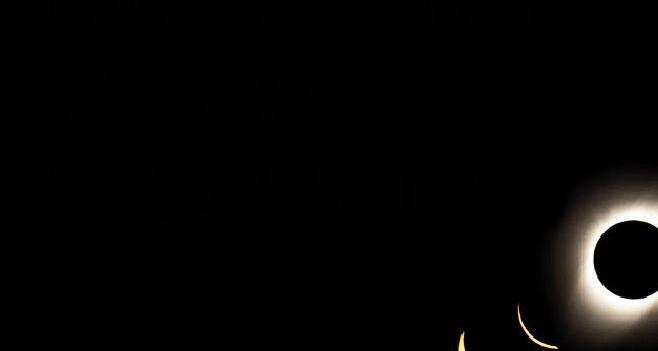


















INDUSTRY NEWS • PRODUCT NEWS • ASTRO HUTECH HINODE SOLAR GUIDER MAKING THE MOST OF THE UPCOMING 2023 AND 2024 SOLAR ECLIPSES SOLAR SNAP SMART PHONE IMAGER Your Complete Guide to Solar Astronomy Equipment Volume 1 Issue 1 $6.00 US
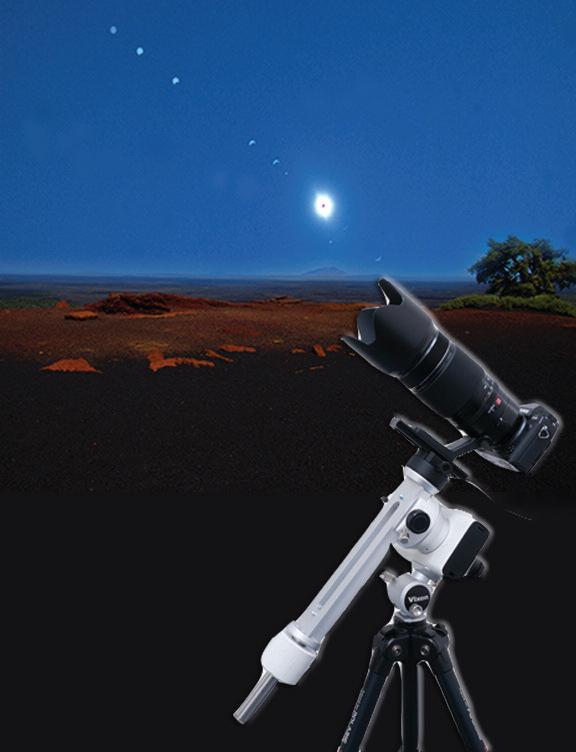


Cover Article - Page 47
Shown on the cover is a solar ready G a l i l e o s c o p e t e l e s c o p e w i t h s a f e solar filter and sun shade. In his article, Dr. Douglas Arion provides an over view of the Galileoscope’s new solar functionality. The background e c l i p s e i m a g e i s c o u r t e s y o f D r James Dire (see his eeclipse planning a r t i c l e i n t h i s i s s u e ) T h e i m a g e features all the phases of the July 2, 2 0 1 9 e c l i p s e w h o s e p a t h o n l y crossed land in Chile and Argentina.

In This Issue
43 GALILEOSCOPE TELESCOPE KITS WITH SOLAR FILTERS

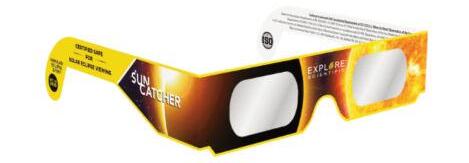
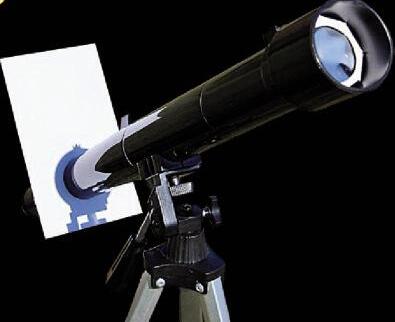
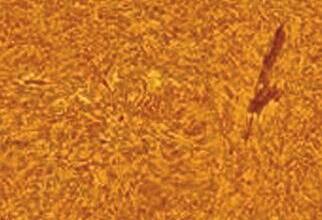
The Galileoscope enables kids of all ages (adults included) to build and obser ve with a telescope similar to (but much better than)
Galileo’s. With the new solar filters, a Galileoscope can now be used to study the Sun ever y day – and especially for the two eclipses coming up soon!
 by Douglas Arion, PhD
by Douglas Arion, PhD
In This Issue
71 THE ASTRO HUTECH HINODE SOLAR GUIDER
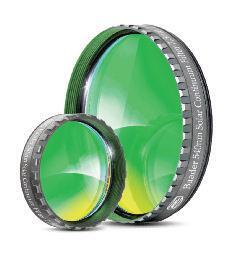
The Hinode Solar Guider from Astro Hutech has turned out to be one of my favorite astronomy tools. It has eliminated all of the controllable sources of frustration from my solar imaging workflow by Austin Grant
81 SOLAR SNAP
Solar

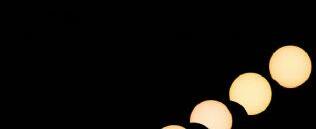









55 MAKING
THE MOST OF THE UPCOMING 2023 AND 2024 SOLAR ECLIPSES

I have travelled around the globe to see myriad solar eclipses over the course of my life. These include five continents and countries such as China, Iceland, Turkey, and Zambia, and tropical islands such as Aruba and Hawaii (the official name of the Big Island) It goes without saying that I have a lot of experience planning these trips and knowing what typically goes right and what can go wrong.
by Dr. James Dire
Safe and innovative, the Solar Snap kit has everything you need to easily photograph an eclipse. Download the provided app, attach the solar filter to your phone and you are ready to capture some eclipse magic by Bradley Worrell
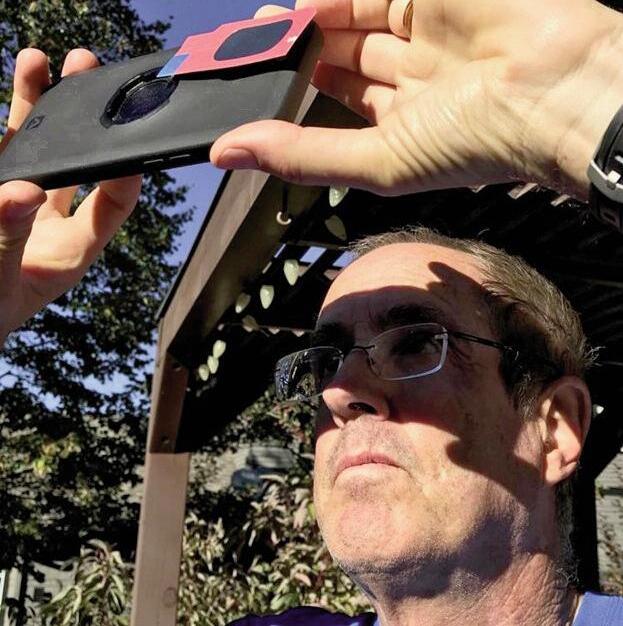
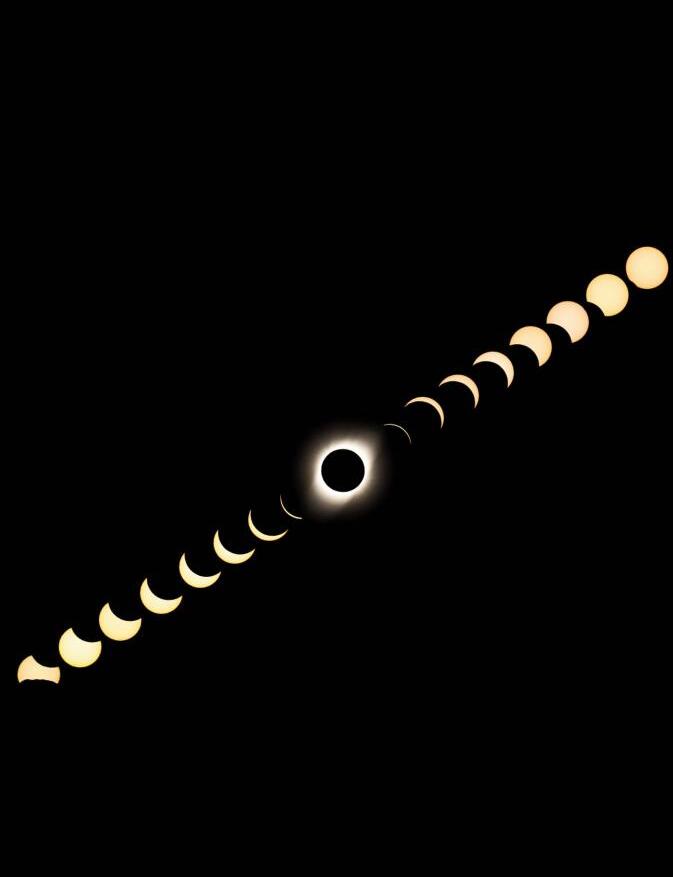
Astronomy
BAADER Solar Continuum Filter
ROYAL ASTRONOMICAL SOCIETY OF CANADA Solar Observer's Handbook
EXPLORE SCIENTIFIC Sun Catcher Solar Eclipse Glasses
ALTAIR Solar Wedge Version 2 18 APM TSE17 A4 Solar Filter Film
SKY-WATCHER SolarQuest Mount for Solar Telescopes
MALLINCAM SolarCam Video Imager Telescopes
KENDRICK ASTRO Solar Filters With Built-In Sunfinder 24 DAYSTAR FlatCap Imaging Diffuser
LUNT 40mm Solar Telescope Contents
Products/News 10
12
14
16
18
20
22
26
GALILEOSCOPE KITS WITH SOLAR FILTERS INDUSTRY NEWS • PRODUCT NEWS • ASTRO HUTECH HINODE SOLAR GUIDER MAKING THE MOST OF THE UPCOMING 2023 AND 2024 SOLAR ECLIPSES SOLAR SNAP SMART PHONE IMAGER Your Complete Guide to Solar Astronomy Equipment Volume 1 Issue 1 $6.00 US Solar Technology Today 3
Contributing Writers



Douglas Arion, PhD is the Executive Director of Mountains of Stars, and is Professor Emeritus of Physics and Astronomy and Donald D. Hedberg Distinguished Professor Emeritus of Entrepreneurial Studies at Carthage College. He is deeply concerned about human impact on the environment, and founded Mountains of Stars to change attitudes and actions of the public by creating ‘environmental awareness from a cosmic perspective’ He co-founded Galileoscope, a worldwide project to provide high quality, low cost telescopes for worldwide promotion of science education and outreach More than 260,000 are now in use in over 110 countries. He was the driving force in the creation of the AMC Maine Woods International Dark Sky Park, which protects over 75000 acres of land in the last dark sky region of the eastern United States.
James Dire has a M.S. degree in physics from the University of Central Florida and M A and Ph D degrees from The Johns Hopkins University, both in planetary science. He has travelled around the globe to see myriad solar eclipses including five continents and countries such as China, Iceland, Turkey, and Zambia, and tropical islands such as Aruba and Hawaii He has been a professor of chemistry, physics and astronomy and an administrator at several colleges and universities. He has played a key role in several observatory projects including the Powell Observatory in Louisburg, KS, which houses a 30-inch (0.75-m) Newtonian; the Naval Academy observatory with an 8-inch (0 20-m) Alvin Clark refractor; and he built the Coast Guard Academy Astronomical Observatory in Stonington, CT, which houses a 20-inch (0.51-m) Ritchey Chrétien Cassegrain. Dire is a seasoned visual observer and veteran astro-imager
Austin Grant is teacher and self-described perpetual hobbyist, experienced in such areas as building computers and repairing arcade equipment Austin stumbled into astronomy several years ago and it soon became his primary interest. Being a child of the digital age, it didn’t take long for him to find digital astro-imaging
Stuart Parkerson has been the publisher of Astronomy Technology Today for the last 17 years offering news and editorial content covering the amateur astronomy products industry. Solar Astronomy Today was launched to help those interested in imaging and viewing the Sun learn about the products and services available.


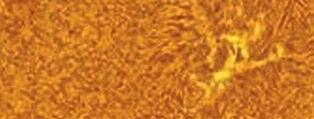

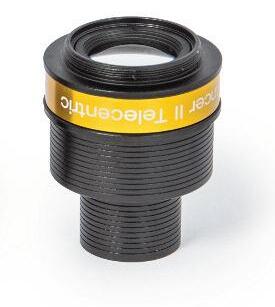
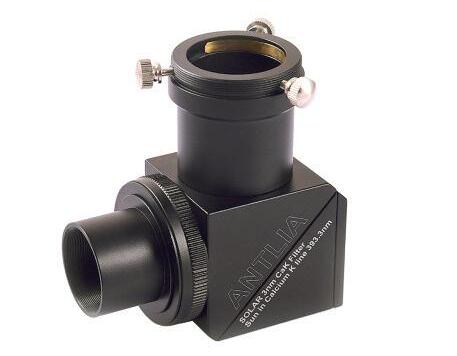

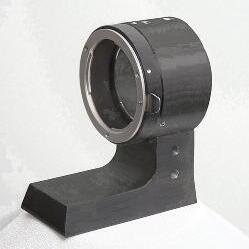
Bradley Worrell is an award-winning editor and writer with significant experience producing quality editorial content across a variety of formats, including magazines, websites, eNewsletters and social media He was the founding editor of RV PRO Magazine and currently works with the University of Colorado Boulder’s “Colorado Arts & Sciences Magazine” which provides news and editorial on in more than 60 fields, including the natural sciences, social sciences and arts and humanities His article in this issue covering the Solar Snap originally appeared on the Colorado Arts & Sciences Magazine website
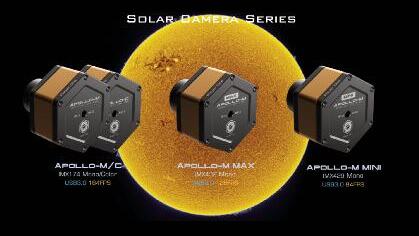
Contents Solar Astronomy Products/News 30 PLAYER ONE Player One Apollo Solar Cameras 32 DAYSTAR FILTERS DayStar Filters 127-QT Solar Telescope 34 DAYSTAR FILTERS QUARK Camera Adapter for Nikon 35 VAONIS Vespera Solar Filter 36 ANTLIA Solar Wedge 38 ALCOR-SYSTEM Continuous Solar Seeing Measurement System 40 BAADER SunDancer II 3x Telecentric System TZ-3S
4 Solar Technology Today
l is mount ingtrack solar tQues olar
e n h t t quipmen r e ou g y lignin t a abou
n G uilt-i d b n r a inde r f ola d s HelioFin
l , a un e S h f t e o ltitud d a n h a zimut a
ou with scinated fa ser ha e c clips r e fo e m h , t self-aligned
to sy ea ridiculously and weight ight
evel y l utomaticall t a Ques olar , S S P orning e m h n t y i arl r e e o efor t b nigh
. O ton ut f a b h o us e p ingl e s h h t it l w
or n f u e S h s t rack d t n s a ocate t l moun
nd e a cienc h s eac o t h s w ducator , e s

ar ts tneares r
featur SolarQest The
es:
nce s
use. e s h s t alculate d c an atented s p t g i Usin y a orr o w d t ee o n N S y-Watcher Sk he T

















nyon r a , o ay e d h g t urin y d tronoms d a





f er s p t i Ques olar . S ime t a t s a our r h e t ec
• ayloa d p 1-poun
• 1
• motorized z Alt-A
• dovetail V-style
tracking apacity d c
t o i d b P Adjustable-heig • o y j -way n 8 Built-i • o a ut d a HelioFin
PS n G - i Built • g y e owere •
un e S h f t g o enterin r c o k f ystic racking d t n t a alignmen
ia h d 25-inc h 1 it d w ripo m t luminu t a h










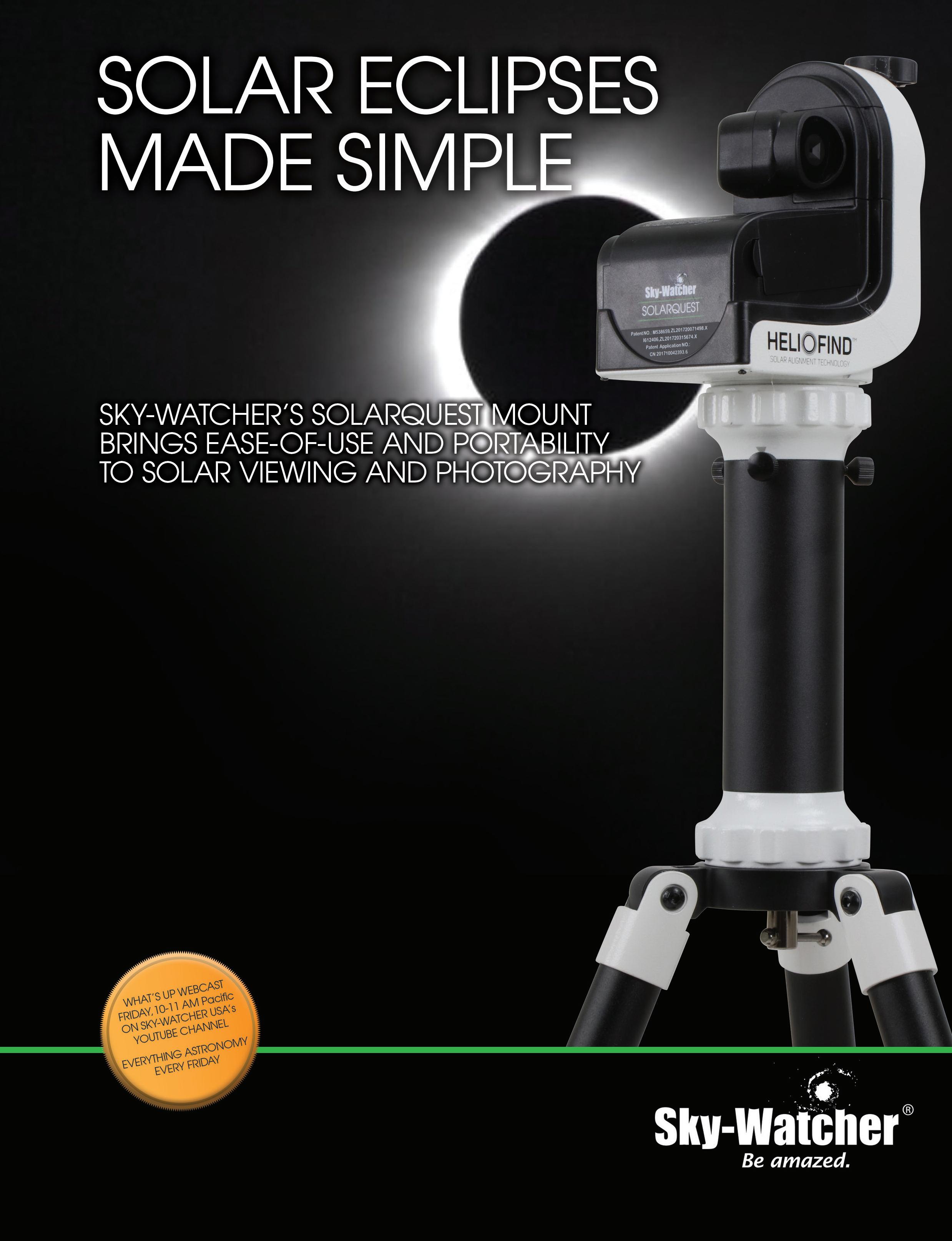
h















































































































































































































o t y t s a t e g i in mak o t M uesQ olar e S h t h e c ou’r r y he the W
d l i d) d l t i ( i tt A b t A
u nc r ) o e u nc no se er a
r s o ttinenon s c os cr s a clipse g e sin a


oa t b . I ompanion t c fec er e p h s t t i un
it e w it n s vatio bser y o n o a t t anspor r
t d 2V d 1 egs r l mete
er ap V a e n,
. toun e m atils er d v n e a abl t or s p hi h t
esig t d ompac d c n t a weigh tigh s a l t s d, yar ack n b r ow ou m y o r g f inplor ex am! agr t ns d I n , a ook a.com us r watche y n a n o matioor nf r i oF r t , o vices er d s n s a t oduc r r p u f o l o al org t f on’D r d y-Watche k d S izehor t u n a d a in o f aceb , F ouTube n Y s o ow u oll o f t t e w.sk w w isit t v us , j ou r y ea r n deale
Publisher
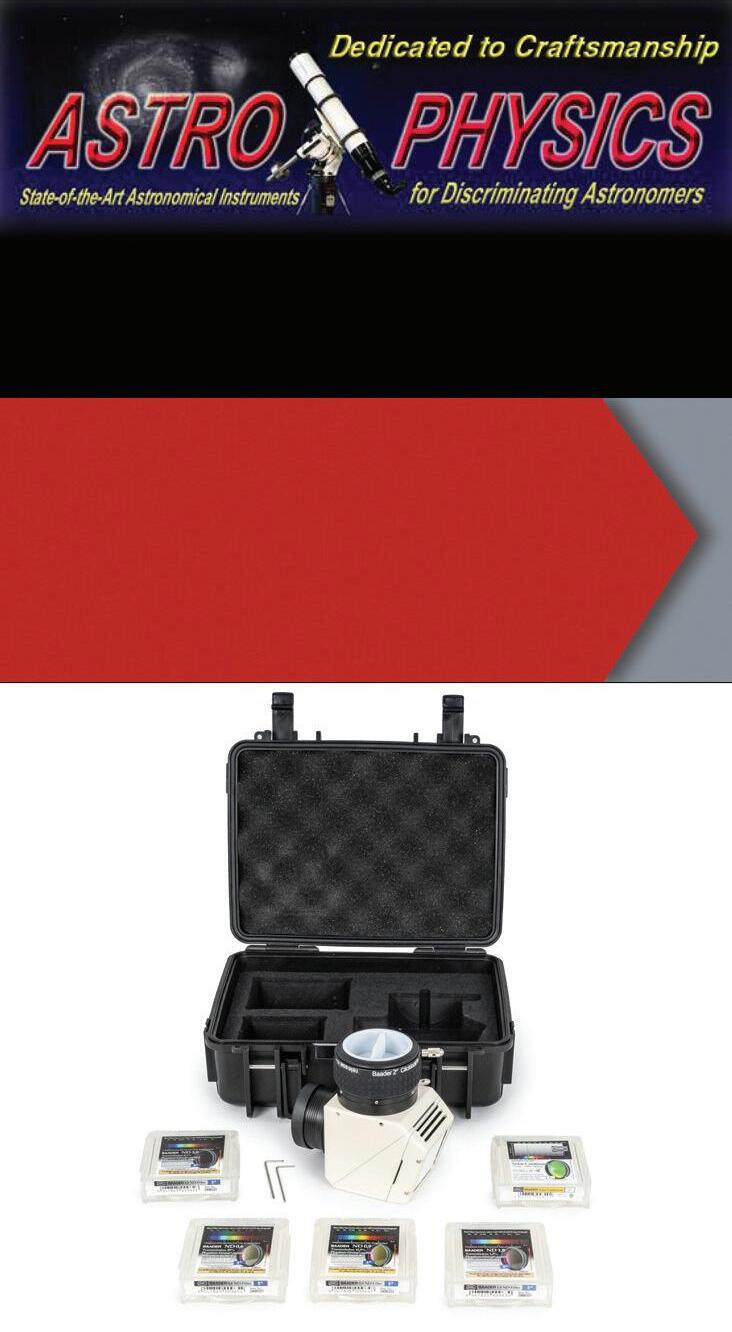 Stuart Parkerson
Art Director
Lance Palmer Web Master
Stuart Parkerson
Art Director
Lance Palmer Web Master
info@solarastronomytoday com

www solarastronomytoday com





Solar Astronomy Today is published bi-monthly by Parkerson Publishing, LLC Bulk rate postage paid at Dallas, Texas, and additional mailing offices ©2023 Parkerson Publishing, LLC, all rights reser ved No part of this publication or its Web site may be reproduced without written permission of Parkerson Publishing, LLC. Solar Astronomy Today assumes no responsibility for the content of the articles, advertisements, or messages reproduced therein, and makes no representation or warranty whatsoever as to the completeness, accuracy, currency, or adequacy of any facts, views, opinions, statements, and recommendations it reproduces Reference to any product, process, publication, or ser vice of any third party by trade name, trademark, manufacturer, or other wise does not constitute or imply the endorsement or recommendation of Solar Astronomy Today The publication welcomes and encourages contributions; however is not responsible for the return of manuscripts and photographs The publication, at the sole discretion of the publisher, reser ves the right to accept or reject any advertising or contributions
For more information contact the publisher at Solar Astronomy Today, 3 Suite 45322, 4727 E Bell Rd , Phoenix, AZ 85032, or e-mail at info@solarastronomytoday com
6 Solar Technology Today
2023 Volume 1 • Issue 1
Bandwise Web Solutions
HIGH QUALITY PRODUCTS TO VIEW AND IMAGE THE SUN Astro-Physics is synonymous with optical quality so you know we are very particular about the solar products that we recommend. www.astro-physics.com • 815-282-1513
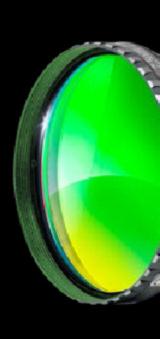
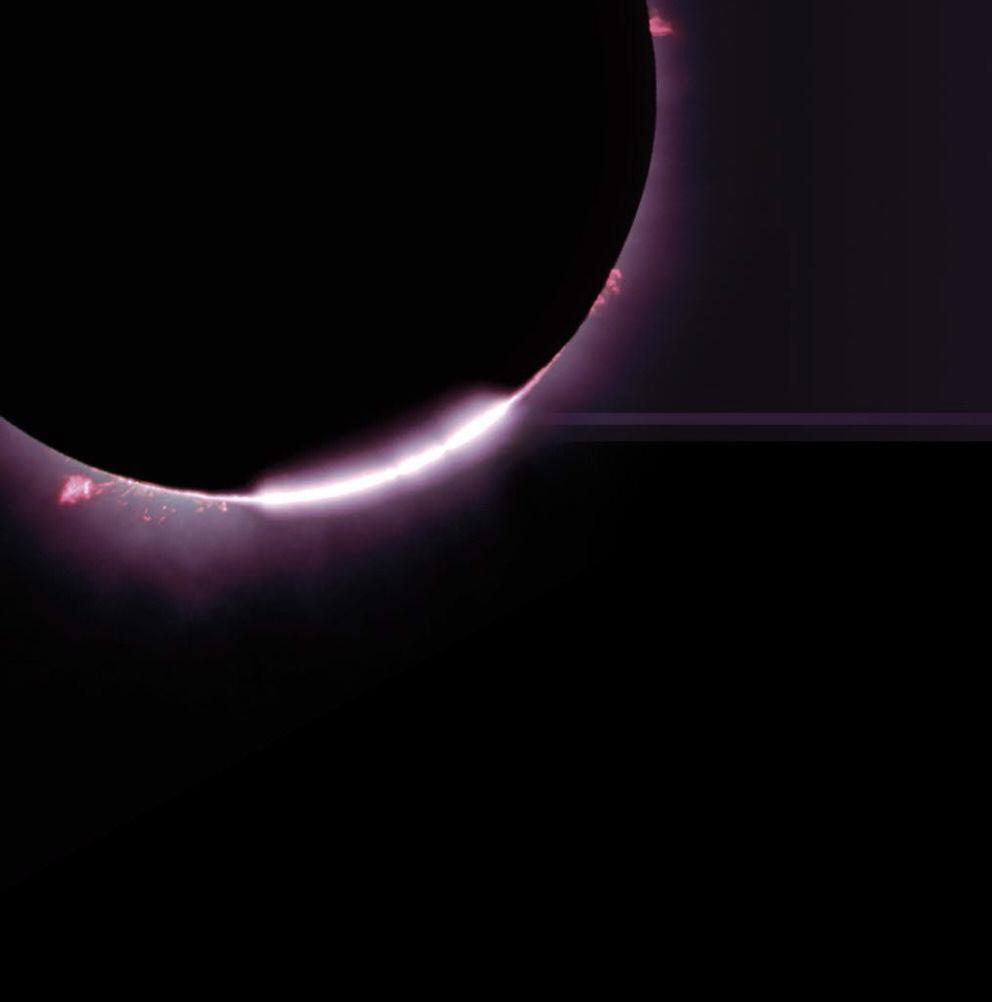




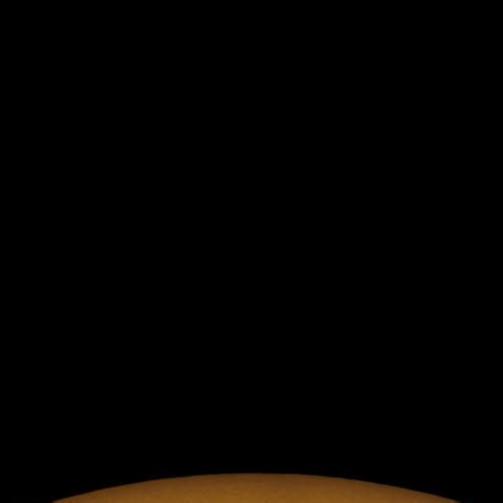
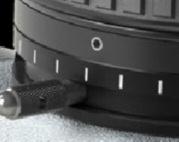
























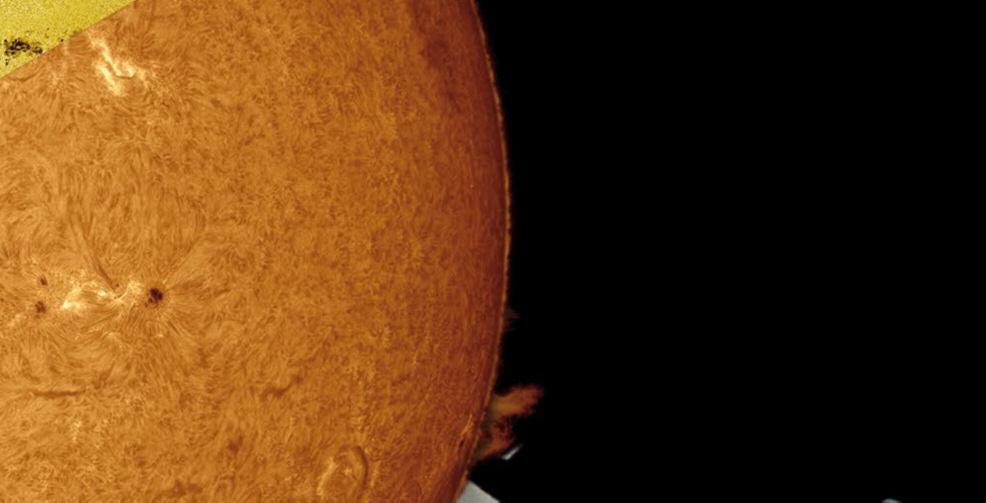
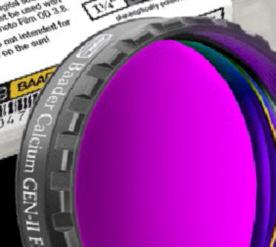


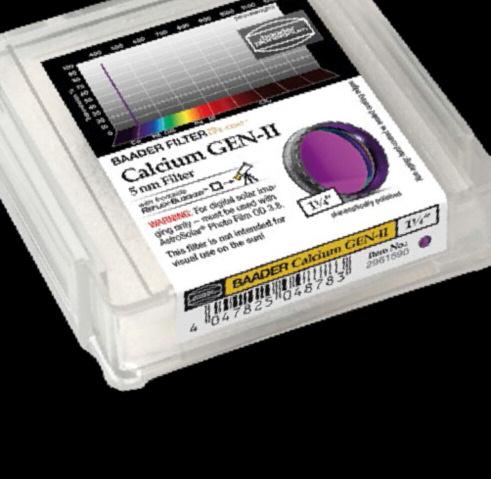


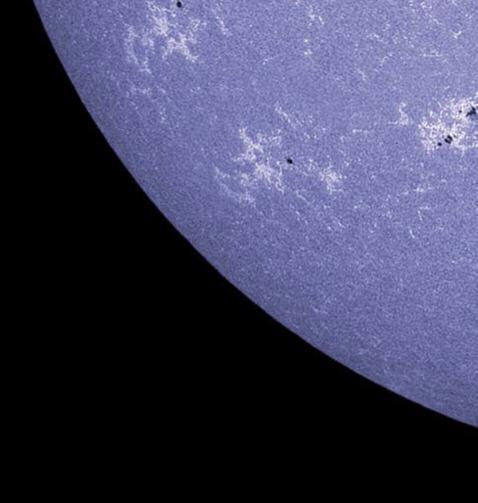

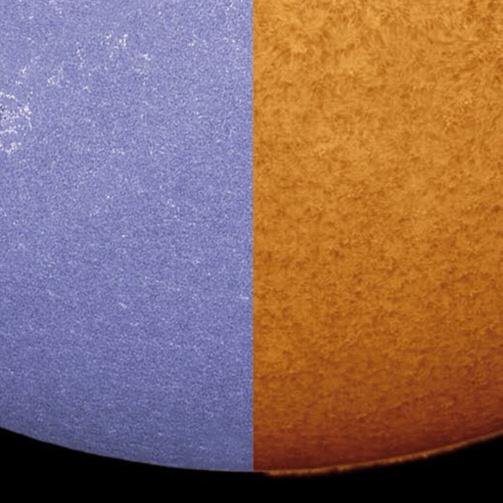


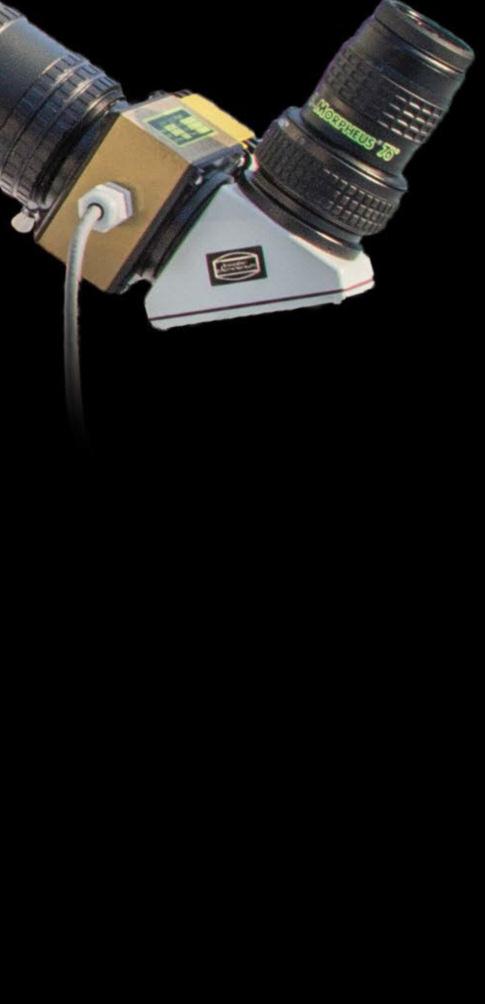
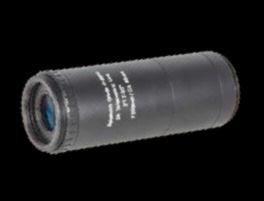






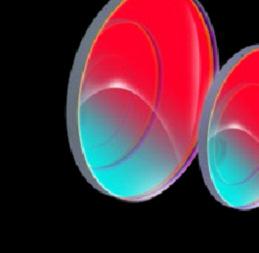







S Solar Continuum 7.5nm Ev e v egin A i d i 5. R E AD A 3.8 OD Film i en c q nse ting 5 BA AS AS S SB As oS F BA GEN II AADER d ol (heating and alph e trum olarS e ting ha g obse t) x / 0.7x a er m oating een p g pho an D GEN-II ing D-ERF Filte w an unsurpassed e for demanding t ems essor 0.4x alpha a m oi eig s www.alpineastro.com/solar r
With the SkyShed POD-S la past zenith view with cente mounted or wedge mounted for solar observation and im Sun is at a higher

ayout, you can go er mounted, offset d telescopes - great maging when the altitude!

BAADER Solar Continuum Filter
The Baader Solar Continuum Filter is a narrowband photosphere filter for solar observation in white light providing the highest contrast in the photosphere of the Sun. The filter is a perfect fit for owners of achromatic refractors. This narrowband filter cuts the spectral range where lens optics draw sharpest and contrastiest. The Baader Solar Continuum Filter lets you use the full power of your telescope.
The Solar Continuum Filter must be used only with additional filtering such as a Baader Herschel prism or Baader AstroSolar Safety Film.
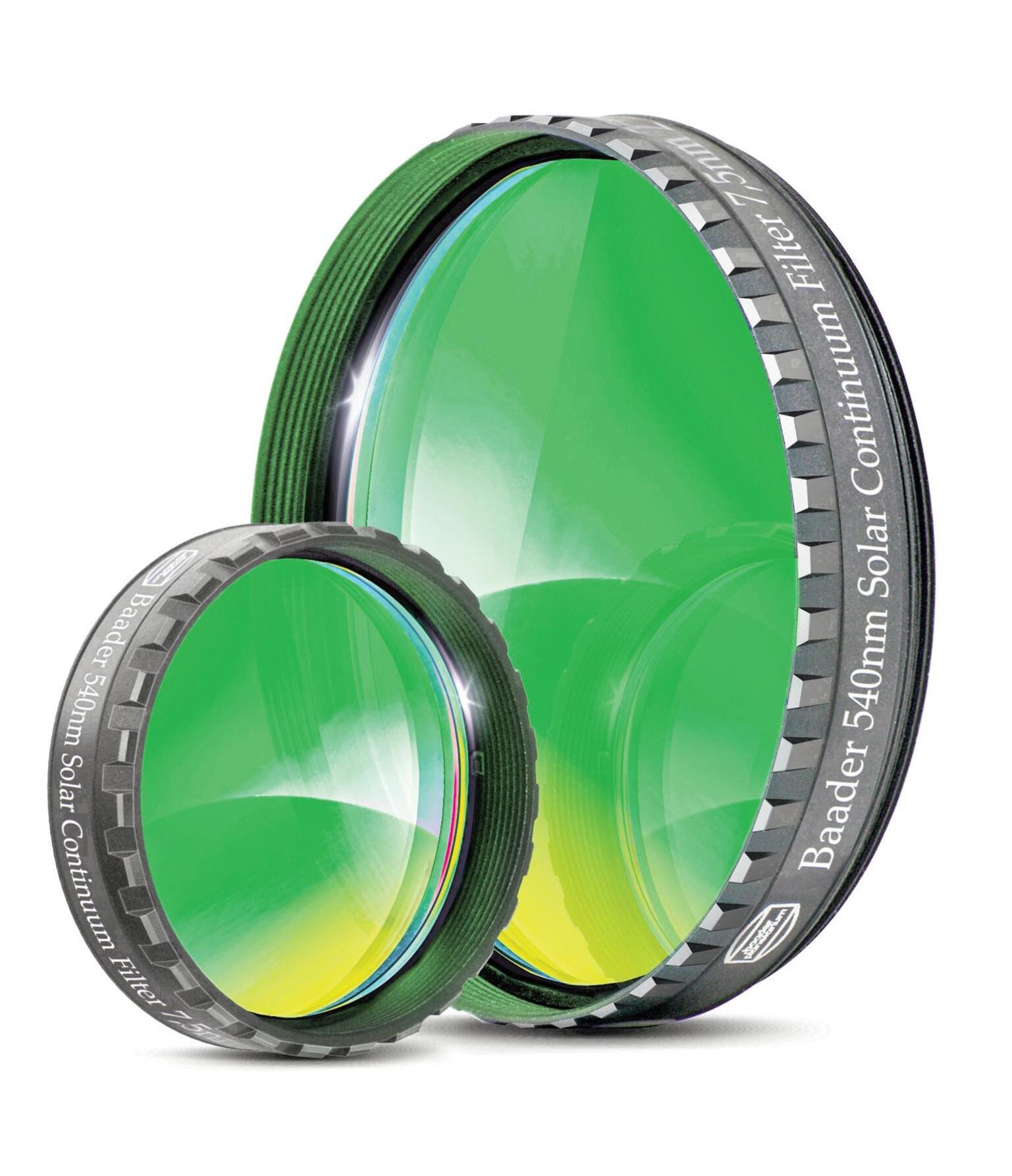
The filter works as a monochromator: suppressing the effects of the atmospheric turbulence and delivering images that are significantly sharp It offers an enormous contrast gain in monochrome photography even on apochromatic systems
Compared to the previous model with a 10nm half-band-width, this filter has a half-band-width of only 7.5nm, which increases the contrast even more. It replaces both the previous Baader 10nm Solar Continuum filter and the stacked 1 ¼" filter. The single filter performs so well that stacking is no longer necessary - the contrast gain of a single 7.5nm filter makes stacking unnecessary and this performance is now also available in 2".
As the Baader team notes, “Lens systems - including those of apochromats, catadiopters or eyepieces - are traditionally optimized for the spectral range around 540nm, since this is where our eye has the highest sensitivity. This narrowband filter therefore blocks everything with the exception of the spectral range in which a lens optic works most
sharply and with the highest contrast
The effect is greatest on achromatic lens telescopes; but there is also an effect on a p o c h r o m a t i c t e l e s c o p e s , c a t a d i o p t r i c systems, and even pure mirror systems by reducing air turbulence.”
As a monochromatic filter, it is ideal for use on monochromatic cameras and can even provide a tremendous gain on pure color systems As the Baader team notes, “With a color camera, as with deep-sky narrow-band photography, it is less effective as only the green pixels are
used Thus, although you still benefit from the improved image sharpness of the telescope that is optimized for green wavelengths (and the reduction of the influences of air turbulence), with a color camera you cannot fully exploit the better image quality compared to monochrome cameras, as you are effectively working with reduced camera resolution ”
The Baader 7.5 nm Solar Continu-
Continued on page 16
SOLAR ASTRONOMY PRODUCTS/NEWS 10 Solar Technology Today
NEW! SQM FEATURE IN CLOUDWATCHER

The newest version of our CloudWatcher cloud detector includes an extremely sensitive light sensor and dichroic UV/IR filter to measure sky brightness in mpsas.
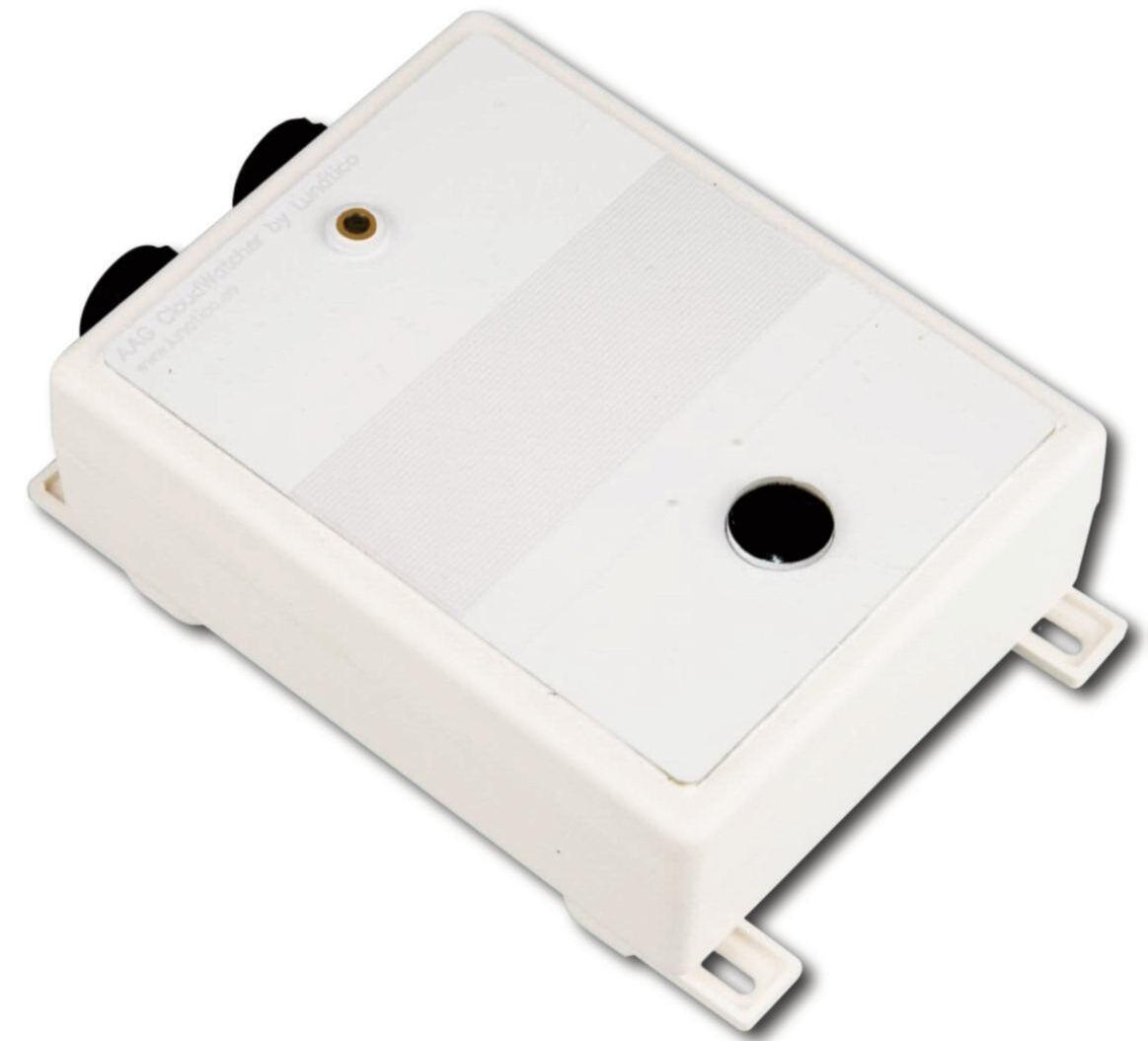
Now, along with providing comprehensive information about the sky conditions (clouds, rain, temperature, relative humidity, dew point, wind and atmospheric pressure), it is the ultimate sky quality detector!

PORTABLE MONITORING
The extremely lightweight and compact Pocket CW2 is a new, improved version o ering a number of updates and enhanced capabilities to provide detailed, on the go information about atmospheric conditions.
It is the best portable solution for cloud detection, measuring sky quality, atmospheric pressure, temperature, relative humidity, dew point, detecting wind, and with GPS location!
BAADER Continued from page 14
um also offers all the advantages of t h e C M O S - o p t i m i z e d B a a d e r f i l t e r line:
• Increased contrast, matched for typical CMOS quantum efficiency and s/n ratio.
• Baader Reflex-Blocker coatings, for largest ever freedom from halos, even under most adverse conditions concerning aux-optics.
• Identical filter thickness to existing standards, with utmost care for parfocality.
• Blackened edges all around, with filter-lead-side-indicator in the form of a black frontside outer rim, to additionally eliminate any
reflection due to light falling onto the edge of a filter.
• Each filter coated individually, with sealed coating edge (not cut out of a larger plate with coatings left exposed).
• Baader Life-Coat evermore hard coatings to enable a non-aging coating for life – even in the most adverse environment
T h e B a a d e r t e a m a d d i t i o n a l l y notes, “For purely visual observation, the Solar Continuum filter must only b e
i t h a n a d d i t i o n a l ND3 filter or alternatively with the AstroSolar Safety Film (ND 5.0). The S
installed behind the actual solar filter The combination of AstroSolar photog r a p h i c f i l m ( N D 3 . 8 ) a n d S o l a r Continuum filter or the photographic ND filters of the Herschel wedge must only be used for photographing the Sun at the highest magnifications These must only be used to achieve very short e x p o s u r e t i m e s w i t h a c a m e r a , a n d thus to minimize the influence of air turbulence. AstroSolar photo film (ND 3.8) is also not suitable for mounting directly in front of a camera lens The resulting image brightness is much too high.”
t i n u u m m u s t a l w a y s b e
ROYAL ASTRONOMICAL SOCIETY OF CANADA
Solar Obser ver's Handbook
The Solar Observer's Handbook is for the casual backyard astronomer whose been thinking of doing solar observing but needs to know how to do so safely This guided tour will help you to learn the basics of viewing the closest star to Earth and protect your eyesight while doing so.

It is published by the Royal Astronomical Society of Canada who also publishes other amateur astronomy related publication including the Observer's Handbook 2023 and the 2023 Night Sky Almanac. The 2023 Night Sky Almanac is the ideal resource for both novice and experienced sky watchers in the United States and Canada, with all the advice, information and data that enthusiasts need to understand and enjoy the wonders of the night sky
The Observer's Handbook 2023
has been published annually for over 100 years by the Society and has become a must-have reference book for people interested in astronomy.
The Royal Astronomical Society of Canada also publishes the 2023 Observer's Handbook, an excellent reference book for people interested in astronomy; the 2023 Observer's Calendar which features a spectacular array of Astro-images taken by amateur astronomers and the 2023 Night Sky Almanac, which is an ideal resource for both novice and experienced sky watchers in the United States and Canada, with all the advice, information and data that enthusiasts need to understand and enjoy the wonders of the night sky.
You can learn more about the Solar Observer's Handbook and the other Royal Astronomical Society of Canada publications at www.rasc.ca.
Y o u c a n l e a r n m o r e a b o u t t h e B a a d e r S o l a r C o n t i n u u m F i l t e r a t www.baader-planetarium.com.
t
e
s c h
e d
o l a r C o n
u s e d i n c o m b i n a
i o n w i t h o u r H
r
e l w
g e w
12 Solar Technology Today SOLAR ASTRONOMY PRODUCTS/NEWS
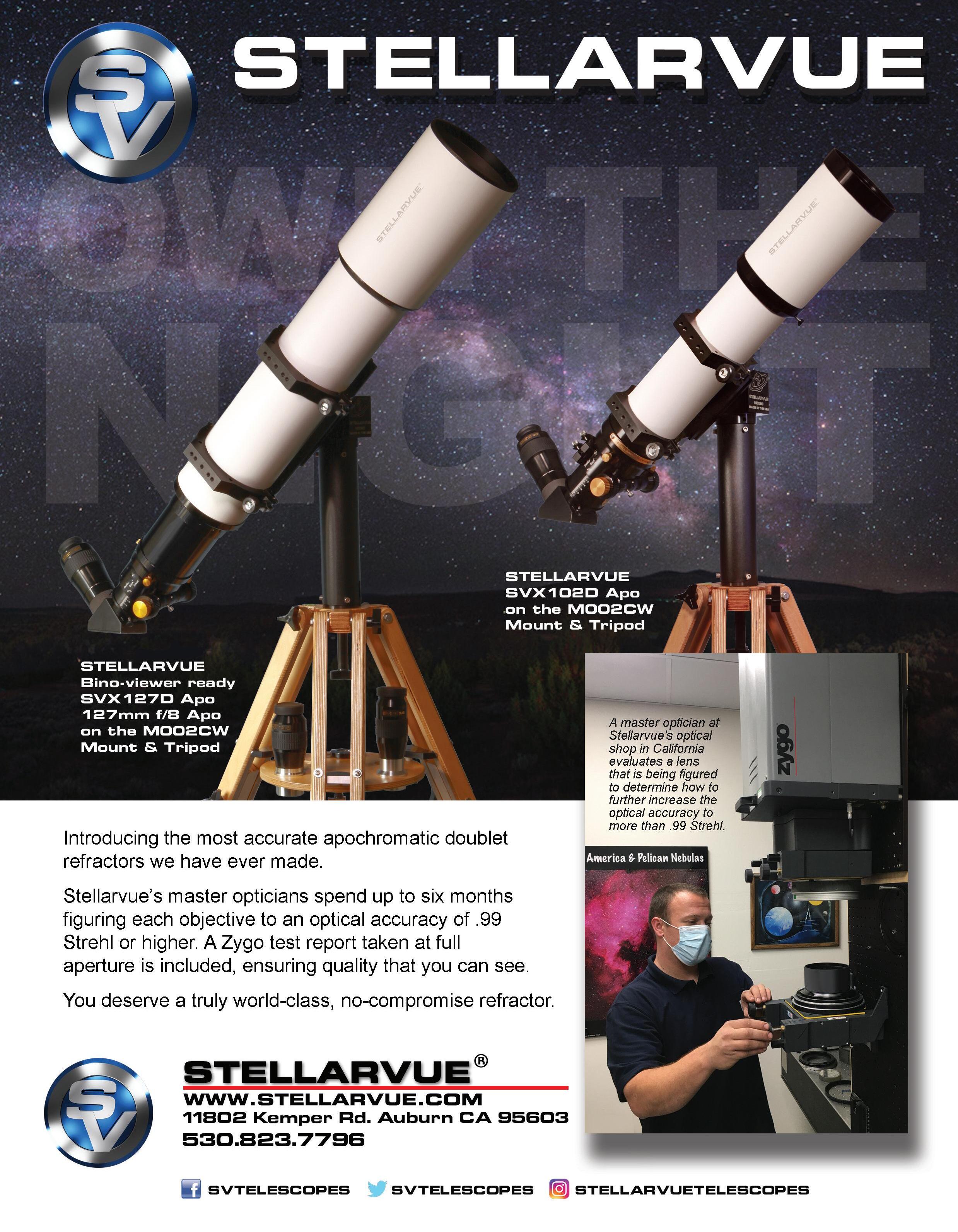
EXPLORE SCIENTIFIC
Sun Catcher Solar Eclipse Glasses
With the new Explore Scientific Sun Catcher Solar Eclipse Glasses you can be ready for the annular solar eclipse on October 14th, 2023 and the April 8, 2024 total solar eclipse. As many people learned, in the weeks approaching the 2017 total solar eclipse, solar safe glasses were in short supply so buying them now and putting them away for the big day is not a bad idea.
These solar safe glasses provide safety, comfort and durability as they are made with an advanced impregnated polymer filter material offering the ultimate in protection and produce a natural yellow-orange solar image The metallic polymer filter material used in these glasses are safety tested to extremely tight requirements.
Encapsulated and laminated in two layers of sturdy chipboard, each eye size of the front of the glasses measures a generous 33.7mm x 44.3mm providing superior eye comfort for viewers ages 8 and up Large right and left temples with double matrix scores give adjustment for a good fit and block stray light Attractive design with black and gold printing is provided on the outside with the “Sun Catcher” logo and clear printed instructions for proper use and care on the inside.
ISO12312–2, manufactured by American Paper Optics and approved for direct observation of the Sun. They also meet the Transmission Requirements of EN 1836:2005 + A1:2007 (E) for an E15 Filter for the Direct Observation of the Sun; The Transmission Requirements of AS/NZS 1338.1:2012, Filters for Eye Protectors; and are in compliance with EU PPE Regulations 2016/425 - EU Type Examination by CCQS
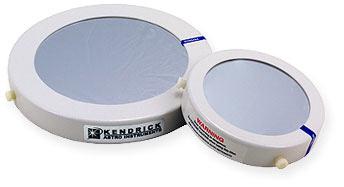

Certification Services Ltd

The Explore Scientific Sun Catcher Solar Eclipse Glasses are sold in a 4-Pack assortment You can learn more at www.explorescientific.com.
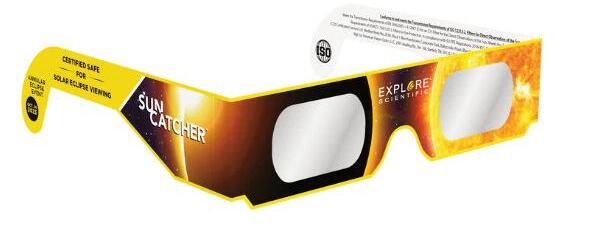
endrick Astro is y K Kendrick
ers with t ar r headqu our sola
rs plus cula nd bino es a elescop ers for t al lt visu
endrick Astro delivvers K Kendrick deliv oo!
er for w wero ers p
h !
uch more! m
der o or made t “ e ers ar olar lt ur S O
org t f for on’ . D ee of dust pristine and fr
e un nders which mak get our S er is our lt t y e tha o ensur t ” ” t r
ering it in ent un and c ting the S loca
e a cinch! epiec our ey n y
ords. er c w wer with fe es where vic our other de y
d d h it's ne i th d
mps of ollers handle 15 A ontr e C DigiFir
ede
er and with 2 DC w f po
er other equ w an po , it c ts or y P Accessor
ollers w ontr ew C e 3 models of D v e ha W
e 8 and igiFir , D -D icro upply - M er S Pow
er y w er and po dapt y A atter our DSLR B
ontroller om the c DSLR fr
dd our 12V USB Hub t A


on anon or Nik our C ust add e 12. J igiFir d D with built-in 8V DSLR oo! t t uipmen
e the nu educ o r
y a 12V Hub? B Wh e. en mor es ev umber of wir
ou ause y ec b? B
p y
en ad e ev W e! e 12V up ther v eady ha alr
ontroller! e C igiFir our D om y ed fr power
y ins eep the Hub dr o k er t t dd a small hea


t an weight , ligh anel is small ur LINX P O



w our po o plug in y es t ou 6 plac es y nd giv
op y t t a o moun his panel is designed t T
elescope! our t
y p es y devic er hungr
14 Solar Technology Today SOLAR ASTRONOMY PRODUCTS/NEWS
T h e S u n C a t c h e r S o l a r E c l i p s e G l a s s e s a r e r a t e d
rder
o O ade t M ilters olar F S
ord anagement and C M
ol! P ontr w C ot Just De
It
anagement T Too! M
ower
N en be an ev .
c ide
e
EclipSmart Solar Filter for 6” Schmidt-Cassegrain Telescopes Custom designed for a safe, secure fit on your telescope’s front end
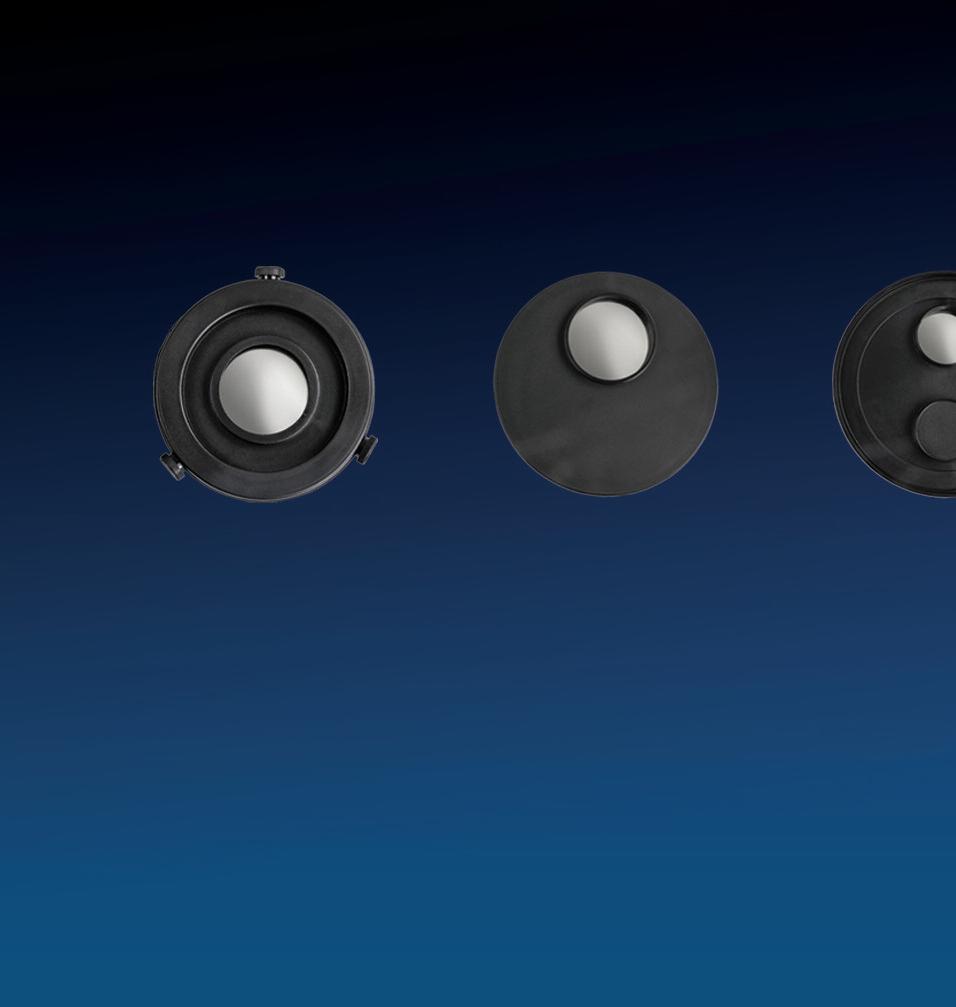
YOUR PERFECT COMBINATION FOR THE 2023 AND 2024 ECLIPSES

Nexstar SE and Eclipsmart Solar Safe Telescope Filters and beyond!


NexStar 6SE
See everything our Solar System has to offer, plus all the best deep-sky objects, like galaxies, nebulae, and more
Two stunning solar eclipses are crisscrossing the continental United States in late 2023 and early 2024. Be ready with a Celestron telescope and a custom-fit, ISO-certified EclipSmart Solar Safe telescope filter. You can enjoy stunning views and photographs of the eclipses, marvel at sunspots any day, and—of course—enjoy the wonder of the night sky for years to come.
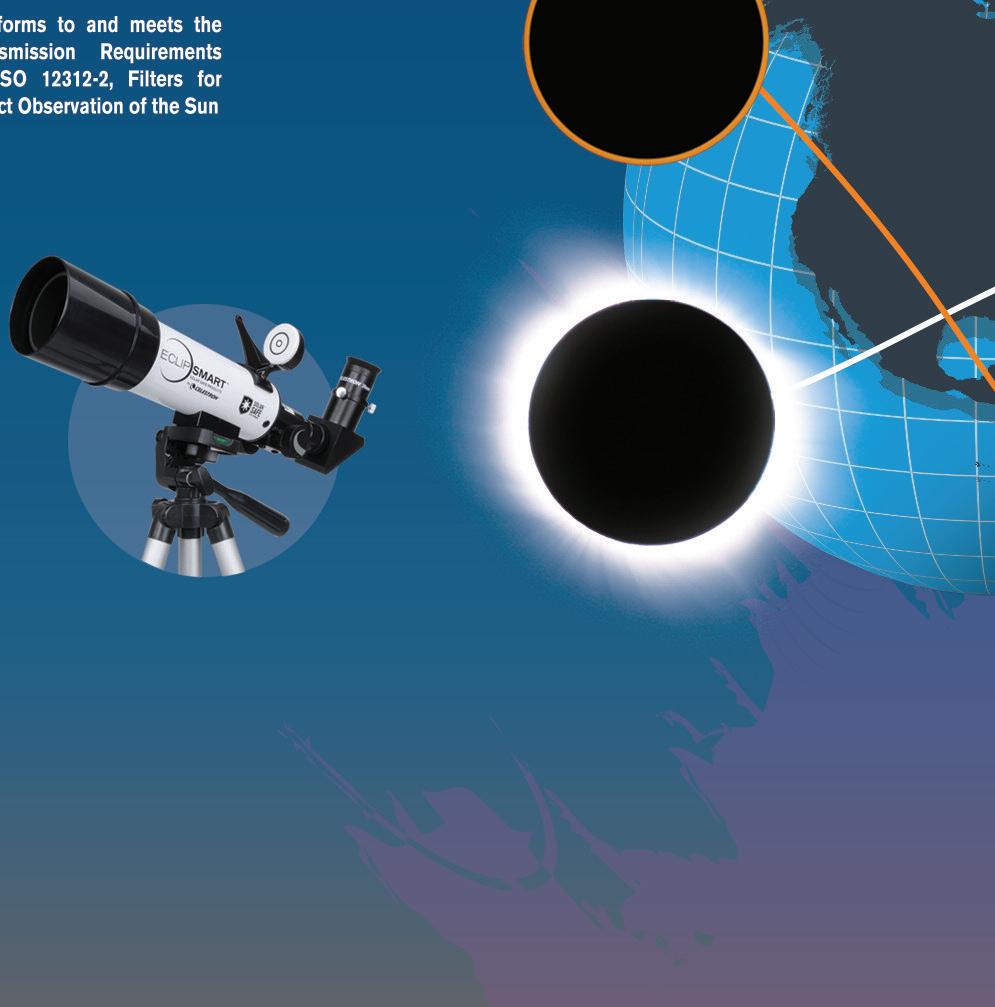

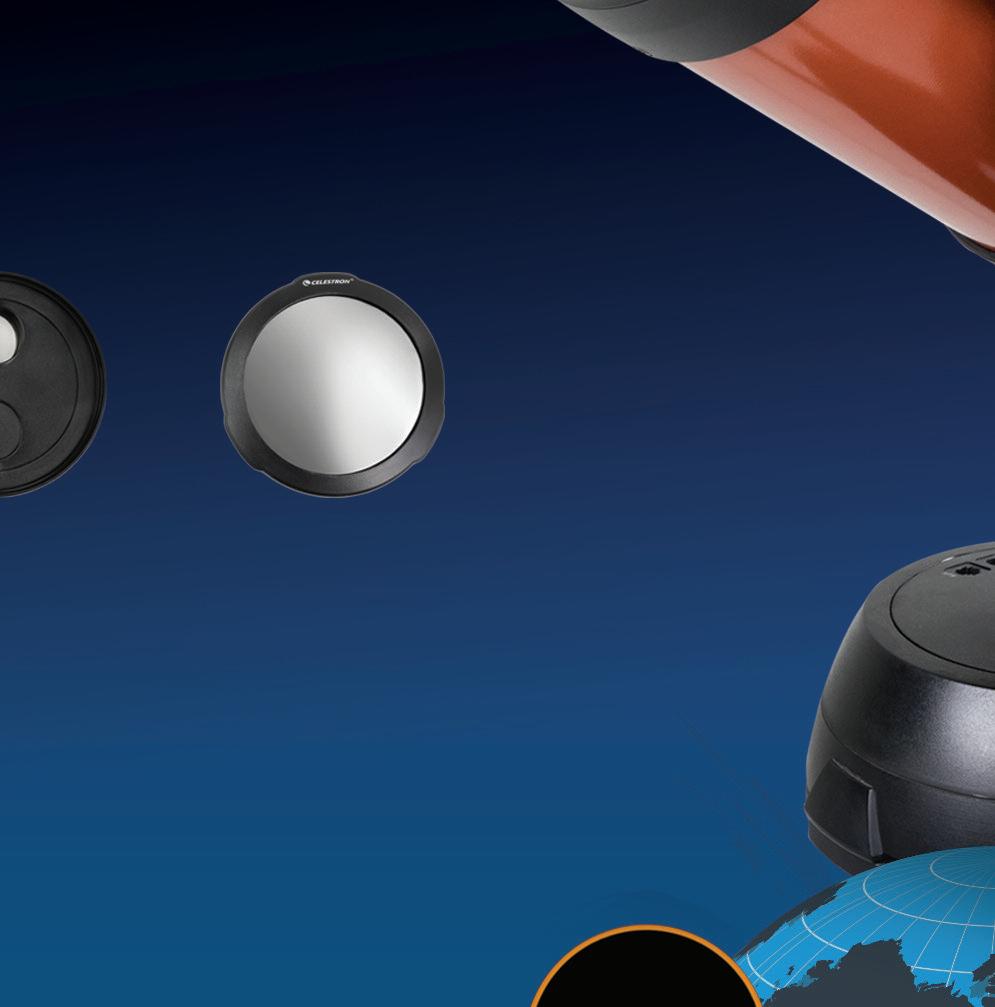
All EclipSmart Solar Safe products are lab-tested and certified to the latest ISO standards for 100% safe solar viewing.
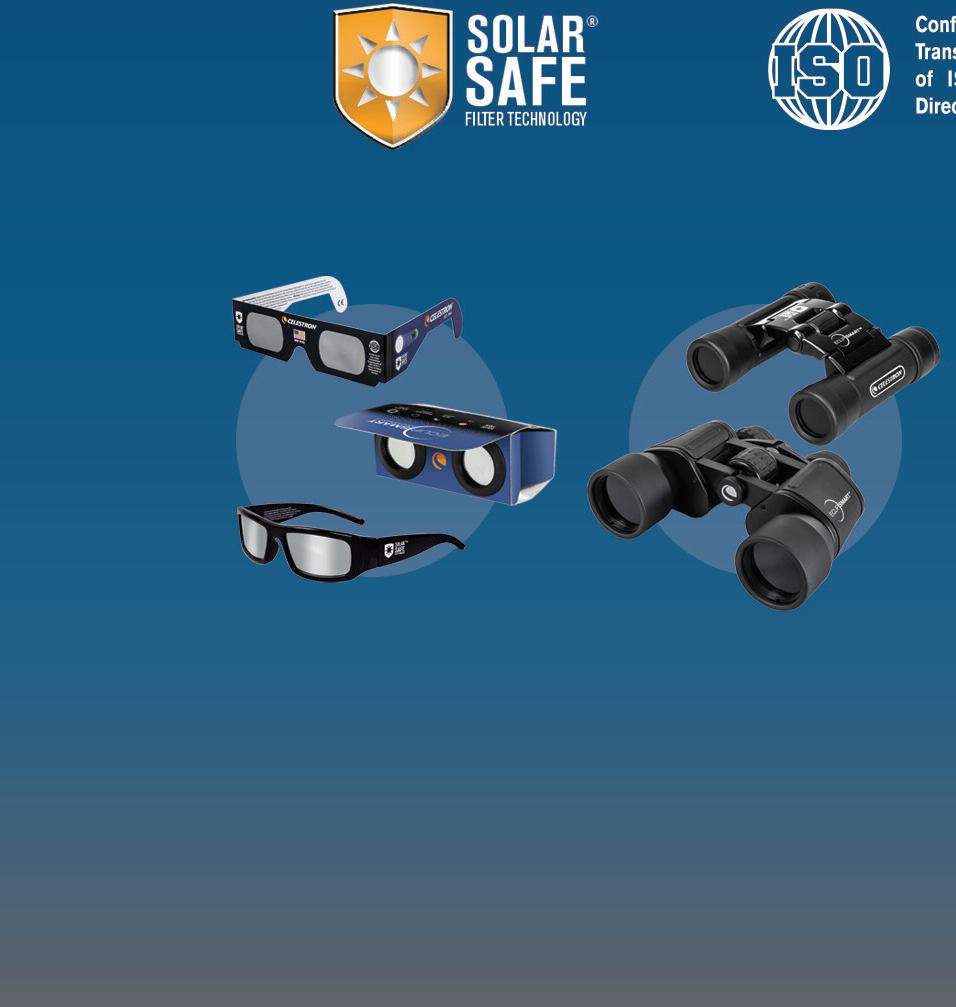
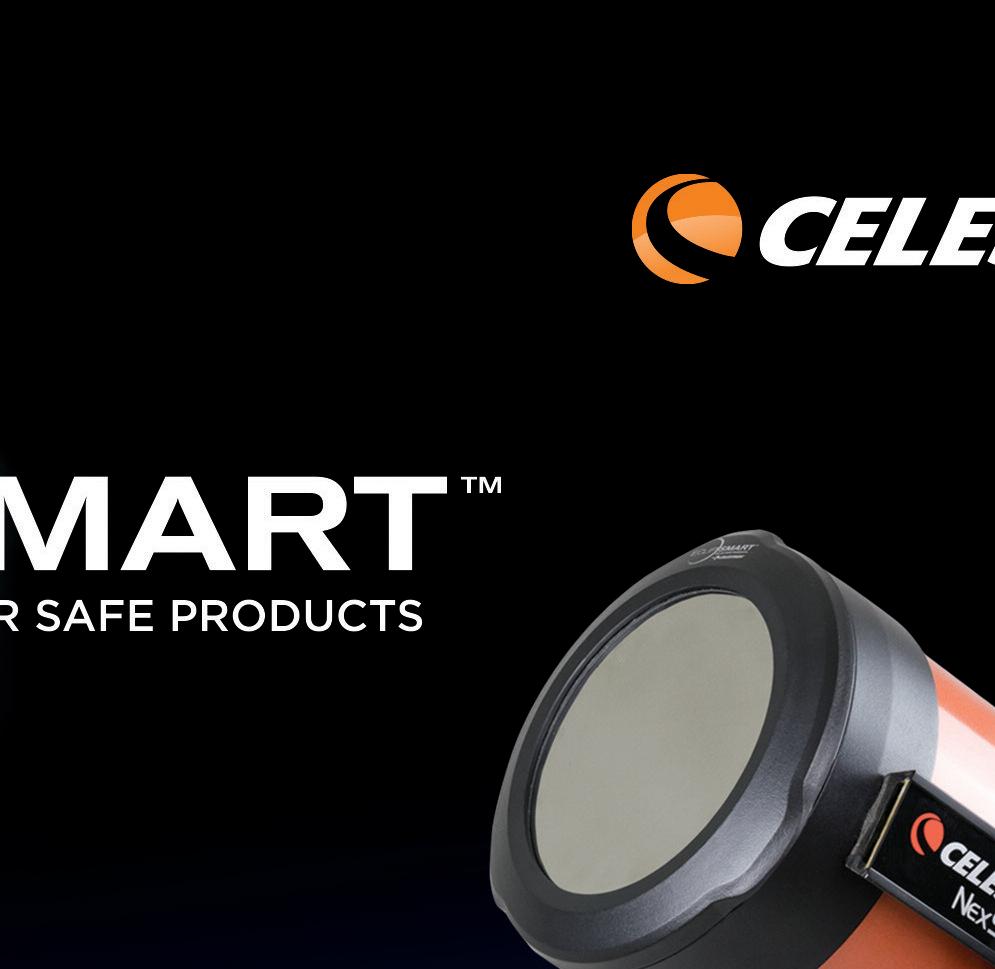
OBSERVE THE
DAY EclipSmart Solar Safe Observing Kits EclipSmart Solar Safe Binoculars EclipSmart Solar Safe Travel Scope 50 See more EclipSmart products and
your
eclipse viewing
celestron.com/eclipsmart B&H Photo – 800.947.9970 – bhphotovideo.com High Point Scientifi c – 800.266.9590 – highpointscientifi c.com Optics Planet – 800.504.5897 – opticsplanet.com Astronomics – 800.422.7876 – astronomics.com OPT Telescopes – 800.483.6287 – optcorp.com Woodland Hills – 888.427.8766 – telescopes.net CELESTRON PREMIER SELECT DEALERS Adorama – 800.223.2500 – adorama.com Focus Camera – 800.221.0828 – focuscamera.com Agena AstroProducts – 562.215.4473 – agenaastro.com APR 08 2024 OCT 14 2023 Annular Solar Eclipse Total Solar Eclipse
SAFELY
SUN ANY
customize
own
experience
ALTAIR
on the internal polarizing filter and prism. A high specification prism gives the ultimate in sharpness and resolution for imaging and observing. The solar wedge is designed to be used only with refractors.
The Altair Solar Wedge Version 2 features include:
• Wide brightness adjustment range allows imaging and visual use
• High quality, large prism
• 115mm backfocus/optical path length enables use with most refractors
• Anti Reflection (AR) coated prism and polariser.
• 46mm clear aperture.
• Quick, easy centering of the sun with glowing spot on rear diffuser.
• Is designed to stay cool thanks to rear energy diffuser.
• 2" "Positive Lock" compression ring for fast accessory changes.
• Includes 2"-1 25" adapter
• Sturdy CNC machined casing to hold heavy binoviewers or a DSLR camera, filter wheel etc
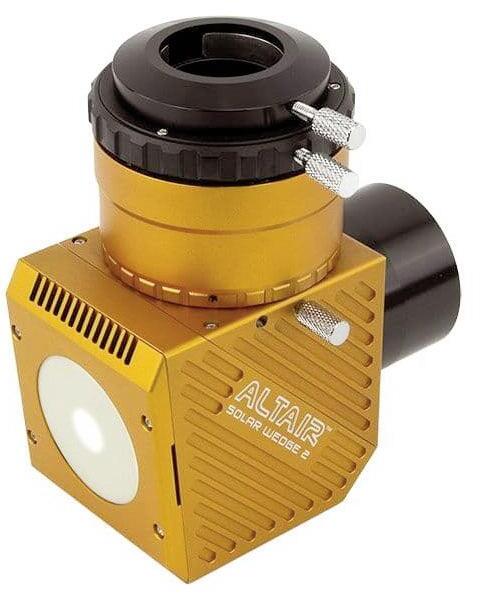
The Altair Solar Wedge Version 2 offers improved cooling for longer use with larger refractors. The Altair Solar Wedge (Herschel Wedge) replaces the normal 2" mirror or prism diagonal at the rear of a refractor telescope. The Solar Wedge transmits a greatly reduced, safe amount of light to the eyepiece or camera.
The Altair Solar Wedge is imaging ready and is safe for both visual use with an eyepiece or astrophotography with a CMOS camera such as the Altair GPCAM or Hypercam The Altair Solar Wedge is "imaging ready" because you can finetune the image brightness without removing your camera to get the best exposure, gain and contrast setting for your CMOS camera.
Solar wedges can provide a sharper, higher-contrast image than traditional metallized solar film or front-mounted glass solar filters by eliminating all reflections between the filter and telescope lens. The result is a sharper, extremely high contrast view of sunspots and solar surface granulation.
The Altair Solar Wedge has special anti-reflection coatings
The Altair Solar Wedge directs energy into a special extra thick Polycrystalline Ceramic diffuser disc at the back of the Wedge. Air vents allow air circulation by convection. The Polycrystalline disc has the added benefit of acting like a "solar finder". The Sun appears as a "ball of light" on the back of the disc. Simply move your telescope until the ball of light is in the center of the disc, and you are aligned with the Sun.
The Altair Solar Wedge provides sufficient light for highspeed exposures needed to "freeze" air-motion for a sharp image The Altair Solar Wedge has an AR coated internal polarizing filter, which lets you control the brightness of the image Brightness can be increased or decreased by rotating the top assembly, then locking it in the desired position with a side thumbscrew.
Variable brightness is important both for visual and imaging use, to fine tune the ideal exposure time, or the ideal contrast levels at the eyepiece - especially when adding a color filter such as a green continuum filter for extra contrast. With the solar wedge in "bright" mode, exposure times as low as 2 milliseconds are possible with high-speed CMOS cameras
You can learn more about the Altair Solar Wedge at www altairastro com
16 Solar Technology Today
ASTRONOMY PRODUCTS/NEWS
Solar Wedge Version 2 SOLAR
D I A YR K S M A
R E
SolarCam – 8.4 Me

e most versatile The
One USB 3 cable operation assembly
sed 8 , 2x2, 3x3, high-grade cable 5-metre- long (16 f 1.25" adapter
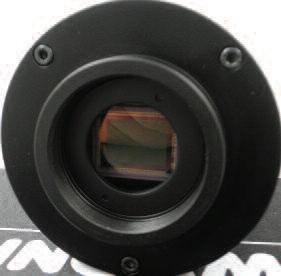

d

s l pixe unit ove pr m y nt a c gn s xe p ga e high with
Features: r hutte s l oba Gl tsbi 12 y lf the on ngi k c ta s vei l te ys s onti a tr sgi e r r ta S s ope c s e l te d ounte m t l a d e zi otor m for l a de I ode m r ggei tr l ulf s ude l nci t uppor S y or m e m ni t- lui B
e r a r n - r a ne e t n ty v t ns e s tio a r e nois to- - l igna s for m z a -
a thod: e m r fe ns a Tr n a c s vei s s e ogr r P t uppor s D H l ul F de a gr cifnti ei c s ns e s d te c e l e s nd- a H ndowwi l a copti d te oa cti ul m d e l a e S
3 x 80 3 ): m ( l xei P ) e blti pa om c 2 B S (U 3 B S U tyviti c onne C

g MOS C ic m a r e c l pixe ga e m tive
s e r high- s r ive l de a r e m a c he T
qu s s e z ut t n a on, g e r t g
n a c s l xepi - l l
1 s s a l c or R I no e r qua s 80 0

32 13 x 6472 (17 4/3" ) m (m e zi S t uppor s 2K 4K i s ny a n, a c s l ul F
3 4: o:ti a r t c pe As
920 845, 16, of r be num l Tota ta s 4 T S ng:diGui
C N C oni si c e pr c numi um l a - l Al ng)i pl m a s

doubl d te a l e r or (c DS C
MOS C l xepi ga e m 3- 16

or ns e s our ol c ci m a r e c
l gona adi m 22m
pi ve
80 379, (16, 3518 x 4656
1 de a r
m 80 3 e r a s ha or s ge a im ution
feet) USB 3 $899.99 28)
ngoppi r c e z : s l xepi ol otoc pr d r nda ngnihi c a m on,ti uc tr ons
C N I L L A M IN AND LIVE UNIVERSE THE SEE
WITH COLOUR
and imaging of the Sun The MallinCam SolarC
to
increased sensitivity
astronomical observa
of astronomical video cameras. It includes
latest Sony Starvis
new MallinCam SolarCam video imager is the newest in the SkyRaider egapixel Cam utilizes a 2.90 - or astronomical observa he Features: trigger mode Support includes full alt-az mounted telescopes Ideal for all motorized for live stacking on the y Star registration system scienti c grade Hand- selected sensor class 1 Full HD Transfer method: all-pixel scan 3864 (H) × 2180 (V) Number of e ective pixels: 12.8mm diagonal ing and imaging of solar system objects. most demanding applications in video astronomy, excelling at live observ type and measures 12.8 mm diagonally. The new So e ective square megapixel, ceramic CMOS sensor. T Sun. The MallinCam SolarC n without IR: 2000mv Sensor G sensitivity Video Format: SER and AVI Image Format: FITS, J Sensor gain: variable Connectivity USB 3.0 Passive Fan CooledolarCam is ready for the The sensor is a 1/1/2" d PEG, BMP, PNG to 50x bl Handcrafted electronics precision CNC machining All-aluminum construction, ever created. video/i/imaging camera
i l ifi i ty ope c s e l te l l a ing us n e s wne he T or. ns e s yR k S m a inC l l Ma he T l i M 16 — C 16 S D Ceramic CMOS sensor 2IMX485LQJ1 Industrial sampling) CDS (correlated double Global shutter Built- in memory Progressive scan, global shutte Flame-Fusion Glass used throu window Sealed multicoated optical f i h i i i i d ge r a l r a ul c ta c pe s e thos for s pe y. l l gona dia m 22m s e ur s a e m or s c ffe e 3 16 a s e iz util 16C DS r ide a er ughout Guiding: ST4 standard protocol throughout Flame-Fusion Glass us 4x4, 5x5, 6x6, 7x7, 8x8 Digital Binning of 1x1, 2x2, 3x3, Full HD i il i d i h i l d ns e s his T . ts c obje l a ic onom tr s a ol
tion
sensor
deliver the
needed for
family
the very
The
ti c fef e of r be um N e 8) : s l xe b ai r va n:i ga or ns e S 1/30s @ v 2413m tyvitii ns e s G or ns e S x 1536 1750, x 2304 on:uti ol s e r ngnnii B p ghhi r upe s s ei r e s coni s na a P : or ns e S S l A thorized US and 20x to e l : 1168 3506, x 4640 e nc a m for r e on covi ci Ma v y bl m e s s a c e l e d tef a r ndc a H e bl a c 3 B S U One 3 B S U umi m e pr (16 ong l - e tr e m 5LIVE UNIVERSE THE SEE MallinCam s coni tr onti a r ope $999.99 e bl a c t) e fe 985-445-5063 River, LA 70452 8388 Pine Street COLOUR IN AND m.com Pearl 38 Observational System MallinCam Video CCD International Distributor Sole Authorized
The APM TSE17 A4 Solar Filter Film is 100% certified as safe for solar viewing and complies with the DIN ISO 12312-2: 2015 standard.
It is suitable for making your own solar filters for telescopes, binoculars, cameras and other solar viewing opportunities. It provides a very natural, comfortable, yellow-orangish solar image with a consistent brightness and neutral density with any aperture. The Solar Filter Film offers an extremely flat surface with no wrinkles or creases and is very lightweight so it doesn’t cause balance issues. and is very. The polymer material is hardy and resistant to damage.
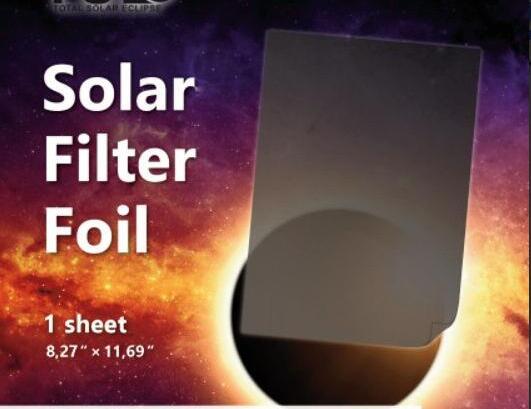
You can learn more about the APM TSE17 A4 Solar Filter Film at www apm-telescopes net
SKY-WATCHER
SolarQuest Mount for Solar Telescopes
T h e S k y - W a t c h e r S o l a r Q u e s t offers a highly portable and easy to use mount for solar observers and eclipse chasers. You no longer need to worry about aligning your equipment the night before or the early morning. The SolarQuest mount is designed to automatically align itself to the Sun with only the press of a button.
A d d y o u r f a v o r i t e s o l a r - r e a d y optics to the mount, press the power button and let the mount do the rest Once powered on, the mount will auto-level the telescope and locate a signal with its built-in GPS. After the location is found the mount will locate the Sun using the on-board Heliofind sensor and find the Sun automatically. After the mount is on target you can smoothly adjust the position using the built-in joystick The mount will then continue to track the Sun
T h e S o l a r Q u e s t , w i t h i t s 1 1 pound capacity, is a perfect option for outreach programs, solar enthusiasts
and eclipse chasers It can be paired with an array of dedicated solar telescopes up to 80mm and telephoto lenses.
SolarQuest specifications include:
• Weight Capacity: 11 lbs
• Total weight: 8 9 lbs
• Power: 8 AA batteries (not supplied) or 12V with included adapter plate
• Dovetail: V-style
• Built-in GPS
• Helio-Find technology for auto location of the Sun
• Built-in 8-way joystick for centering of the Sun
• DC servo motors
• Slew Speeds: 16x and 1200x
• 3/8 thread mounting hole
• Adjustable aluminum tripod with accessory tray

• Included tripod extension
You can learn more about the Sky-Watcher SolarQuest at www.skywatcherusa.com.
18 Solar Technology Today SOLAR ASTRONOMY PRODUCTS/NEWS
APM TSE17 A4 Solar Filter Film
Scopestuff is your primary source for all of the stuff you need for a great observing experience! Most orders ship the same day and prices include shipping in the USA! Our website includes hundreds of items including:



SOLAR OBSERVING STUFFLASER STUFFEYEPIECES
GET READY FOR THE SOLAR ECLIPSE! SOLAR FILTERS, FILTER MATERIAL, SOLAR AND MORE.
FINDERS,
POINTERS
FILTERSVISUAL ACCESSORIESVISUAL ADAPTERS
INDIVIDUAL FILTERS, COMPLETE SETS, ADAPTERS, CASES AND MORE!

DIAGONALS, FOCAL REDUCERS, FINDER SCOPES, RED DOT FINDERS AND MORE!
BARREL EXTENSIONS AND ADAPTERS, T-ADAPTERS, EXTENSION TUBES, ADAPTER RINGS AND MORE!

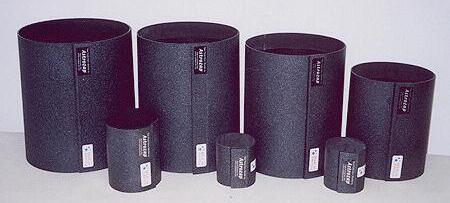

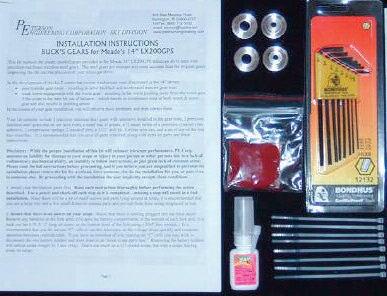
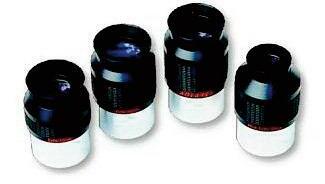
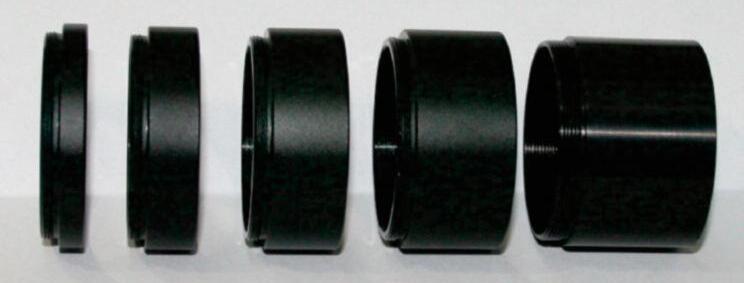
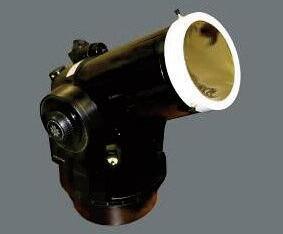
RINGS, RAILS, DOVETAILS, WEIGHTSDEW AND HEATING STUFFOBSERVING AIDS
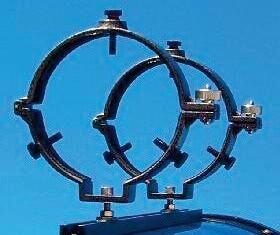
MOUNTING KITS, BALANCE KITS, CRADLE RINGS, RING PADDING AND MORE!

ATM, UPGRADES AND MAINTENANCECOLLIMATION STUFFTHREADED THINGS
BEARING KITS, ADHESIVE BACKING, PTFE PADS, CLUTCH KITS, TUNE-UP KITS, GREASE, AND MORE! ARTIFICIAL STARS, CHESHIRE COLLIMATORS, COLLIMATING EYEPIECES, COLLIMATION THUMBSCREWS, AND MORE!
THUMBSCREWS, KNOBS, BOLTS, WINGNUTS, WASHERS AND MORE!
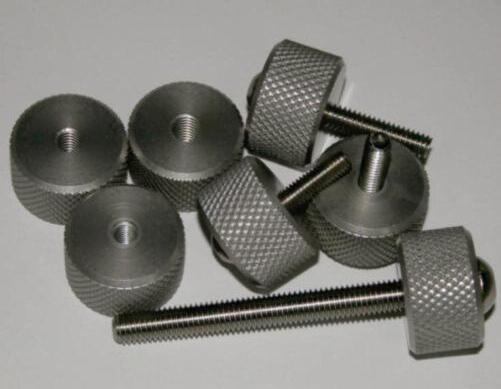
CAPS AND CASES12 VOLT STUFFTELESCOPE INTERFACE AND ELECTRONICS

BARREL CAPS AND PLUGS , EYEPIECE COVERS, EYECUPS, ALUMINUM HARD CASES, SOFT CASES, DUSTS CAPS AND MORE!
POWER SUPPLIES, CABLES, CONVERTERS, ADAPTERS, AND MORE!

TELEPHONE 512-259-9778
www.scopestuff.com EMAIL Support@scopestuff.com
WEBSITE
www.scopestuff.com • 512-259-9778
FLASHLIGHTS,
AND MORE!
BARLOWS, T-THREAD SYSTEMS AND YES –LOTS OF EYEPIECES!
DEW REMOVAL, DEW SHIELDS, SHROUDS AND MORE! BOOKS, CHARTS, CHAIRS, TRAYS, AND MORE!
REPAIR KITS, CABLES, MOTORS, AND MORE!
The MallinCam SolarCam video imager is the newest in the MallinCam SkyRaider family of astronomical video cameras. It includes the very latest Sony Starvis sensor to deliver the increased sensitivity needed for astronomical observation and imaging of the Sun.
The new SolarCam is ready for the most demanding applications in video astronomy, excelling at live observing and imaging of the Sun and solar system objects. The MallinCam SolarCam is the most versatile video/imaging camera ever created for computer use All solar system targets can be observed live while images are captured or while video is recorded simultaneously
The MallinCam SolarCam utilizes a 2 90 effective square megapixel, ceramic CMOS sensor. The sensor is a 1/1/2" type and measures 12.8 mm diagonally. The camera delivers 8 4 M pixels high resolution images using solar telescope types. An optional standard focal reducer or Barlow can be used to further increase the field of view or increase magnification needed for those spectacular large astronomical objects
The SolarCam does not stop at solar system objects, offering the ability to do deep sky imaging Even though the pixel size is not ideal for deep sky objects, with the ability to bin and apply dark and flat fields, it can still provide amazing captures.
The MallinCam SolarCam features and specifications include:

• IMX485LQJ1 Industrial Ceramic CMOS sensor
• No "Newton Rings"
• Flame-fusion glass used throughout
• Back illuminated Class 1 CMOS sensor
• upport 4K resolution
• Total pixels: 8 5 M pixels
• Active pixels: 8.4 M pixels
• Passive fan cooled
• Free software with free updates
• T Mount to 1.25" C Mount
(Adapter Included)
• With digital binning of 1x1, 2x2, 3x3, 4x4, 5x5, 6x6, 7x7, 8x8
• Star registration system for live stacking on the Fly
• Ideal for all motorized Alt-Az mounted telescopes
• Supports and includes full trigger mode
• Image format: FITS, JPEG, BMP, PNG
• Video format: SER and AVI
• 12 8 mm diagonal
• Number of effective pixels: 3864 (H) × 2180 (V)
• Transfer method: all-pixel scan
• Full HD
• Hand selected sensor Class 1 scientific grade
• Guiding: ST4 protocol
• All aluminum construction, precision CNC machining
• Hand crafted electronics assembly
• 315 grams / 11.10 oz.
• 75 mm length X 68 mm
You can learn about the MallinCam SolarCam at www.mallincam.net.
SOLAR ASTRONOMY PRODUCTS/NEWS 20 Solar Technology Today
MALLINCAM SolarCam Video Imager
Now Designed for POD-S!

KENDRICK ASTRO Solar Filters With Built-In Sunfinder
Kendrick Solar Filters are available in a design that offers a built-in sunfinder making centering the Sun in your eyepiece a snap. The finder target is visible from both the front and back sides of the filter making centering the Sun easy from either end of the telescope Filters attach to the front of the telescope/binoculars/camera lens and clamp onto the outside of the optical tube assembly. Many models of the solar filters are available for most products on the market.
The Kendrick Solar Filters offers filter rims with three tabs
According to the Kendrick team, “The main reason is that many telescopes have dovetails or other attachments that interfere with the proper fitting of a solar filter to the telescope. The filter can be placed onto the scope so that the three thumb screws always firmly attach to the body of the scope As well, the tabs extend down far enough to allow the thumbscrews to connect beyond the bevels found on some dewcaps or the corrector plate rings and tube rings of some telescopes, ensuring a very secure connection to the telescope.”
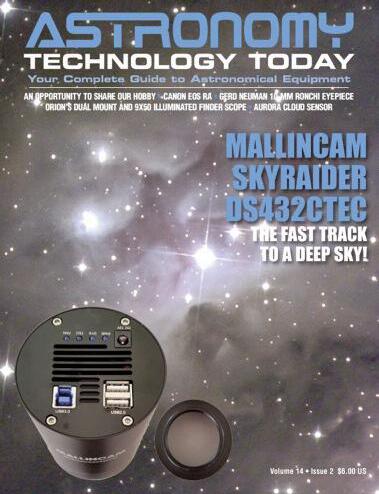
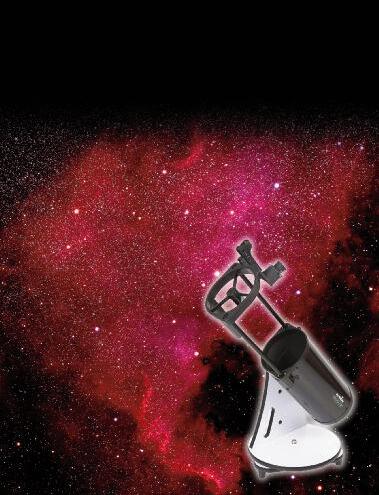
k Solar Filters are constructed of aluminum r Planetarium AstroSolar film. This film has ard for white light filters for their exquisite etail across the entire field of view in an eyevery pleasing and high-resolution image The bluish white The filters are also available in lm.
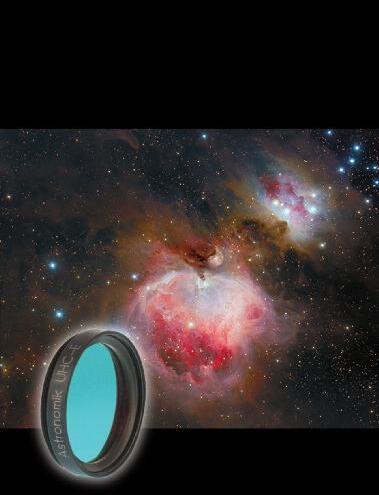
use nylon thumbscrews to secure the filter to cope/lens Nylon is a soft material and will atch the pretty paint job Unlike some "fricfit" system, the fastening system allows the e of a larger frame which increases the clear perture area for unobstructed full field of view
The Kendrick sunfinder is also available as a standalone product. The finder comes with a double-sided adhesive foam tape to easy adhesion to a solar filter ring or other surface.
You can learn more about the Kendrick Solar Filters at online at www.kendrickastro com
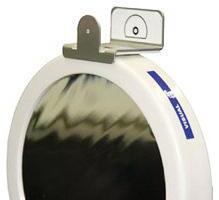
22 Solar Technology Today SOLAR ASTRONOMY PRODUCTS/NEWS
ASTRONOMY TECHNOLOGY TODAY Your Complete Guide to Astronomical Equipment TOO MANY CLOUDS TOO LITTLE CLEAR SKY COAT POCKET ASTRONOMY CELESTRON AVX MOUNT THE TRACK-THE-STARS (TTS-160) PANTHER ALT/AZ MOUNT Volume 14 Issue 9 $6.00 US ASTRONOMIK FILTERS VISUAL ASTRONOMY UNDER THE (LIGHT) DOME ASTRONOMY TECHNOLOGY TODAY Your Complete Guide to Astronomical Equipment Volume 15 • Issue 8 $6.00 US THE SKY-WATCHER USA HERITAGE 150 TABLETOP DOBSONIAN THE SKY-WATCHER USA HERITAGE 150 TABLETOP DOBSONIAN APM/LZOS 115MM F/7 APO THE SOFTWARE BISQUE PARAMOUNT MYT ASTRONOMY TECHNOLOGY TODAY www.astronomytechnologytoday.com Limited Time Offer 2 Years for $9US!






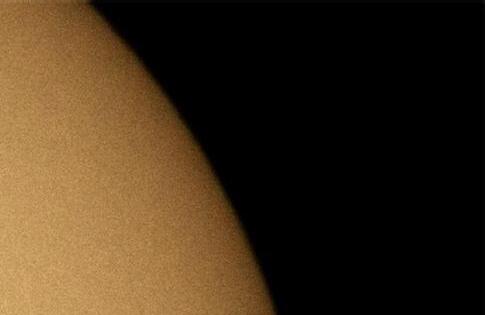


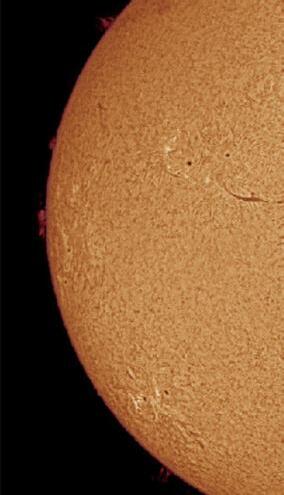


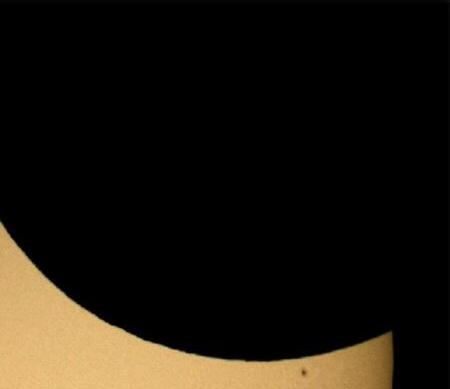
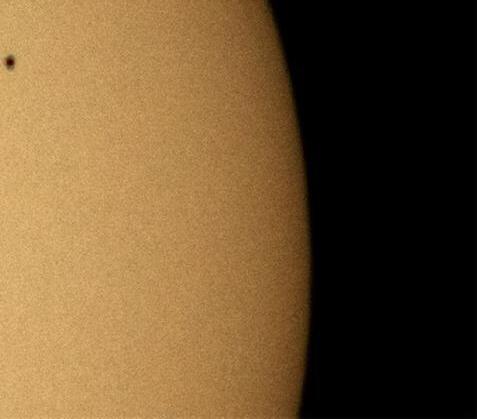





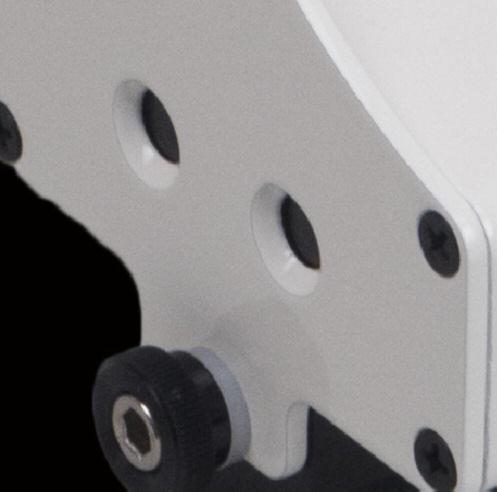


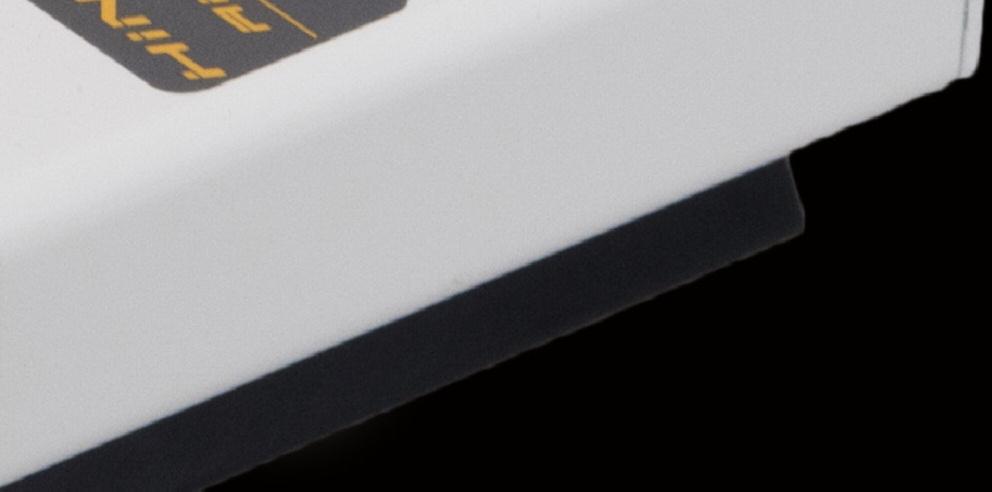


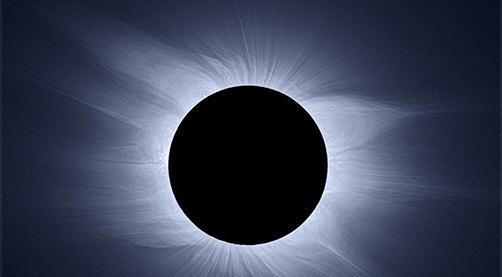

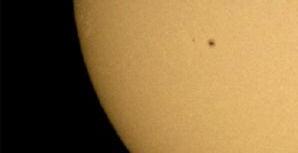
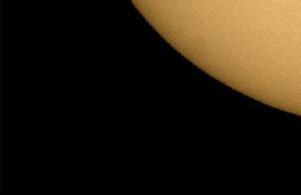

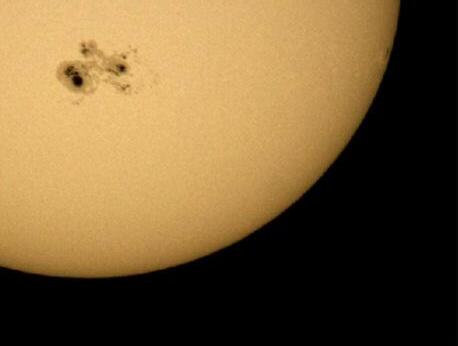



Hinode Solar Guider AKUMI” Spirit with “TTAKUMI” r www.hutech.com w.hutech.com onomy without worrying about losing th astr first autoguider designed for solar viewing , Hinode (” rackerr, (”Sunrise” in Japanese) SG, is the o Hutech Solar T Tracker Astr The the Sun in your telescope! g as well as imaging. Enjoy Solar ”Sunrise”
DAYSTAR
FlatCap Imaging Diffuser
T h e D a y S t a r F l a t C a p I m a g i n g Diffuser is a Gaussian diffuser that is temporarily installed over the front of your telescope when taking flat field reference images.
Taking a Flat field reference image r e m o v e s t h e e f f e c t s o f d u s t s p o t s , v i g n e t t i n g , a n d f i l t e r u n i f o r m i t y . B y strongly blurring the Sun, the only details you will see in the reference image are from defects in your imaging train that can be removed in software Daystar recommends SharpCap imaging software with the FlatCap.
The FlatCap is not a solar filter and is not for use in a concentrated beam. The FlatCap must be the first component to encounter light. As it is a not a solar filter, eye or equipment damage will result unless used in combination with a safe solar filter
or solar telescope T
Diffuser is sold by inside diameter of the mounting cap. Measure the outside diameter of the frontmost component of your telescope or ERF, and then round up to the next larger size. For example, a telescope with a 160mm front should use model FC170, and then optionally install the included felt pads for a secure fit
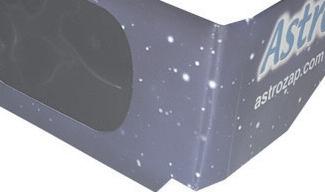
T h e D a y S t a r F l a t C a p I m a g i n g Diffuser specifications include:
• Construction: Spun Aluminum mounting ring with polymer diffuser
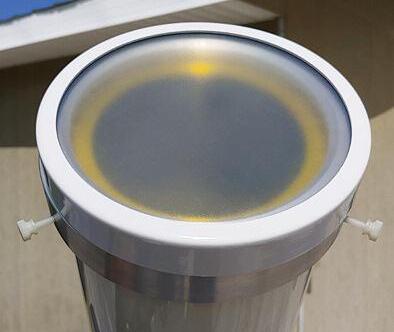
• Intensity distribution: Gaussian
• Divergence angle: 4 degrees FWHM



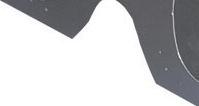



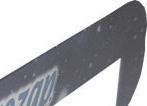


• Exposure time adjustment factor: 100x longer
• Maximum field of view: 1 degree with
Sun backlight
• Wavelength transmission range: 350800nm
• Operating temperature: -10 to 100°C (14-212°F)
You can learn more about the DayStar FlatCap Imaging Diffuser at www.daystarfilters.com.

r G r r G M
AILABLE FROM V VAILABLE 1 – 500 OR MORE! ORDERS A AV
Astrozap glasses are
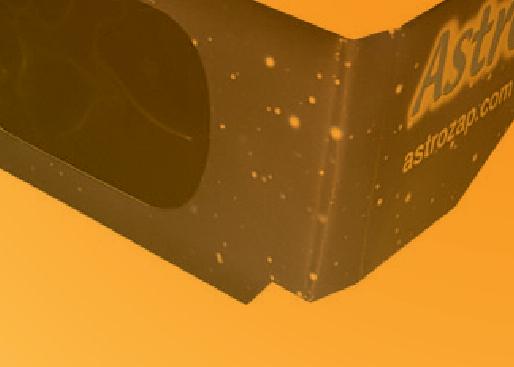

with a natural yellow s intense visible light fo and infrared light, an glasses filter out 100 viewing! Made from p g

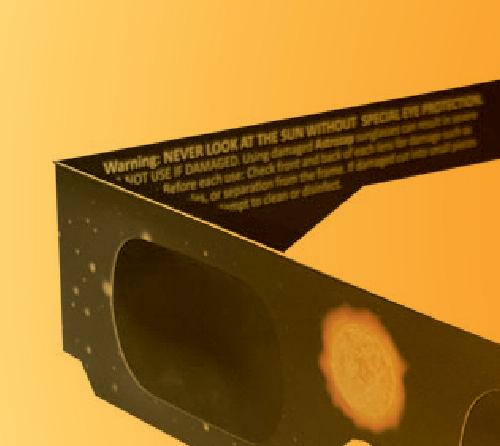
e safe for direct solar
nd filters 99.999% of 0% of har black polymer these TERS FOR AR
wish-orange color image will be sharp or completely safe views













ALSO YOUR HEADQUA Light Shields
Caps
24 Solar Technology Today SOLAR ASTRONOMY PRODUCTS/NEWS
h e D a y S t a r F l a t C a p I m a g i n
g
eadquar olar olar
odu n astr ucts for the moder r

LUNT 40mm Solar Telescope
The Lunt 40mm Solar Telescope is the newest, smallest and most portable of the company ’ s dedicated solar telescope line. This grab and go hydrogen alpha telescope will deliver excellent views for years to come.
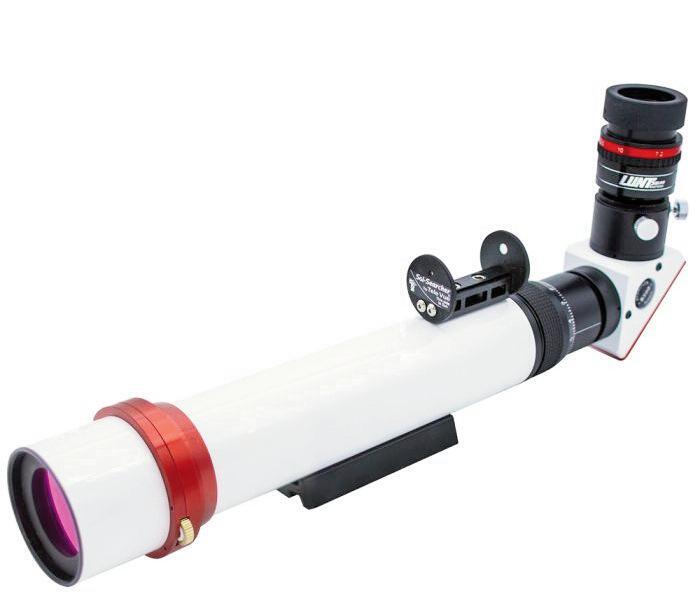
The Lunt 40mm Solar Telescope provides everything needed and more for a first-time introduction to serious solar observing. An easily portable and usable dedicated hydrogen alpha telescope, the Lunt 40mm F/10 system is sure to impress allowing both beginning and seasoned amateur astronomers to experience the amazing phenomena of our closest star
Easily portable and easy to use, the Lunt 40mm joins the Lunt telescope line up as the company ’ s smallest aperture offering, while providing the power, detail and quality you expect from a Lunt Telescope - all in a nice ~4.0mm solar image size.
The Lunt 40mm hydrogen alpha telescope includes a non-rotating helical focuser (upgradeable to a Feather Touch focuser), integrated Vixen style dovetail, and built-in Tele Vue Sol Searcher Sun finder Available blocking filters include B 5 0 0 ( 5 m m ) , t h e B 6 0 0 ( 6 m m ) o r B1200 (12mm).
Specifications include:
• Telescope Type: Dedicated H-alpha
• Universal Capabilities: H-alpha
• Aperture: 40 mm
• Objective Type: Custom Doublet Optimized at 656 nm
• Objective Coating: Ion Assist Ultra-Narrowband AR (656 nm)
• Focal Ratio: F/10
• Focal Length: 400 mm
• Focuser Options: Helical or Feather Touch
• Mounting: Mounting Foot
• Storage: Box with Fitted Foam, Hard Case Optional
• H-alpha Etalon Type: Internal Dedicated
• Etalon Wavelength: 656.28 nm
• Etalon Bandpass: <0 7 Å Single Stack, <0.5 Å Double Stack
• Etalon Material: UV Grade Fused Silica
• Etalon Tuning: Tilt
• Doppler Shifting: Instant
• Blocking Filter Size: 5 mm, 6 mm, 12 mm, Diagonal
• Blocking Filter Bandpass: 6 Å
• Sun Finder: TeleVue Sol Searcher built in
• Weight of Telescope: 2.8lbs
• Color: Pearl White with Black and Red
26 Solar Technology Today SOLAR ASTRONOMY PRODUCTS/NEWS
L u n t 4 0 m m S o l a r T e l e s c o p e
accents Y o u c a n l e a r n m o r e a b o u t t h e L u n t 4 0 m m S o l a r T e l e s c o p e a n d a b o u t s o l a r o b s e r v i n g a n d i m a g i n g a t t h e www luntsolarsystems com
Telescopes


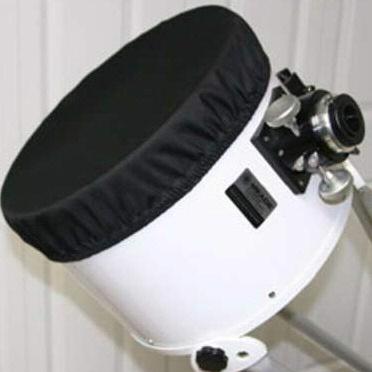
and Accessories
TIVE DESIG A ATIVE DESIGN , INNOVVA QUALITYY, INNOV
ries T ITS BEST A AT N













uality of workma has been internationally recognized for their q Astronomer that are proudly handcrafted in the USA, and other innovative products for the Modern controllers, lig telescopes, accessories, mounts, solar filters, dew Astroza planet. to match just about every telescope on the aluminum dew shields, with a large selection Astrozap is a leading manufacturer of flexible and
anship and customer service. udly ght shrouds, eyepiece trays and ap is also your source for w

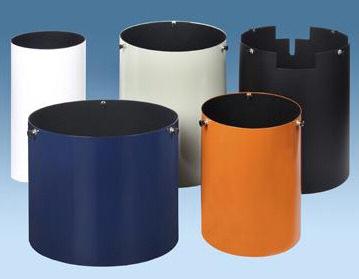



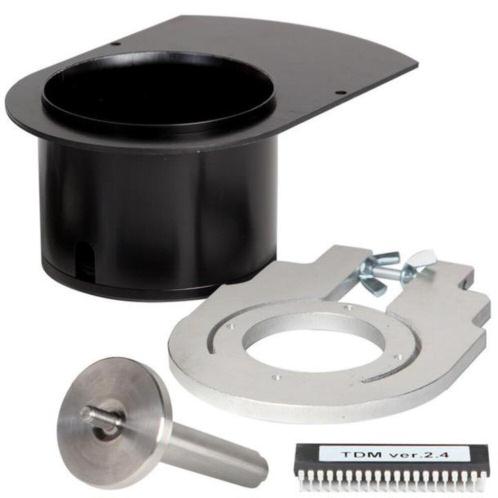



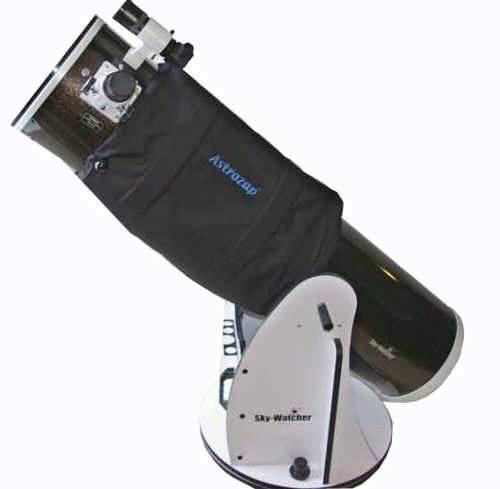
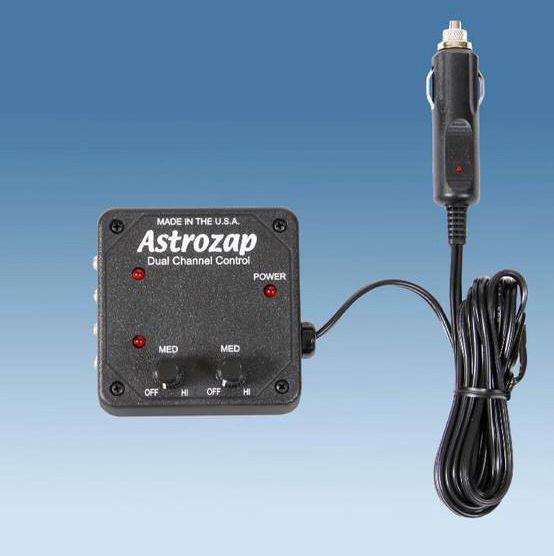

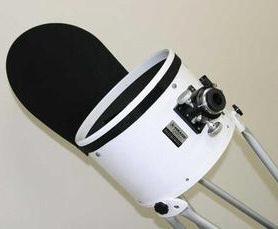 and Heaters
Dew Controlle Filters Solar s Dust C ers Covers Foccusing Aids
Shields
and Heaters
Dew Controlle Filters Solar s Dust C ers Covers Foccusing Aids
Shields
Light
Dew
Shrouds
Light Shields
Mounts
rays and M elescopes Eye Te Inno Innovativ o e produ
T d Caddies S epieces ucts for the moder ronomer n astronomer
Acccessories p f


PLAYER ONE
Player One Apollo Solar Cameras
T h e P l a y e r O n e A p o l l o S o l a r Cameras come in four configurations using different sensors for solar imaging. These include:
• Apollo-M MAX: A monochrome camera with the Sony IMX432 1.1 inch sensor. This camera offers a 9um pixel size which accommodates a well depth of 100ke with a total of 1.7MP (the resolution is 1608*1104) with a diagonal of 17 5mm
• Apollo-M MINI: A monochrome camera with the Sony IMX429) 2/3 inch sensor The 4 5um pixel size accommodates a well depth of 24.8Ke with a total of 2.8MP (the resolution is 1944*1472) with a diagonal of 11mm
• Apollo-M: A monochrome camera with the Sony IMX174 1/1.2 inch sensor The 5 86um pixel size accommodates a well depth of 32Ke with a total of 2.3MP (the resolution is 1944*1216) with a diagonal of 13 3mm
• Apollo-C: A color camera with the
Sony IMX174 1/1.2 inch sensor. The 5 86um pixel size accommodates a well depth of 32Ke with a total of 2.3MP (the resolution is 1944*1216) with a diagonal of 13 3mm
Each of these camera ’ s require the use of an energy rejection and light reducer for solar imaging such as the Baader Planetarium solar film products or a Herschel Wedge. They are not designed to be used to directly image the Sun without the proper filters.
Since solar cameras work in daylight, the temperature can be much higher than imagers experience in the evenings. The heat of global shutter sensors can be a problem, especially with some big format sensors like the IMX432.
To combat overheating, each camera offers ACS, an external air-cooled system which is designed for solar and big format planetary cameras. ACS works with t h e c a m e r a ’ s s e p a r a t e P C S ( P a s s i v e Cooling System) which acts to conduct

heat away from the sensor This cooling tandem can provide appropriate temperature control as the camera ’ s operating temperature will never be higher than 7°C above than the ambient temperature in the vast majority of normal operating conditions
The Apollo camera ’ s DDR3 cache helps stabilize and secure data transmission and effectively avoids frame dropping and greatly reduces read noise. With the DDR3 cache, the cameras don’t have high demands on computing resources and will offer excellent performance even if when connected to a USB 2 0 port
When the Player One Apollo Solar Cameras are connected to the USB3.0 interface and full-resolution preview is used, the actual writing speed will be affected by the writing speed of the hard disk itself When the hard disk writing speed is slow, the recording may not reach the theoretical speed. It is r e c o m m e n d e d u s i n g a h i g h - q u a l i t y solid-state drive to record data to give full play to the performance of the cameras
Each of the Player One Apollo Solar Cameras also offers HCG mode, which will automatically turn on when the camera gain setting is >145 The HCG mode can greatly reduce the readout noise and retain the same high dynamic range as the low gain
You can learn more about the Player One Apollo Solar Cameras at www.player-one-astronomy com
SOLAR ASTRONOMY PRODUCTS/NEWS 30 Solar Technology Today
We Bet You Didn’t Know!
We Buy Used Equipment
Did you know we buy your used equipment?
Yes we do!
We want to turn your used gear into new equipment or cash! Email farah@telescopes.net with your equipment and we take it from there!
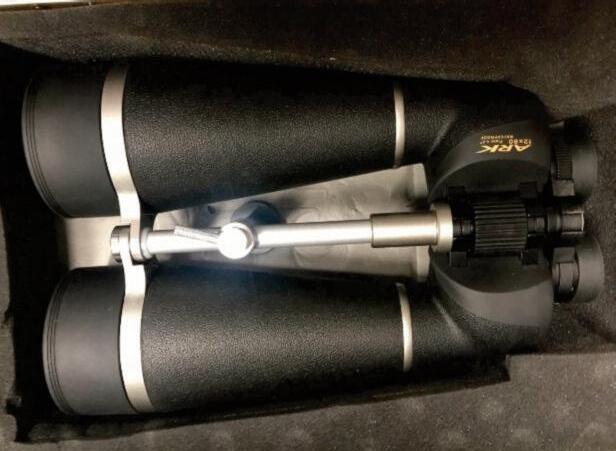
Clearance and Pre-Owned

Did you know we have a huge inventory of new and pre-owned equipment?

Yes we do! We are bursting at the seams with trade-ins, used, clearance, demos, close-outs, floor models, open box and more!
Equipment Rentals

Did you know we offer telescopes and astroimaging cameras for rent?
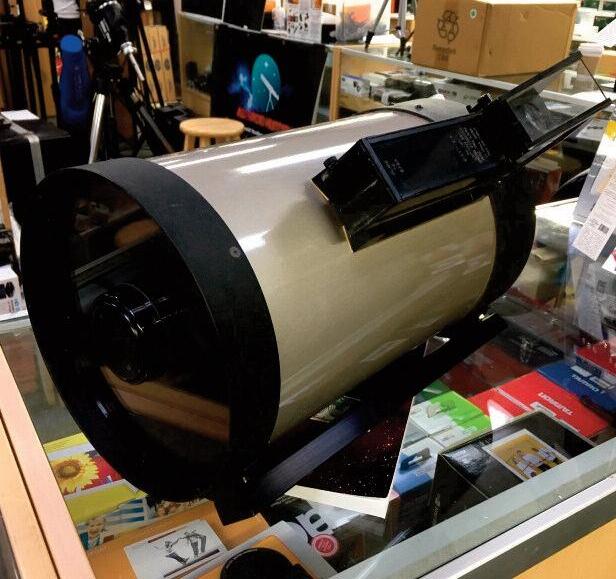
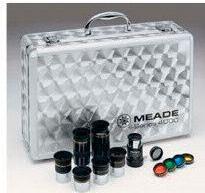
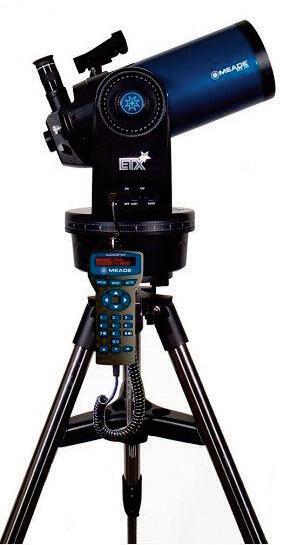
Yes we do! Check our website for current availability. Don't see something you want? We are expanding our selection so drop us a call a 818.347.2270 and we will be happy to hear your requests!
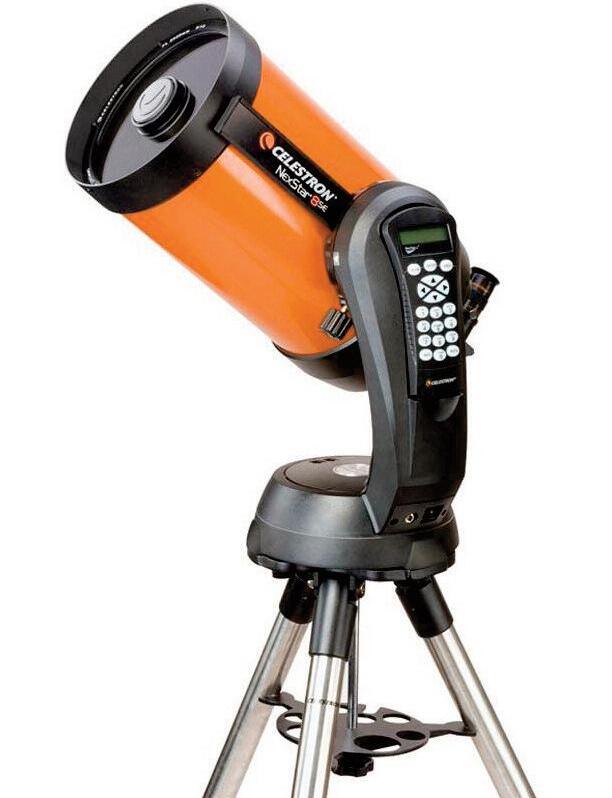
5348TopangaCanyonBlvd.•WoodlandHills,CA91364
DAYSTAR FILTERS
DayStar Filters 127-QT Solar Telescope
The DayStar Filters 127-QT Solar Telescope is a dedicated Hydrogen Alpha solar telescope The carbon fiber telescope offers a lightweight, short tube with retractable dew shield The compact design is only 29 inches long a n d w e i g h s j u s t 1 3 l b s i n c l u d i n g mounting rings and dovetail.
A 127mm doublet achromat, the telescope is optimized for Hydrogen Alpha in design, figuring and coating. T h e f o c a l l e n g t h i s 2 6 6 7 m a n d with focal reducer EFL is 1355mm.
I t i s a v a i l a b l e i n C h r o m o s p h e r e , Prominence or specific bandpass in PE grade
The 127-QT Solar Telescope specifications include:
• Digital readout and precision tuning control accurate to 0.01Å in center wavelength.
• Uses 12VDC power so it can also run off batteries
• Quantum Control software capable
• Robust, 2-inch steeltrack and rack and pinion focuser for added strength.
• Fully integrated DayStar filtration with classic DayStar Quantum control.
• Includes mounting rings with Vixen dovetail.
• Includes zero power solar finder 'alignment keys'.
• Ships in Pelican Storm Case
• Telescope Length: 31.1" with dew shield retracted
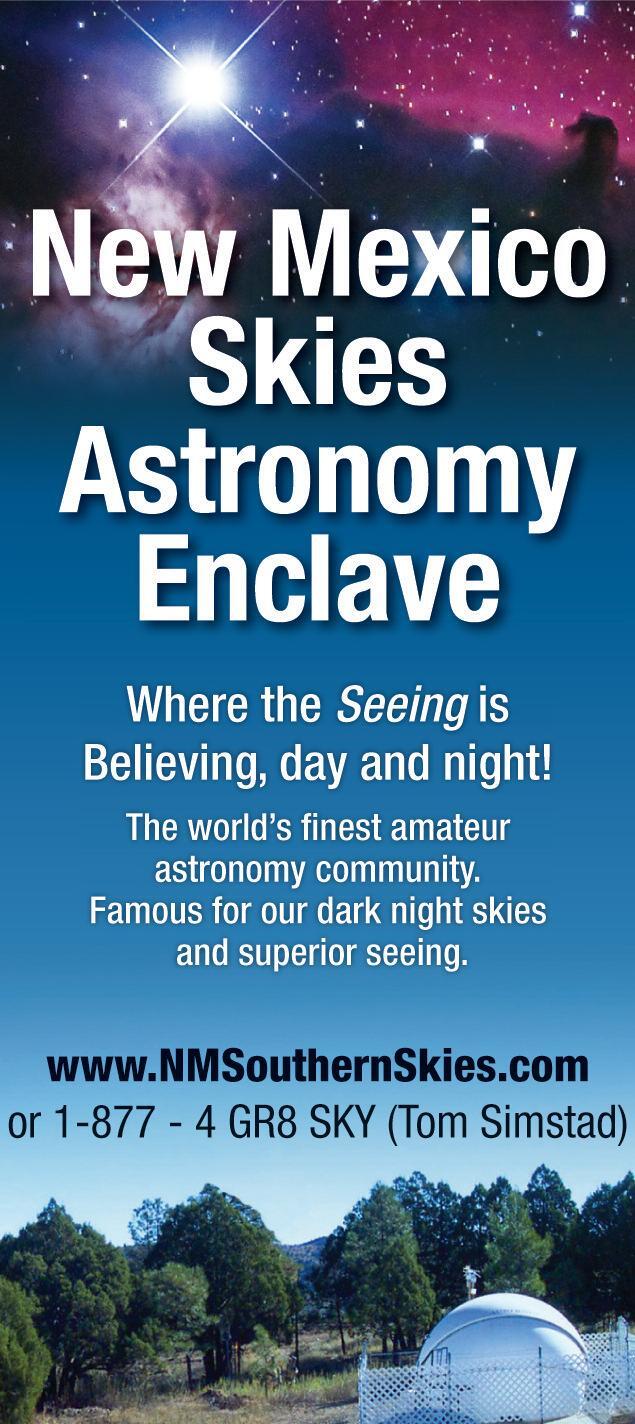
• Telescope weight: 13 6 lbs in rings.
• Operating Temperature: 20100° F
• Power supply: DC 12V, maximum
• 120mA, 2 1x5 5mm
• AC Adapter included: 120240VAC
• Power consumption: 1.5 watts
• Wavelength Shift range: +/-1Å
• 100% safe and fully blocked directly through the OTA
• 100% safe and fully blocked directly through white light solar finder scope
• Reaches focus using the following: 1.25" eyepiece, 2" eyepiece, ToUCam, Lumenera, S B I G , S L R , D S L R * , a f o c a l , CCTV Video,
A Tele Vue 55mm Plössl eyepiece is recomended for full disk or Tele Vue 32mm or 40mm Plössl eyepieces for higher power views with the 127-QT Solar Telescope.
You can learn more about the D a y S t a r F i l t e r s 1 2 7 - Q T S o l a r Telescope at www.daystarfilters.com.

SOLAR ASTRONOMY PRODUCTS/NEWS 32 Solar Technology Today

DAYSTAR FILTERS
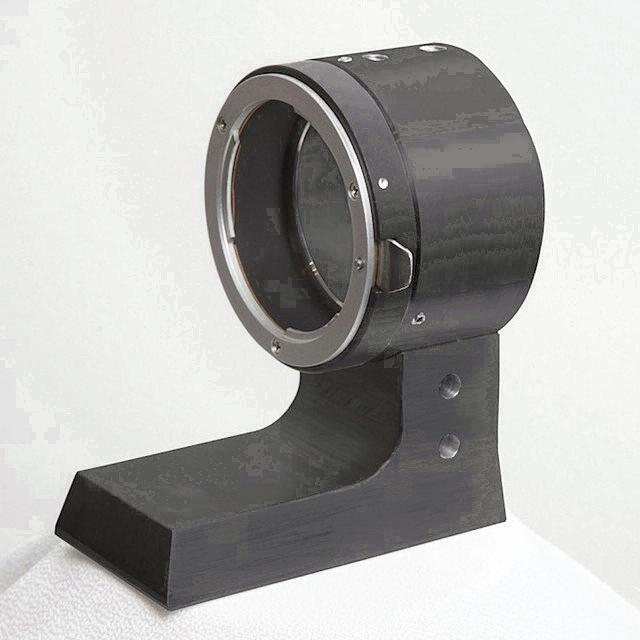
T h e D a y S t a r F i l t e r s Q U A R K C a m e r a A d a p t e r f o r N i k o n c o n n e c t s y o u r D a y s t a r Q U A R K s o l a r f i l t e r t o a n o r d i n a r y N i k o n s t y l e S L R l e n s , t u r n i n g i t i n t o a H y d r o g e n A l p h a s o l a r t e l e s c o p e . T h e a d a p t e r c a n b e u s e d w i t h a c a m e r a o r a n e y e p i e c e o r a n y Q u a r k / t e l e s c o p e i n d u s t r y a c c e ss o r i e s Y o u c a n u s e t h e z o o m f e a t u r e o f c a m e r a l e n s e s t o e x p l o r e w i d e f i e l d t o h i g h p o w e r v i e w s w i t h o u t c h a n g i n g s e t - u p o r t e l e s c o p e c o n f i gu r a t i o n . F u l l d i s k v i e w i n g i s p o s s i b l e o n l e n s e s u p t o ~ 4 5 0 m m f o c a l l e n g t h l e n s e s . D a y s t a r i n c l u d e s t w o 6 m m e x t e n d e r s p a c e r r i n g s t o e n s u r e c o mp a t i b i l i t y w i t h a w i d e v a r i e t y o f l e n se s T h e a d a p t e r o f f e r s a r e v e r s a b l e c o m b i n a t i o n l e n s f o o t w i t h 1 / 4 - 2 0 t r i p o d h o l e s a n d a V i x e n - s t y l e d o v et a i l p l a t e f o r t e l e s c o p e m o u n t s T h e r e i s n o e l e c t r o n i c p a s st h r o u g h w i t h t h e a d a p t e r a n d Q u a r k , s o c e r t a i n l e n s f e a t u r e s s u c h a s a u t o - f o c u s o r e l e c t r o n i c a p e r t u r e c o n t r o l w i l l n o t w o r k , a l t h o u g h y o u d o r e t a i n t h e b e n e f i t o f t h e
l e n s ' z o o m c a p a b i l i t i e s . D a y s t a r r e c o m m e n d s u s e o f r e d , o r a n g e o r y e l l o w c o l o r e d g l a s s l e n s f r o n t f i l t e r s o n l e n s e s a b o v e 8 0 m m a p e r -
t u r e . Y o u c a n l e a r n m o r e a b o u t t h e D a y S t a r F i l t e r s Q U A R K C a m e r a
A d a p t e r a t w w w d a y s t a r f i l t e r s c o m

34 Solar Technology Today SOLAR ASTRONOMY PRODUCTS/NEWS
QUARK Camera Adapter for Nikon
VAONIS
Vespera Solar Filter
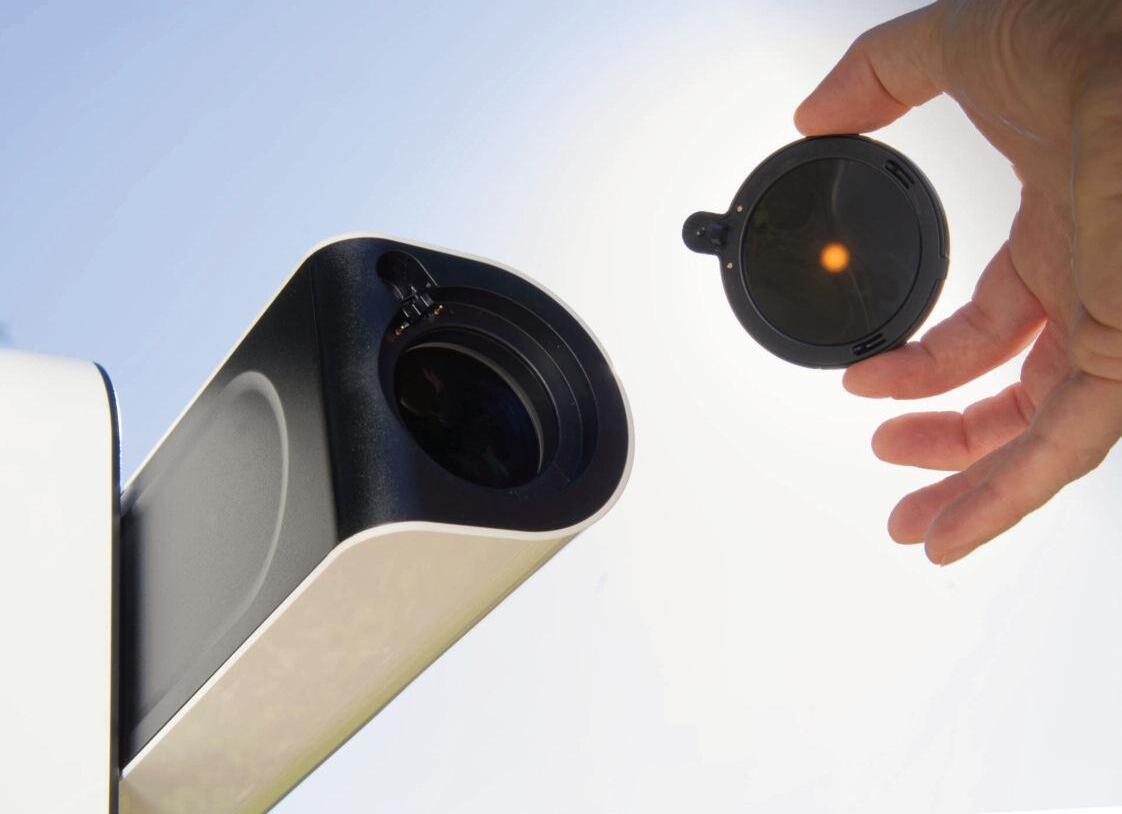
T h e V e s p e r a S o l a r F i l t e r a d d s t o t h e v e r s a t i l i t y o f t h e V a o n i s V e s p e r a o b s e r v i n g s t a t i o n b y p r o v i d i n g t h e a b i l i t y t o o b s e r v e t h e S u n . T h e f i l t e r a l l o w s y o u t o o b s e r v e s u n s p o t s t h a t s h o w t h e i n t e n s i t y o f t h e S u n ’ s a c t i v i t y
W h e n u s i n g t h e V e s p e r a S o l a r F i l t e r w i t h V e s p e r a ’ s S o l a r M o d e y o u c a n o b s e r v e t h e S u n i n a l m o s t r e a l - t i m e u s i n g t h e l i v e d i s p l a y Y o u c a n a l s o c a p t u r e p h o t o s a t a n y t i m e f r o m t h e o b s e r v a t i o n t a b o f t h e V e s p e r a S i n g u l a r i t y m o b i l e a p p . T a k e s e v e r a l s h o t s a t d i f f e r e n t t i m e s o f t h e d a y , w e e k o r m o n t h a n d c o m p a r e y o u r p h o t o s t o w i t n e s s h o w t h e S u n ’ s a c t i v i t y c h a n g e s w i t h t h e a p p e a r a n c e o r d i sa p p e a r a n c e o f s u n s p o t s T h e s e c a n h a v e a l i f e s p a n o f s e ve r a l d a y s , m o r e r a r e l y s e v e r a l w e e k s . T h e V e s p e r a S o l a r F i l t e r i s e a s i l y f i t t e d t o t h e f r o n t o f t h e o b s e r v a t i o n s t a t i o n ’ s l e n s a n d i s a u t o m a t i c a l l y r e c o gn i z e d b y t h e S i n g u l a r i t y a p p s o y o u c a n e a s i l y s t a r t y o u r s o l a r o b s e r v a t i o n T h e f i l t e r i s m a d e o f s o l a r s a f e m e t a l i z e d f o i l w i t h a d i m m i n g e f f e c t I t w i l l r e d u c e t h e a m o u n t o f l i g h t a n d a l l o w y o u t o o b s e r v e t h e S u n i n a w a y t h a t i s s a f e f o r y o u r i n s t r u m e n t Y o u w i l l b e g u i d e d t h r o u g h e v e r y s t e p b y t h e S o l a r P o i n t i n g m o d e o f t h e V a o n i s S i n g u l a r i t y a p p , t o e n s u r e t h e o b s e r v a t i o n r u n s s m o o t h l y a n d t h a t y o u a n d y o u r i n s t r u m e n t a r e s a f e T h e V a o n i s V e s p e r a i s , f r o m a t e c h n i c a l s t a n d p o i n t , a c a m e r a a n d n o t a t e l e s c o p e a s i t d o e s n ’ t o f f e r t h e t r a d it i o n a l o p t i o n f o r e y e p i e c e s o r t o a t t a c h i m a g i n g e q u i pm e n t . I t i s p a r t o f a n e w g e n e r a t i o n o f s m a r t , f u l l y a u t om a t e d d e v i c e s t h a t o f f e r s a n a l l - i n - o n e r o b o t i c p a c k a g e t o v i e w a n d s a v e d i g i t a l i m a g e s o f a s t r o n o m i c a l o b j e c t s .

T h e V e s p e r a o p e r a t e s t h r o u g h a S o n y I M X 4 6 2 s e n s o r c o u p l e d w i t h a n a p o c h r o m a t i c q u a d r u p l e d r e f r a c t o r w h i c h i s f o r m e d b y 2 g r o u p s o f 2 l e n s e s m a d e w i t h L a n t h a n u m g l a s s T h e V e s p e r a f e a t u r e s a n a p e r t u r e o f 2 ″ ( 5 0 m m ) , a f o c a l l e n g t h o f 8 ” ( 2 0 0 m m ) , a f o c a l r a t i o o f f / 4 , a m a g n if i c a t i o n o f 3 3 x a n d a f i e l d o f v i e w o f 1 . 6 x 0 . 9 d e g r e e s a n d i s m o u n t e d o n a n a l t - a z i m u t h m o u n t
I t u t i l i z e s t h e u s e r ’ s m o b i l e d e v i c e ’ s G P S , s t a r p a t t e r n r e c o g n i t i o n a n d a s t r o m e t r y t o c a l i b r a t e i t s e l f t h r o u g h t h e u s e o f t h e V a o n i s S i n g u l a r i t y a p p w h i c h i s a v a i l a b l e i n i O S a n d A n d r o i d v e r s i o n s . T h e i m a g e s c a n b e s h a r e d w i t h u p t o f i v e o t h e r c o n n e c t e d s m a r t p h o n e s u s i n g t h e S i n g u l a r i t y a p p . Y o u c a n l e a r n m o r e a b o u t t h e V e s p e r a S o l a r F i l t e r a t w w w v a o n i s c o m
Solar Technology Today 35 SOLAR ASTRONOMY PRODUCTS/NEWS
ANTLIA Solar Wedge
anti-reflection coatings to minimize intern a l r e f l e c t i o n s a n d c o n t r a s t r e d u c i n g stray light The solar wedge incorporates an Antlia 3nm narrow bandpass filter at t h e C a l c i u m I I K - L i n e c e n t e r e d o n 393.3nm and mounted in a standard 1.25’’ holder.
The Antlia Solar Wedge directs energy into an extra thick Polycrystalline Ceramic diffuser plate at the rear of the wedge In addition, cooling vents above the ceramic plate facilitate efficient cooling of the system
mize contrast for high-resolution imaging of sunspots, solar surface granulation and other features that are prominent in CaK light.
T h e A n t l i a S o l a r W e d g e o f f e r s a Herschel Wedge design which replaces the standard prism diagonal at the rear of refractor telescopes to enable imaging of solar granulation and sunspots.
The Herschel Wedge design is well known to give sharper, higher-contrast i m a g e s w h i l e t r a n s m i t t i n g a g r e a t l y reduced, safe amount of light to your imaging system The image brightness can be conveniently increased or decreased using a control ring with aperture blades, similar to that used in camera lenses.
The Antlia Solar Wedge is produced using CNC machining offering optical components that are multi-coated with
The internal Antlia CaK 3nm solar prism system provides for the safe management of harmful light intensity and heat when imaging the Sun. The system is comprised of a prism, CAK lens filter, Sun centering finder and a heat dissipation system The Sun’s light passes through the right-angle prism and excess heat is transferred to the rear fins that act as a heat sink for cooling the instrument. This heat management system effectively keeps the instrument at safe operating temperatures
The Antlia Solar Wedge prism and internal CaK solar filter are made of heat resistant double-polished substrate The A n t l i a C a K 3 9 3 . 3 n m s o l a r f i l t e r u s e s advanced multicoating to produce a sharp 3nm narrow bandpass, designed to maxi-
A high blocking specification of OD5 ( 0 . 0 0 1 % ) b e t w e e n 2 0 0 - 1 2 0 0 n m w a v elengths and OD3 (0.1%) between 12001500nm wavelengths delivers superb resolution for imaging with the Antlia Cak 3nm solar filter It should be noted that the bandpass for Cak (393nm) makes solar features almost invisible to human vision because of the eye ' s low sensitivity and poor resolving ability at the CaK frequency. Hence, the Antlia Solar Wedge with CaK filter is not recommended for visual observation It is designed for imaging with cameras that have spectral responses well beyond human vision
The Antlia Solar Wedge specifications and features include:
• Herschel 35mm prism
• Integrated ceramic heat dispersion diffuser
• Sharp CaK 3nm 393.3nm solar filter screwed into eyepiece holder base

• High-resolution imaging of granulation, sunspots, and other features-

• Includes a brightness control, a solar finder and effective heat dissipation system
• Anti Reflection (AR) coated prism and solar filter
• High blocking specification to reject solar heat ingress
• Sturdy CNC machined construction
• The wedge is intended for imaging only and is not suitable for visual observation
• The wedge is not intended for solar prominence imaging and visual
• The wedge must only be used with refractor telescopes to avoid damage to the unit.
• Refractor aperture must be no larger than 120mm or, focal ratio of F5.5 or longer.
You can learn more at www antliafilter.com.
36 Solar Technology Today SOLAR ASTRONOMY PRODUCTS/NEWS
Premier Select Dealers:
B&H Photo – 800.947.9970 – bhphotovideo.com
High Point Scientifi c – 800.266.9590 – highpointscientifi c.com
Optics Planet – 800.504.5897 – opticsplanet.com
Astronomics – 800.422.7876 – astronomics.com
Woodland Hills – 888.427.8766 – telescopes.net
Adorama – 800.223.2500 – adorama.com
Focus Camera – 800.221.0828 – focuscamera.com
Agena AstroProducts – 562.215.4473 – agenaastro.com

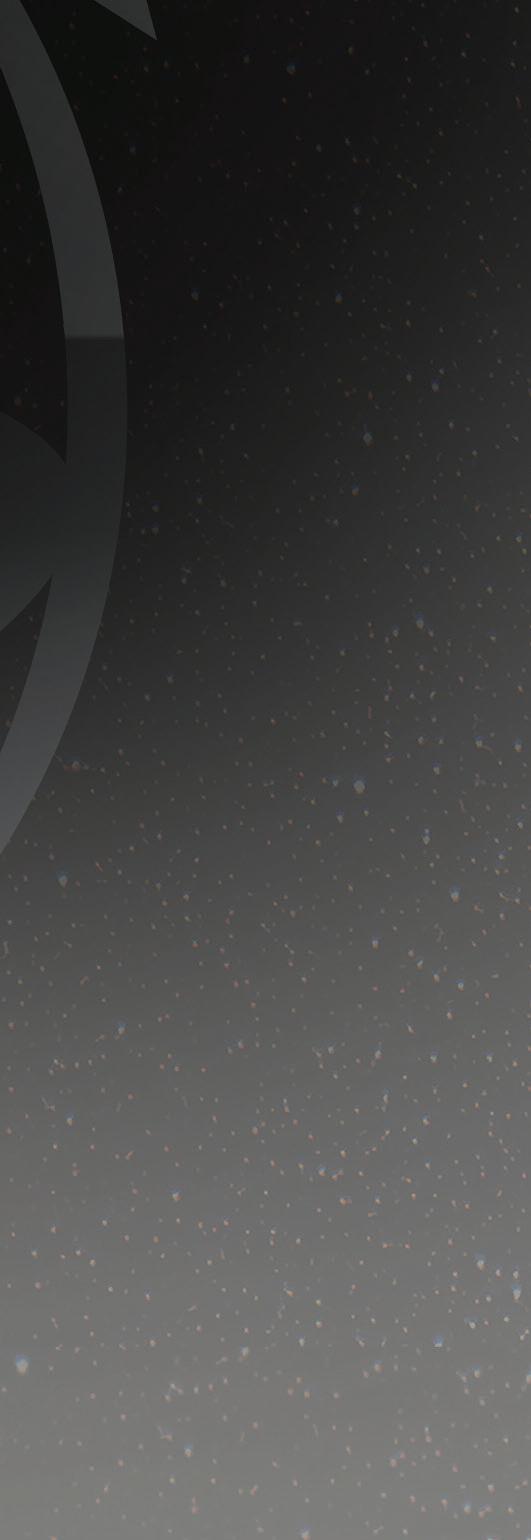
Celestron engineers have crafted an all-in-one solution to make observing and astroimaging easier and more rewarding than ever.
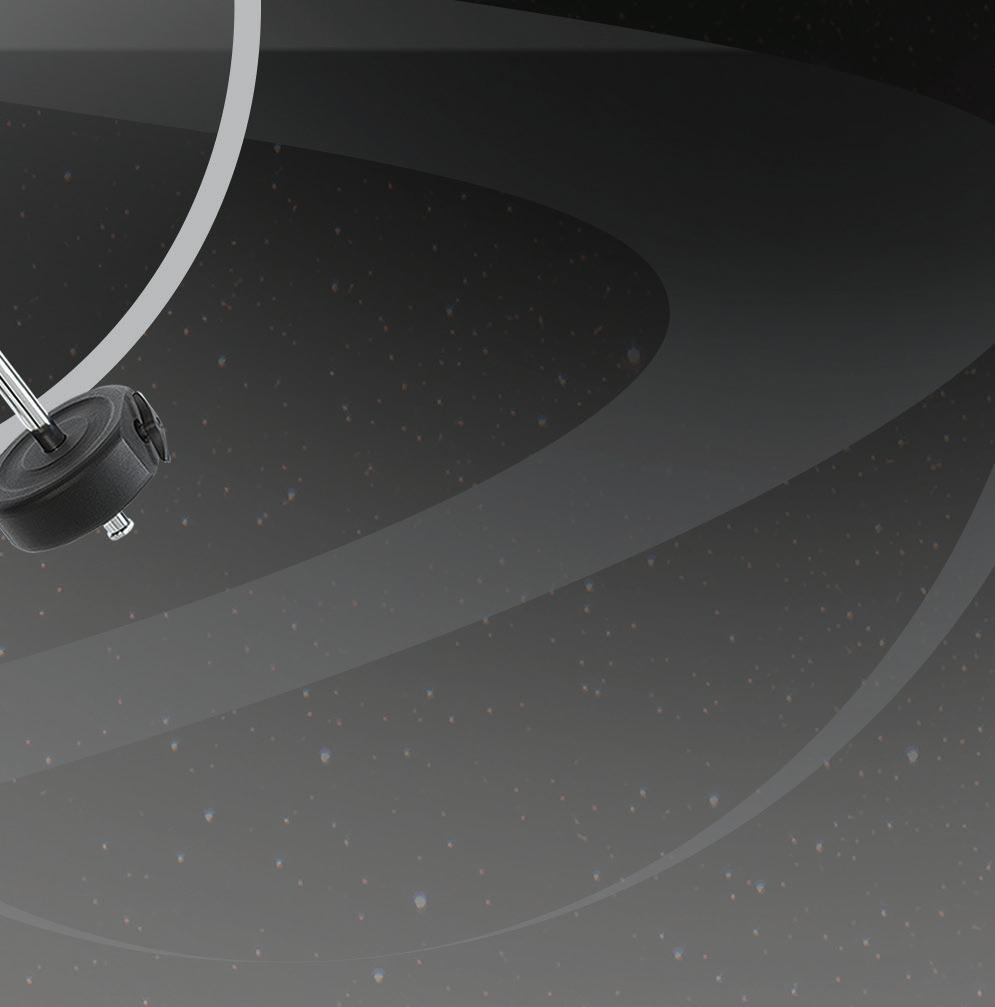

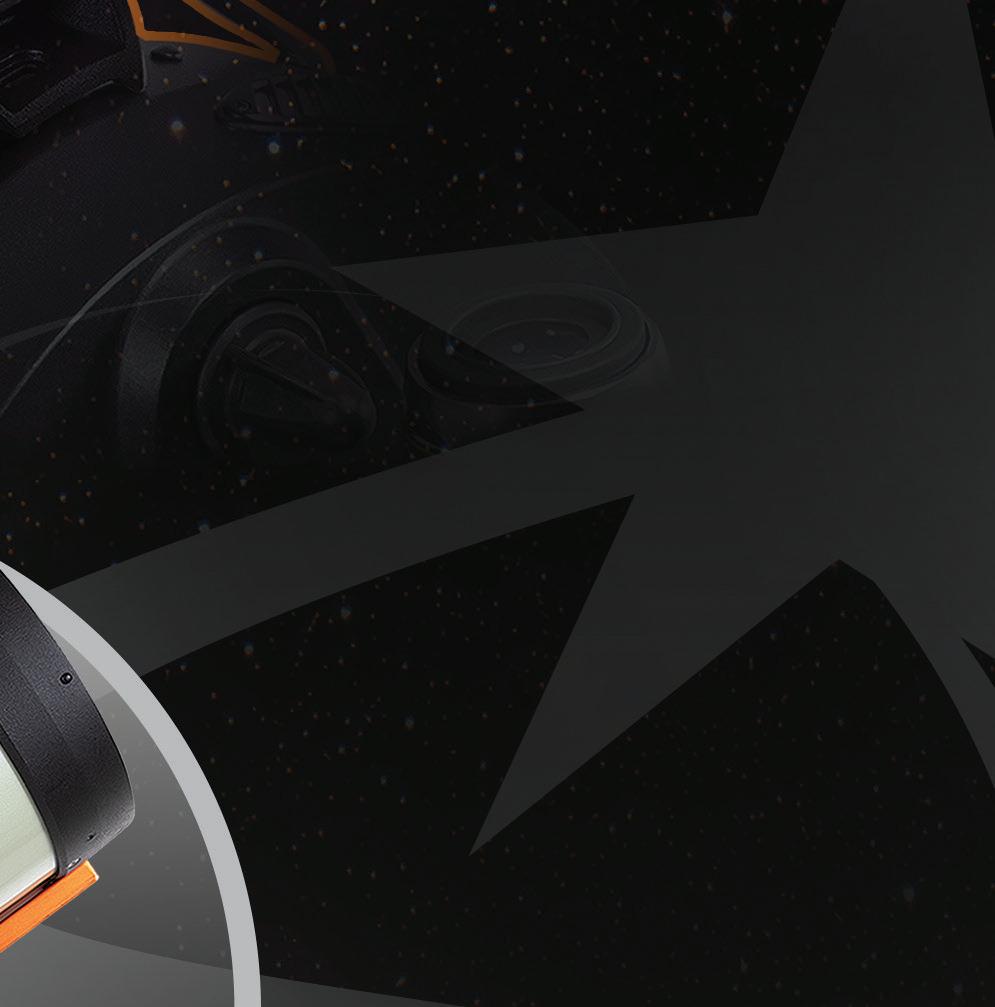
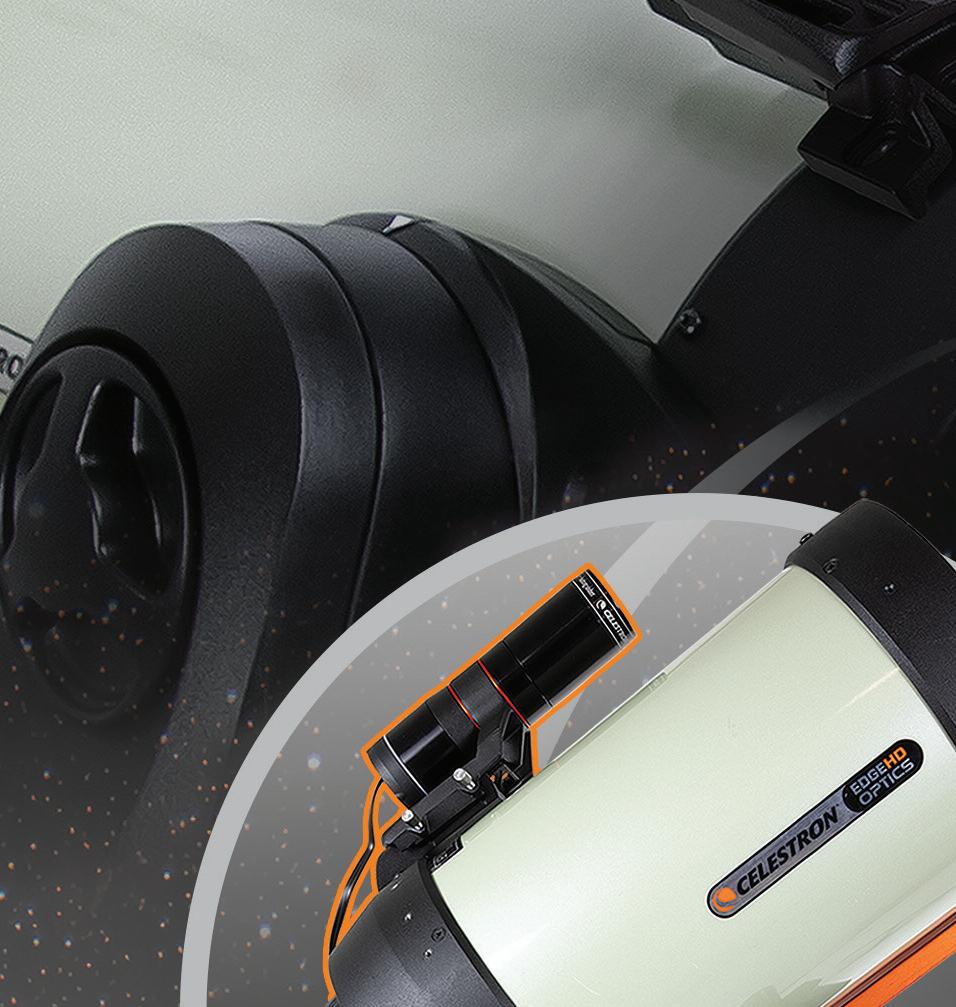

Automatic Alignment: Be ready to observe in minutes
Let your telescope align itself to the night sky in about three minutes with no user input needed. Using patented StarSense technology, StarSense Autoguider “sees” star patterns overhead and matches them to its internal database to automatically orient the telescope.
Precise GoTo: Supercharge your pointing accuracy
You can count on your Celestron mount to place any object in the field of view of a low-powered eyepiece. But when you add StarSense Autoguider, you boost that power. Objects appear in the center of high-powered eyepieces and small imaging sensors.
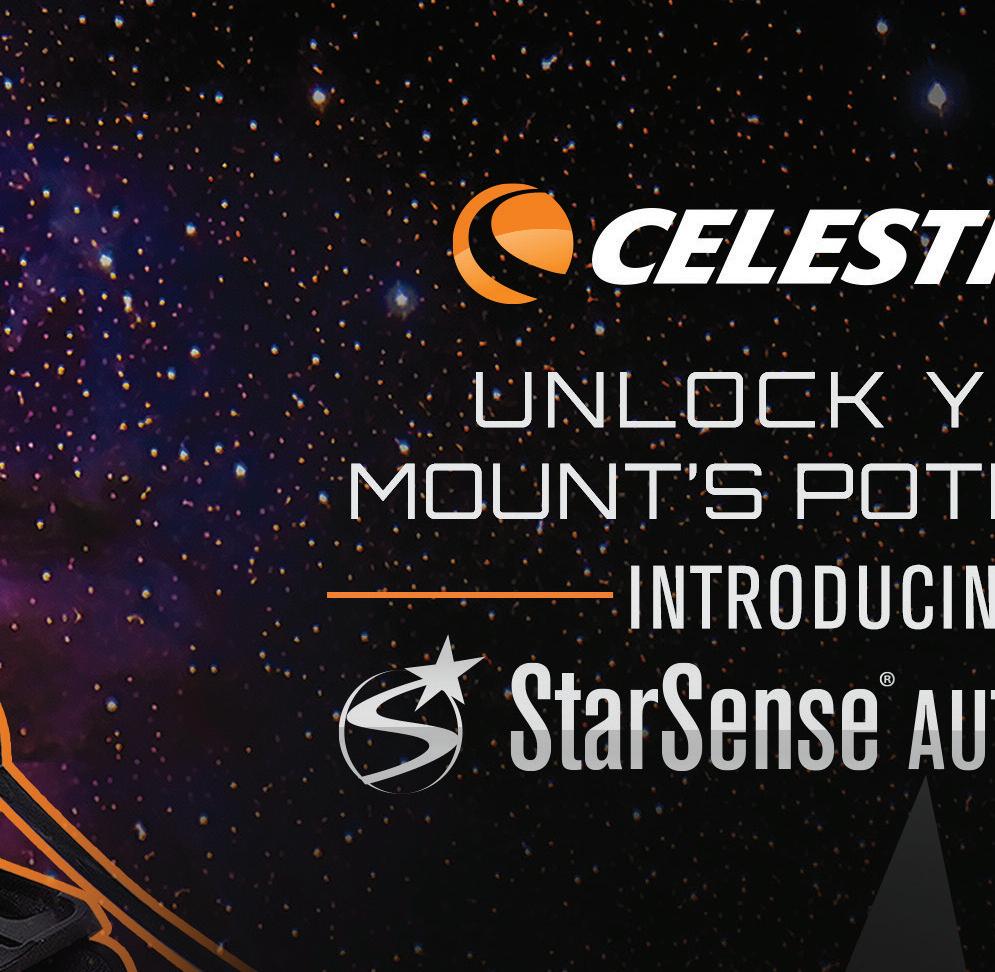
Autoguiding: Create your celestial masterpiece

Capturing images of astronomical objects is one of the most exciting things you can do with your telescope. StarSense Autoguider allows your scope to track accurately enough for pinpoint stars in long exposure astroimages. And you can do all this with a press of a button— eliminating the need for a separate autoguiding camera, guidescope, and computer. Autoguiding doesn’t get any easier than that!
Assisted Polar Alignment: Dial in the best alignment possible You don’t need a precise polar alignment to use StarSense Autoguider. But if you want the best accuracy possible, StarSense Autoguider walks you through an easy, automated process to get you there.
More about StarSense Autoguider
+Features a high-quality 4-element optical design with sharper optics than other mini-guidescopes, designed by famed optical designer Mark Ackermann
+ Works with your hand control, a wired PC connection to CPWI software, or WiFi
+ Includes an onboard computer and highly sensitive Sony IMX290-DLL monochrome CMOS image sensor
+ Compatible with most Celestron computerized mounts*
High Point Scientifi c – 800.266.9590 – highpointscientifi c.com OPT Telescopes – 800.483.6287 – optcorp.com Adorama – 800.223.2500 – adorama.com Focus Camera – 800.221.0828 – focuscamera.com Agena AstroProducts – 562.215.4473 – agenaastro.com B&H Photo – 800.947.9970 – bhphotovideo.com Optics Planet – 800.504.5897 – opticsplanet.com Astronomics – 800.422.7876 – astronomics.com Woodland Hills – 888.427.8766 – telescopes.net CELESTRON PREMIER SELECT DEALERS 562.215.4473 Learn more and get started today at celestron.com/ssag
*Visit our website for a full compability list.
ALCOR-SYSTEM
Continuous Solar Seeing Measurement System
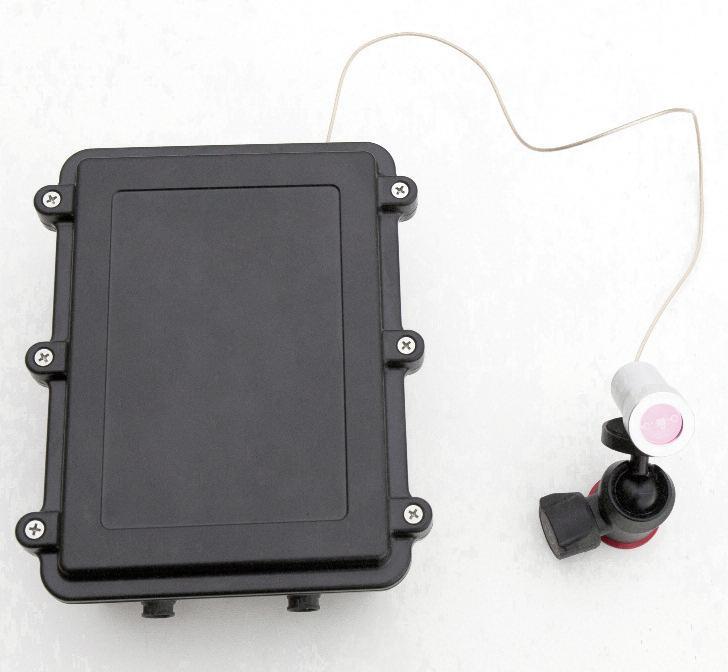
Turbulence (or seeing) is a great concern when recording images of the sky because it can jeopardize telescope resolution. Recording images during “best seeing” is optimal and to do so, continuous seeing measurement is required to optimize image recording time. Adding to the challenge of turbulence is the fact that getting seeing measurements during the day can be challenging since no star can be used
The idea behind the Continuous Solar Seeing Measurement System (CSSMS) is to measure the Sun’s scintillation and compute seeing figure equivalents. The CSSMS can be combined with all of Alcor-System’s Sky cameras and nighttime seeing monitors.
The CSSMS is a totally sealed sys-
tem that can overcome all extreme weather conditions and is not sensitive to wind gusts due to its strong design. The system offers watertight connectors for continuous outdoor operation and is made of high-quality alloy colorless anodized aluminum. A photodiode and a green filter 550nm, and very accurate and fast 16-bit ADC performs Sun scintillation measurements and outputs seeing figures expressed in arcsecs
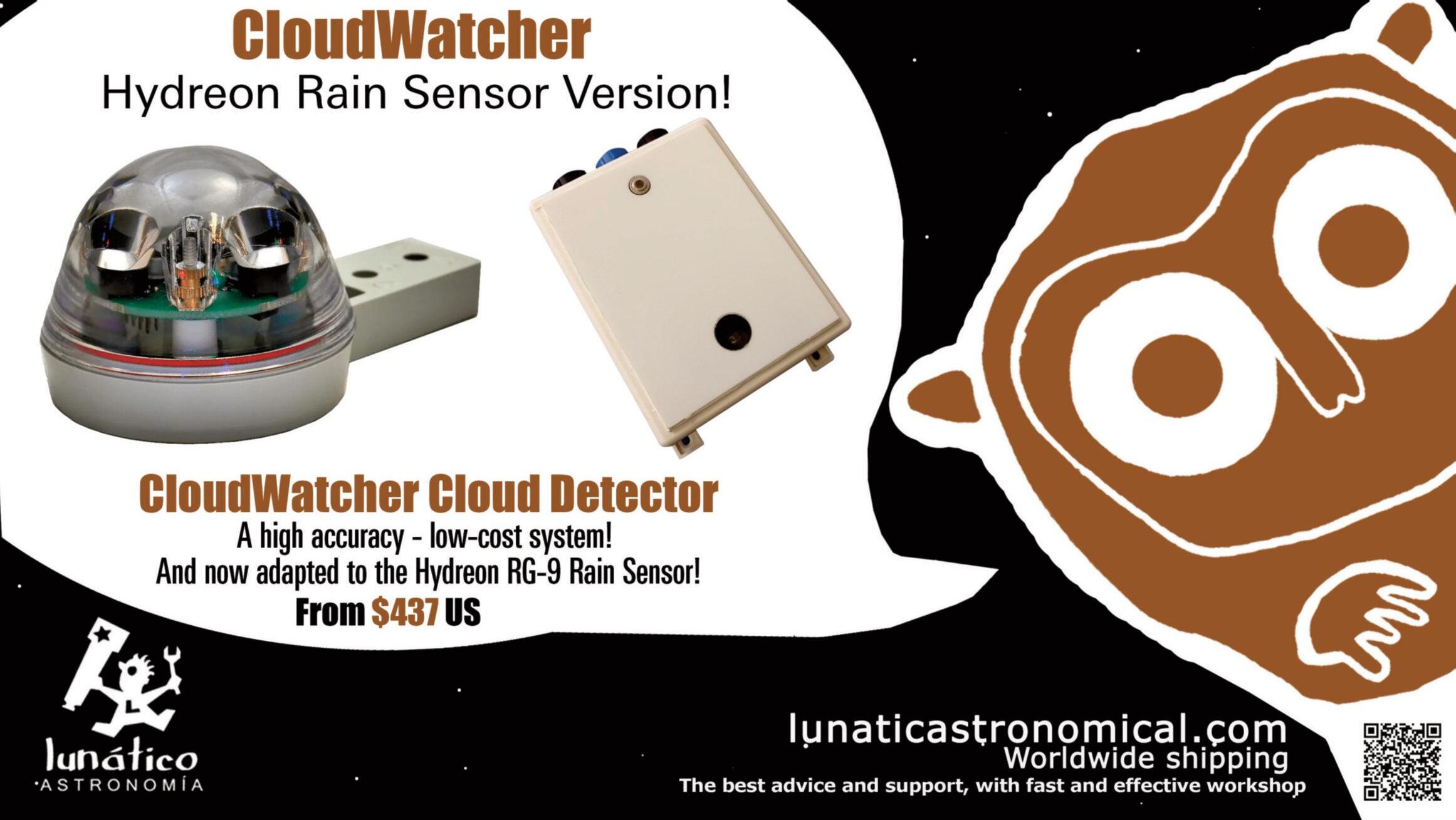
The software starts measurements automatically when the Sun is above the horizon and there is a clear sky. The CSSMS measures atmospheric seeing conditions in a continuous fashion, so the setup stays outdoors measuring sunlight and its scintillation. Clear skies without clouds is required for the system
to work properly
The link to the computer is USBHID type (no COM emulation) and offers a very reliable data link. The software runs on a PC Windows 10 platform and displays and saves seeing data through the course of the time.
You can learn more about these Alcor-System Continuous Solar Seeing Measurement System at www alcor-system com
SOLAR ASTRONOMY PRODUCTS/NEWS 38 Solar Technology Today
T an You Vue-60 ele e Shadow. Your d .. uee-60




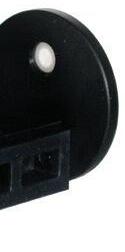


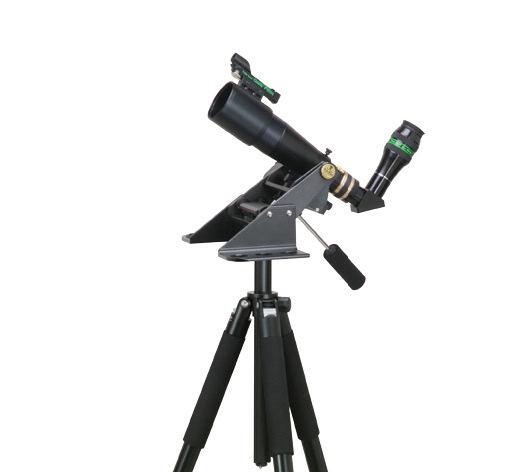






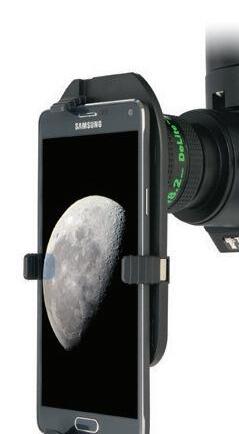








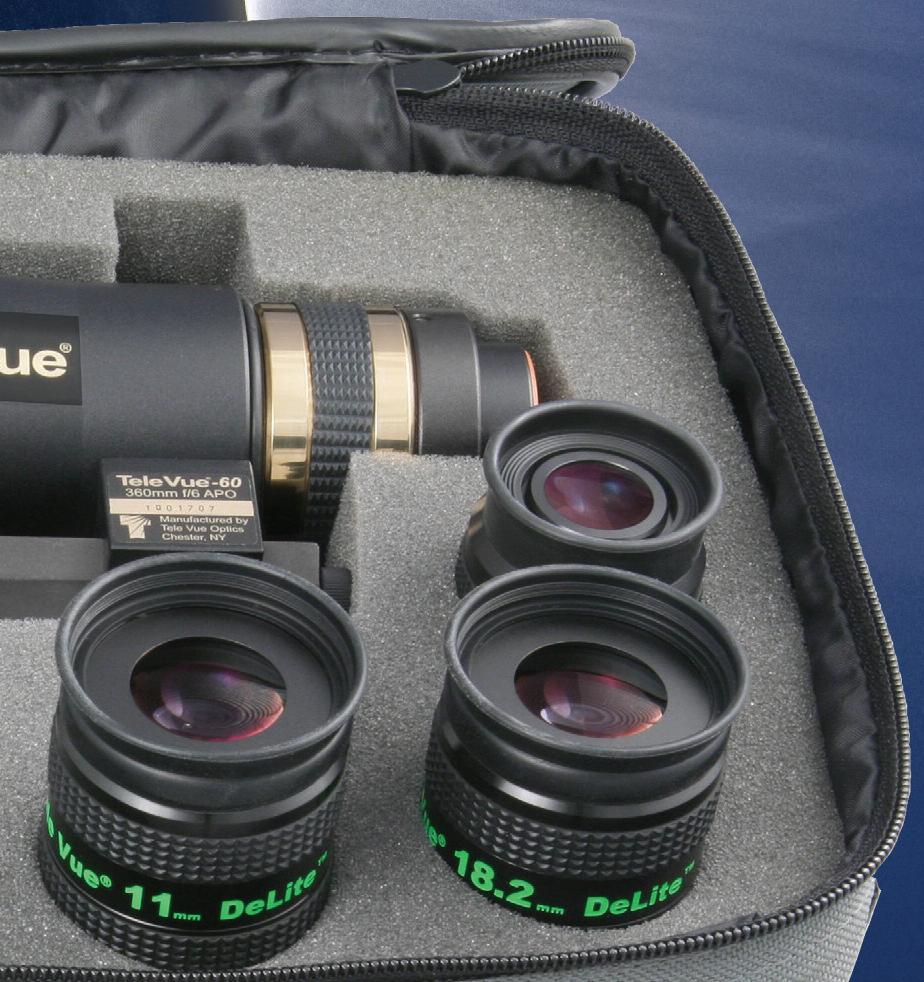



























Tquali



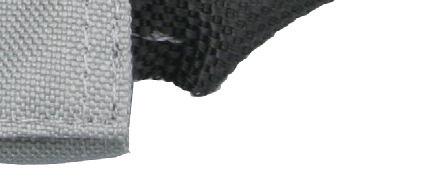





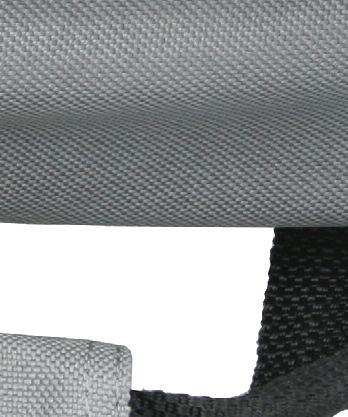

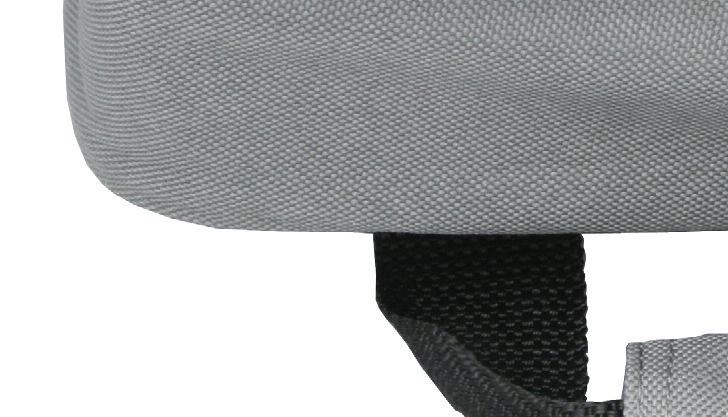




60 / 3 A shown with o 4.3° (with 1¼”, push 60mm/ L /f ti F.L./f-ratio: A / Ap/ -s p 60 / f/6 optional equipment. h 32mm Plössl/24 Panoptic) h-pull/helical fine focus 60mm/ spaced Doublet ou v When W ur ver n Whe b v obser uture f fu your ll all e Vu Tele Te ty lity
he chance to im true max. 4.3° b h k l performance With adventures dv ing teste and , lt built , d ed, design de is 0 6mage the Sun with your smart device is fun activity! no is 60mm diffraction-limited C d n, this s m l h n i l b l f expectation beyond truly nce o m those for fo e Vu le Tele Te at d he T Th 0 6 e- Vu Tele Te he T Th toy. mere Companion is s p Fonemate:smart Sol-Searc ada eyepiece to tphone V Tele Te cher fea fe d d f an ty beauty lasting la del de optical op stunning mpanioncomp ving obser pter T some and Fonemate, Fo option op ts its Pack ge ageimag f a e r c o ®ue , NY 10918 (845) 469-4551. r ., Cheste r 32 Elkay D telev ry-smoobuttery a res e tu luminumalu dizedanodi black of de made is jewel petite his T Th ty.ity ty iliity ta por tra u o of ination com its given r, er, ot o n e i li ay away chase and Mount MoTele-PoddM Te a grab epieces,eyep ey Vue Vu le Teele ea S Sol-Se So , l gonal,agodiag di Everbrite Ev an with ag bag ryingcarry custom al -t ap snap “ that for fo focuser fo ge agestag dual du th V V-85 Eclipse Image by Dennis diCicco, processing by Sean T y r a n io s i V -85
BAADER
SunDancer II 3x Telecentric System TZ-3S
T h e B a a d e r S u n D a n c e r I I 3 x Telecentric System
TZ-3S is designed for the entire visible spectrum and can therefore not only be used on H-alpha systems, but can also be used as a highquality telecentric multiplier that is superior to standard Barlows.
T e l e c e n t r i c s y s t e m s a r e m a i n l y used in H-alpha filters for solar observation, where the 1/100 lambda planeparallel etalon in the H-alpha filter requires a perfectly parallelized beam of light over the entire image. These telecentrics deliver very sharp images, but are usually only optimized for the H-alpha wavelength
However, the achromatic Baader SunDancer II 3x Telecentric System
TZ-3S is designed for the entire visible spectrum and can therefore not only be used on H-alpha systems, but also replace a Barlow lens. Due to the parallel beam of light, it performs well with regard to the working distance. While the magnification factor of a Barlow lens changes with the distance to eyepiece or camera (zoom eyepieces are also based on this principle), the magnification factor and image quality of the TZ-3 do not change, even if the new focal point deviates very significantly from the working distance of the optical design (65 mm).
T h e a c h r o m a t i c B a a d e r SunDancer II 3x Telecentric System
TZ-3S illuminates an image circle of 35mm at a distance of 65mm from the base body, ideal for the small sensors of modern, fast planetary cameras that require high magnifications for photographing the Moon and planets. The contrast is better than with simple Barlows or the eyepiece projection often used for high magnifications.
With the 3x telecentric system, the high magnifications which are necessary for visual observations can also be achieved with long focal length orthoscopic eyepieces The interpupillary distance of the eyepieces used does not change either.
T h i s a c h r o m a t i c 3 x t e l e c e n t r i c four-lens optical design features BBAR (Broad-Band Anti-Reflection) coating, anti-reflective thread and blackened lens edges against reflections and for maximum contrast. The image circle 35mm in 65 mm distance to T-2 threaded base and has 1¼” and 2″ nosepiece with 1¼” filter thread (T-2 thread on camera side)
The connection on the telescope side is made via the dual 1.25"/2" nosepiece with safety kerfs (these prevent tilting due to an incorrectly positioned safety groove and at the same time provide a secure hold). On the camera side, the T-2 thread provides a tilt-proof, fixed connection even to h e a v y c a m e r a s o r t o T - 2 e y e p i e c e clamps For the T-2 thread, adapter rings are available for almost all common connection systems (e g M48 / 2"/ M68).
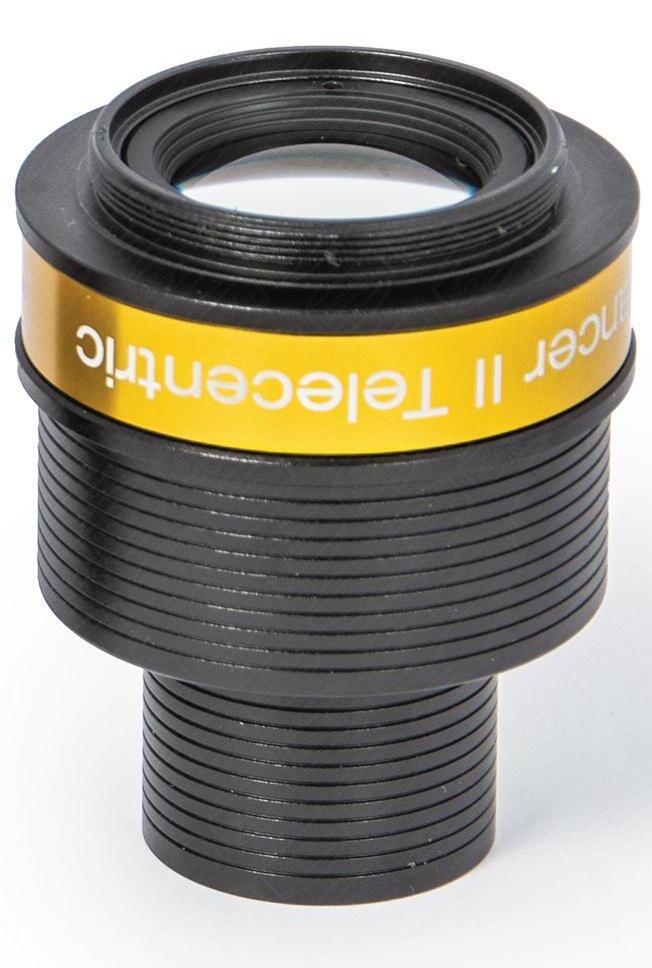
A telecentric system extends the focal length similar to a Barlow lens, but with parallel rays of light. This means that the working distance is almost the same, and the quality and image scale remain the same. At the same time, the TZ-3S delivers a highcontrast image On cameras with less than 35mm image circle, edge shading is no longer a problem and you benefit from higher contrast of the telecentric.
Baader SunDancer II H-alpha Filter is the same as the Baader SunDancer II
3x telecentrics TZ-3S, but additionally contains a 2nm (FWHM) blocking filter It shimmers golden when you look into the SunDancer from the telescope side This blocking filter is absolutely necessary to protect the actual H-alpha filter from solar radiation. The 3x telecentric system is available as the Baader SunDancer II 3x Telecentric TZ-3S without block filter such as for use with other H-alpha filters. The blocking filter, however, is not available separately.
The blocking filter reflects the sunlight just before the etalon and the telecentric system This protects the etalon from excessive heat In addition, an etalon also transmits wavelengths that are a multiple of the desired transmission line; these are also blocked by the blocking filter, too.
You can learn more about the Baader SunDancer II 3x Telecentric System TZ-3S at www.baader-planetarium com
T h e t e l e c e n t r i c s y s t e m o f t h e
SOLAR ASTRONOMY PRODUCTS/NEWS 40 Solar Technology Today



TELESCOPE KITS WITH SOLAR FILTERS
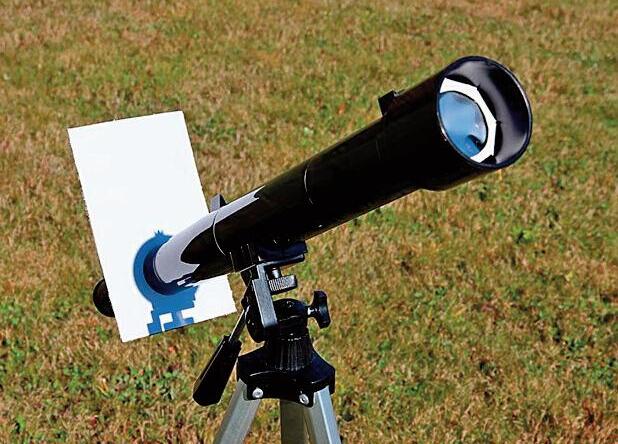 By Douglas Arion, PhD
By Douglas Arion, PhD
Back in 2009, I partnered with Richard Fienberg (American Astronomical Society) to launch Galileoscope as an international cornerstone project for the International Year of Astronomy. These low-cost, high quality telescope kits have been an important instrument for engagement with astronomy ever since
Galileoscope was also selected as an international cornerstone for the 2015 International Year of Light. Continuing production has seen more than 270,000 Galileoscope’s in use in over 110 countries
A wide range of educational guides and materials have been created, along with instructions in multiple languages, and are available through the project websitehttp://galileoscope org
There is also a large established user base, and many online resources that have been created (see, for example, these howto videos from the Astronomical Society of the Pacific: https://youtu be/coXPIW TRN3c and https://youtu be/KEq9di0ZZc and articles such as https://www.academia.edu/28858081/Gal
ileoscope Optics Activity Guide and https://adsabs.harvard.edu/full/2011ASP
C 443 397P )
Galileoscopes are 50mm diameter, 500mm focal length refractors with glass doublet objectives, a Plössl 20mm FL eyepiece (giving 25x), and a 2x Barlow lens (giving 50x) that doubles as a Galilean eyepiece, so one can experience what Galileo did when he first turned a
telescope to the heavens (although his telescope wasn ’ t optically anywhere as good as a Galileoscope!).
Galileoscopes have been particularly great for engaging youngsters and students with astronomy (see Image 2 of a recent workshop with students at the Compass Academy in Franklin, NH), as well as for science teachers, astronomy clubs and public outreach, and in education from elementary school through college, especially in Astro 101 courses.
A couple of years ago Scott Roberts and
Explore Scientific took over manufacturing and distribution from us. This has greatly expanded availability of Galileoscopes, as Rick Fienberg and I had volunteered our time, effort, and personal resources to launch and manage the project on top of our regular positions for a decade – which is one of the reasons it has been available at such low cost.
Galileoscope Kits with Sun Filters & Tripods
Working with Explore Scientific we ’ ve
Solar Technology Today 43
GALILEOSCOPE
Image 1 - Galileoscope telescope with safe solar filter and sun shade, on a tripod, ready for use.
created an updated Galileoscope kit package that includes a safe solar filter and sunshade. The Galileoscope is a wonderful telescope for observing solar eclipses – and for observing sunspots on any sunny day (and the Moon, planets, and other celestial highlights on any clear night).
These new kits are perfect for the upcoming 2023 (annular) and 2024 (total) solar eclipses and are also suitable for observing the increase in solar activity over the next few years. Indeed, one of Galileo’s accomplishments was observing sunspots on
the Sun!
To ensure eye safety, Explore Scientific has developed a safe solar filter - one that meets the transmission requirements of the ISO 12312-2 international standard - that fits snugly inside the Galileoscope ’ s de w cap, along with a sunshade that keeps bright sunlight off your face while obser ving and that doubles as a pointing aid so that you can safely aim your Galileoscope at the Sun without risk to your eyes.
In addition to solar-capable Galileo-
scope kits, Explore Scientific is also offering economical tripods, and, for those who already have or are reselling Galileoscopes, solar filters and sun shades as add-on accessories Image 1 shows the new Galileoscope solar kit with the solar filter and sun shield installed.
With production lead times, and to ensure delivery for summer and fall 2023, preorders are needed Galileoscopes, tripods, and solar filters/shades are available in case lots of 10 each, with very competitive pricing and substantial volume discounts, as shown here.
• Galileoscope + Solar Filter + Sun Shade: 10-90 units $39 ($390/case); 100-490 units $35 ($350/case); 500+ units $31 ($310/case)
• Tripod: 10-90 units $22.95 ($229 50/case): 100-490 units $18 95 ($189 50/case): 500+ units $16.95 ($169.50/case)
• Solar Filter + Sun Shade: 10-90 units $3.85 ($38.50/case); 100490 units $3 75 ($37 50/case); 500+ units $3 50 ($35/case)
Also available are eclipse glasses, with bulk discount pricing:
• Eclipse Glasses: $1.29 (up to 500 units); $1.19 up to 3000 units; $1 09 up to 25000; $0 60 for 25000 and up (custom printing available)
Pre-orders require a 50% deposit, the remainder due at time of shipping.
We're reaching out to ever yone to take advantage of this special opportunity to place orders now – to assure that they can be produced and delivered in time for distribution for summer star parties and public events, and to be available for the 2023-2024 school year and the annular and total eclipses Galileoscopes are still the most economical, quality telescope kit out there, and with solar filters can be utilized day and night to experience the sky above us!
We encourage those interested in solar outreach to go to http://galileo-

44 Solar Technology Today GALILEOSCOPE TELESCOPE KITS WITH SOLAR
FILTERS
Image 2 - Compass Academy students in Franklin, NH enjoying their Galileoscopes after assembling them in an after-school workshop!
New Product Store
We Carry Over 90 Different Manufacturers in Addition to Our High End APM Products www.apm-telescopes.net/en
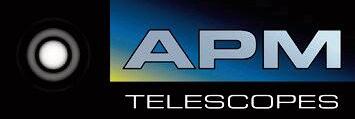
A4 SOLAR

APM
APM
34 X 80 ED
BINOCULARS
APM COMACORRECTING
1 1/4" ED DOUBLE BARLOW
APM 40 X 110 ED BINOCULARS
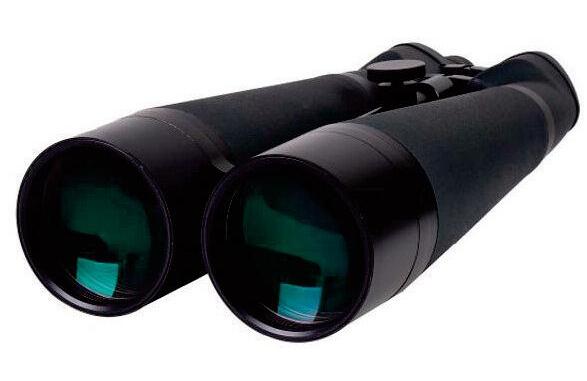

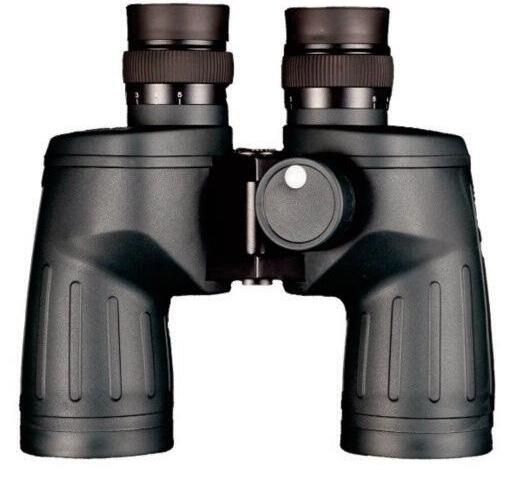

The use of special ED objectives (FCD1 from Hoya Japan) mean these binos are indispensable when the smallest details have to be recognized in detail from a great distance.
APM APO SD REFRACTOR 152MM F/6 WITH 3.7" ZTA
This Barlow is a high performing photo-visual, apochromatic 2.7x Barlow with ED glass for correcting the off-axis coma in Newtonian telescopes.
This 2-element SD is a truly perfect telescope for the ultimate in wide-field observing. The stars are absolutely pinpoint, as only an well corrected apochromatic refractor can produce.
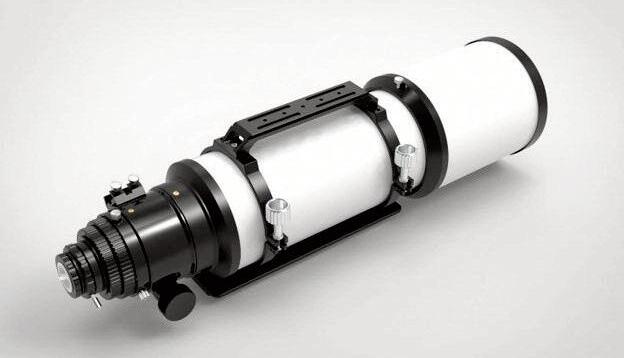
TSE17
FILTER FILM APM Telescopes Quierschieder Weg 38 66280 Sulzbach GERMANY Phone: +49 (0) 6897 92 49 29-0 Fax: +49 (0) 6897 92 49 29-9 See Us Online at: www.apm-telescopes.net/en Like Us On Facebook Follow ongoing projects and promotions on our Facebook page Your Headquarters For: Binoculars • Telescopes • Observe the Sun • Mounts & Tripods • Eyepieces • CCD / Astro Photography Optical Accessories • Mechanical Accessories • Other Accessories • Domes Observatories • Secondhand • Used Zeiss Products • Oldtimer & Antique
This tough polymer Solar Filter Film is 100% certified as safe for solar viewing and is lightweight and extremely flat. Globally!
Hot Products We Ship
Why Wait? We Have a Massive Inventory Ready to Deliver!
PM
These binos feature ED objectives (FK61) offering all around big performance with sharp wide-angle eyepieces providing excellent astronomical views.
Marine Binoculars 7x50 with Integrated Compass.
PM MARINE BINOCULARS 7X50 WITH INTEGRATED COMPASS
scope org/eclipse to enter pre-orders and learn more about Galileoscope and the education materials and support that are available.
An In Depth Look At The Galileoscope
As mentioned, the Galileoscope is a refracting telescope, or refractor: a long tube with a big lens (the objective) at the front end and a small lens (the eyepiece) at the back end The great Italian scientist Galileo’s telescopes were refractors, too, but the Galileoscope improves upon his 400year-old design in several important ways.
The field of view is the angular diameter of the circle of sky you see when you look into the telescope’s eyepiece The full Moon is about ½° wide, so the Galileoscope ’ s field at 25x is three Moons wide, just big enough to encompass the splendid Pleiades star cluster in Taurus, one of the objects Galileo marveled at 400 years ago If you double the magnification to 50x using the included Barlow lens, the width of the field of view is correspondingly halved. Image 3 shows simulated views of the Moon at 50x, the Pleiades star cluster at 25x, and Jupiter and its moons at 50x in the Galileoscope.

Eye relief is the distance behind the eyepiece that you need to put your eye to
see the entire circular field of view The Galileoscope’s ample eye relief of 16 mm at 25x and 22 mm at 50x should enable anyone, including children, to observe comfortably with or without eyeglasses.
We’ve designed the Galileoscope to accept accessories with the standard 1¼-inch barrel common to most commercial telescopes. This means that you can substitute your own eyepieces of various focal lengths for the supplied 20-mm eyepiece, giving you additional options for magnification and field of view.
Galileo built each of his telescopes with a convex (magnifying) objective lens and a concave (demagnifying) eyepiece lens This combination produces an image that is both right-side up and correct leftto-right, but the field of view is uncomfortably narrow - as if you ’ re looking at the sky through a drinking straw. Image 4 is a photo shows one of Galileo’s telescopes on display in Florence, Italy
Unique among available telescope kits, the Galileoscope can be assembled in either a Galilean configuration or a Keplerian configuration so that you can compare the two designs yourself The Galileoscope is really two telescopes in one!
The Galileoscope’s 50-mm f/10 objective lens is an achromat made from two types of glass. The 20-mm (25x) eyepiece
employs two achromats - a total of four lenses - made from two types of plastic. This four-element configuration is similar to that of the popular Plössl eyepiece, a high-quality design rarely seen on any telescope costing less than $100
In addition to the main eyepiece, the Galileoscope comes with another plastic achromat that can be used in either of two ways: as a 17x eyepiece in the Galilean configuration, or as a 2x Barlow lens to double the magnification of the Galileoscope to 50x in its normal Keplerian configuration.
We’ve designed the Galileoscope so that it can be assembled in 5 minutes or less by young children with some adult supervision Assembly requires no tools, no glue, and no adhesive tape - ever ything snaps into place easily.
As noted, the Galileoscope’s objective is a two-lens glass achromat It comes as a single unit with the two elements glued together. The twin two-element plastic achromats for the main eyepiece, and the two-element plastic achromat for the Galilean eyepiece/Barlow lens, come as individual lenses, so that’s six more pieces Except where noted, all other parts in the Galileoscope kit are made of ABS plastic, a durable material commonly used in injection molding.
46 Solar Technology Today GALILEOSCOPE TELESCOPE KITS WITH SOLAR FILTERS
Image 3 - Simulated views of the Moon at 50x, the Pleiades star cluster at 25x, and Jupiter and its moons at 50x in the Galileoscope. The image was made with Starr y Night software and additional images by Rick Fienberg.
The complete 31-piece parts list includes:

• Lens shade/dew cap
• Eyepiece-barrel halves (2)
• Objective lens
• Eyepiece field-stop ring
• Main tube halves (2)
• Eyepiece clamp ring
• ¼-20 mounting nut
• Eyepiece eye-end ring
• V bases/stands (2)
• Barlow tube
• Main-tube clamp ring
• Galilean eyepiece/Barlow lenses (2)
• Main-tube O-rings (2)
• Galilean eyepiece tube halves (2)

• Focuser tube halves (2)
• Galilean eyepiece clamp ring
• Focuser tube O-rings (2)
• Galilean eyepiece/Barlow eye-end ring
• Eyepiece lenses (4)
• Sun-warning sticker
All parts except the lenses (of course) and mounting nut are black The tube halves fit together with tongues and grooves
to prevent light from seeping in through the sides and the main tube includes multiple internal baffles. In addition, the insides of the telescope and focuser tubes are roughened to minimize internal reflections. These features, designed to reduce glare and the amount of stray light reaching the eyepiece, make the Galileoscope an ideal urban telescope for use in even the most light-polluted cities and are usually found only on telescopes costing much more The Galileoscope can be put together in 5 minutes or less. A 10-year-old child
Image 4 - A photo taken by Rick Fienberg of one Galileo’s telescopes on display in Florence, Italy.from the interior at zenith.
GALILEOSCOPE TELESCOPE KITS WITH SOLAR FILTERS Solar Technology Today 51
can assemble the telescope with minimal adult super vision, and younger children with a bit more supervision Moreover, the kit can be assembled and disassembled multiple times - making it well suited for classroom use.
To assist with aiming the telescope at celestial targets, the main tube has a traditional notch-style sight along the top edge Eyepieces and other accessories are held securely in the focuser by self-adjusting spring-loaded tabs molded into the tube The focuser assembly slides in and out with a comfortable amount of friction and can be moved in ver y tiny steps to achieve precise focus. If you ’ re nearsighted or farsighted and prefer to look through a telescope without wearing eyeglasses, you’ll appreciate the Galileoscope’s extra-long fo-
cuser tube, which accommodates a wide range of focus positions
The ¼-20 mounting nut enables the Galileoscope to be affixed to a standard photo tripod or any other mount with a ¼20 threaded post.
The bases/stands ser ve several purposes They can simplify assembly by cradling the main tube on a tabletop or display the telescope by supporting it on a shelf or mantel. They also can enable students to partially assemble the telescope on a table and see what’s happening inside the instrument as it forms an image of a distant object.
No tools are needed to assemble the Galileoscope - all the parts fit together by hand in just a few minutes, with the tube halves held together by snap-fit plastic

rings and/or rubber O-rings. A sheet of English-language instructions is included, but a set of graphical instructions is available in our Assembly Instructions section, so you don’t need to read English to assemble the scope.
As noted, the Galileoscope’s 1¼-inch (31¾-mm) barrel enables the use of standard commercial accessories such as additional eyepieces, Barlow lenses, and camera adapters. A 1¼-inch focuser is one of the key factors that distinguishes a serious telescope from a toy (Another is achromatic optics, and the Galileoscope has those, too!) There are thousands of 1¼-inch accessories on the market today, giving the Galileoscope virtually limitless versatility.
One accessory that does not work with the Galileoscope, at least not in most cases,
48 Solar Technology Today GALILEOSCOPE TELESCOPE KITS WITH SOLAR FILTERS
Image 5 - The Galileoscope telescope kit before assembly. Photo by Joson Images.
is a star diagonal. That’s a right-angle mirror or prism that goes between the telescope and eyepiece and enables you to avoid having to crane your neck when observing celestial objects high overhead. The Galileoscope is designed for straightthrough viewing. There’s not enough “in focus” to permit the use of most star diagonals We recommend sitting in a chair with the Galileoscope on a tripod that can be extended to a height of at least 150 cm (60 inches). That way, obser ving objects high in the sky will be comfortable even without a star diagonal
A Galilean eyepiece is included in the Galileoscope kit which offers a custom accessor y consisting of a plastic two-element achromat with a two-piece plastic holder, a plastic ring, and a plastic tube. The lens has a negative focal length of 30 mm This accessory can be used in either of two ways. If you assemble it without the tube, you get a Galilean eyepiece that gives a magnification of 17x and a rightside-up field of view less than ½° wide With this eyepiece, you can have the rather frustrating “Galileo experience” of looking
at the heavens one very tiny piece at a time. This will make you really appreciate the advance represented by today’s wider-field designs!

















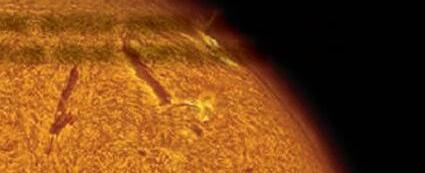













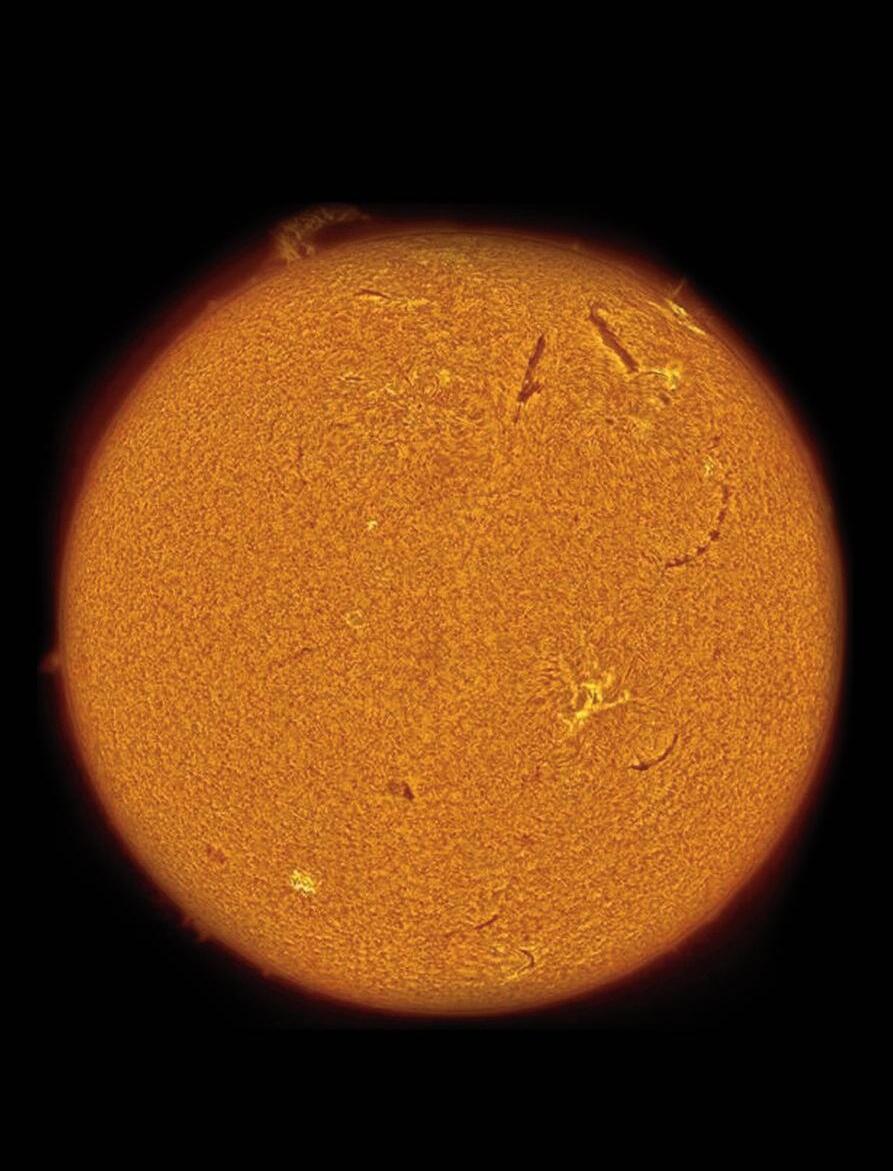
If instead you assemble the parts using the tube, you get a 2x Barlow lens which, when used with the regular supplied eyepiece, increases the Galileoscope’s magnification to 50x In addition to providing more detailed views of the Moon, Jupiter, and other targets, the Barlow lens will make plain the rings of Saturn. When Galileo looked at 20x to 30x, he couldn’t quite figure out that he was seeing a ringed planethe described Saturn as “tri-form ”
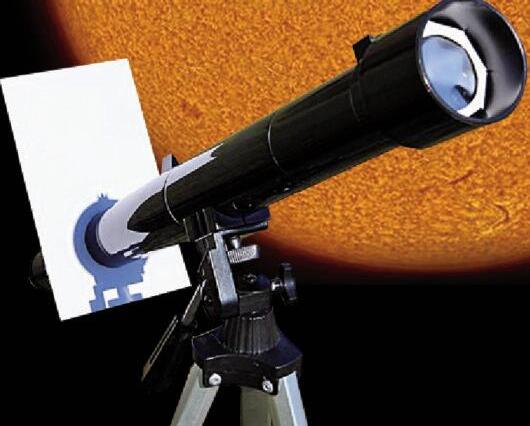
As experienced stargazers know, a telescope is only as good as its mounting. Because a telescope gives a highly magnified view, the tiniest vibration looks like a major earthquake in the eyepiece Even at a relatively modest 25x, the Galileoscope needs to be firmly attached to something stable. Because the instrument is so lightweight, an inexpensive photo tripod - the type you’ll find at most discount stores - should be sufficient The tripod should have a pan head that moves smoothly in altitude (up-
down) and azimuth (left-right), so that you can aim the telescope anywhere in the sky and make small adjustments without jerking things around

Looking for a cheap alternative to a tripod? Astronomy blogger Shannon Murphy (University of Michigan) has posted detailed instructions for building a cardboard box mount at https://aquillam wordpress com/2010/01/04/a-cheap-tripod-alternative.
To Close

The Galileoscope enables kids of all ages (adults included) to build and observe with a telescope similar to (but much better than) Galileo’s. Sharing these observations with as many people as possible, and encouraging parents, teachers, students, and others to think about their importance, addresses one of the main goals of the Galileoscope Initiative - to promote widespread access to new knowledge and obser ving experiences. With the new solar filters, a Galileoscope can now be used to study the Sun every day – and especially for the two eclipses coming up soon!

50 Solar Technology Today
GALILEOSCOPE TELESCOPE KITS WITH SOLAR FILTERS Volume 1 Issue 1 $6.00 US GALILEOSCOPE KITS WITH SOLAR FILTERS INDUSTRY NEWS • PRODUCT NEWS • ASTRO HUTECH HINODE SOLAR GUIDER SOLAR SNAP SMART PHONE IMAGER • AIRYLAB SOLAR SCINTILLATION MONITOR Your Complete Guide to Solar Astronomy Equipment DO YOU HAVE AN ARTICLE IDEA FOR US? IF SO, EMAIL US AT Your Complete Guide to Solar Astronomy Equipment www.solarastronomytoday.com

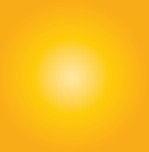













































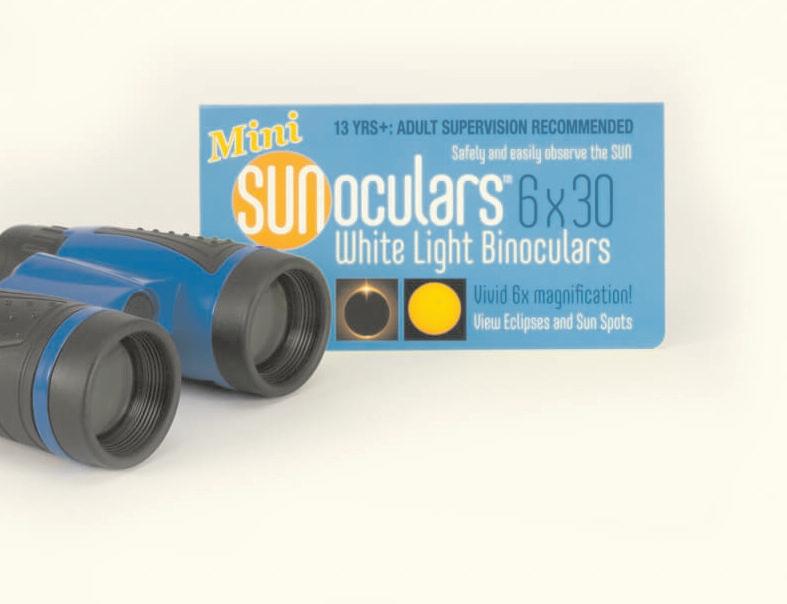

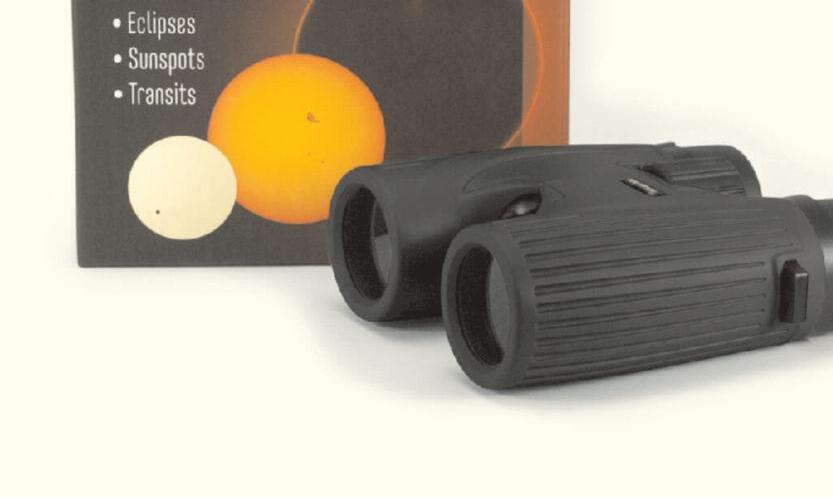




















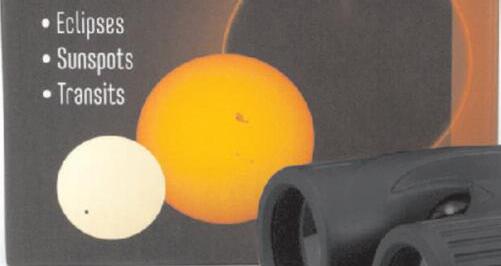


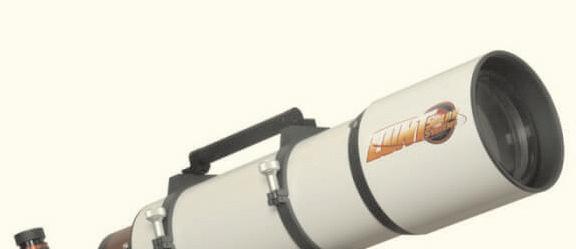
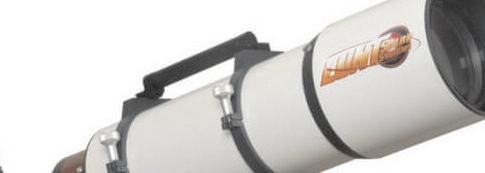



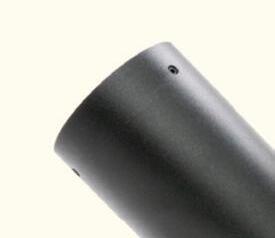





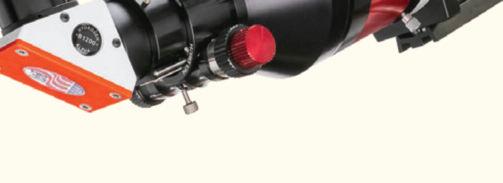


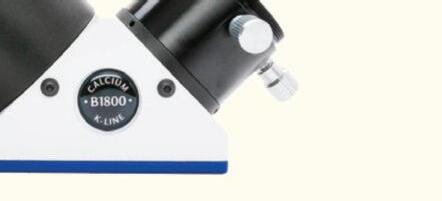
- A d L y t T l y s s ll p r “W - Andy L t every Tel sonally tes “We per t S l r Lunt t O f Lu p l c Lun u oom p r t hi f ter tha t h o d Fil t Solar t, Owner of L om t ships fr ter tha ope and Fil lesc t S l ” t Solar” un LLunt u t Solar” oops (LS152T) To © Eric Andyy u , L un t Solar nn
Explore The Sun
SUN CATCHER SOLAR GLASSES (4-PACK ASSORTMENT)
Watch the upcoming eclipses in safety, comfort, and style. Made with an advanced impregnated polymer filter material.
SUN CATCHER SOLAR FILTER
100% safe for solar viewing and available in sizes to fit a wide variety of telescopes.
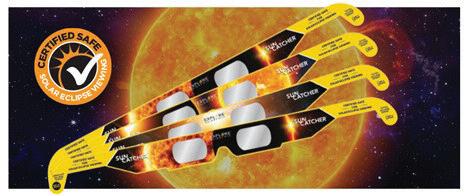
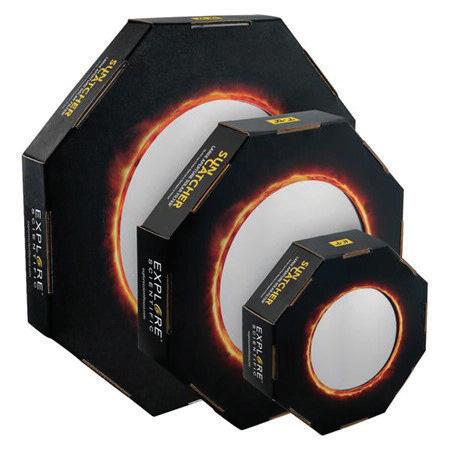
2020 Explore Scientific® All rights reserved. Purchase information and authorized dealer locater available at our website.
SOLAR ACCESSORIES
Solar filters for binoculars, solar filter film and much more!
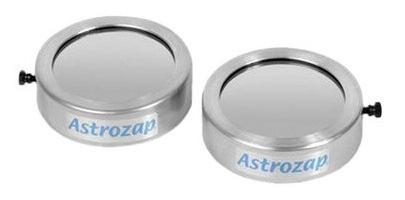
EXPLORE FIRSTLIGHT 80MM CF TELESCOPE
A complete go-to tracker combo with solar filter powered by the industry leading integrated Explore Scientific PMC-Eight™ system .

explorescientificusa.com
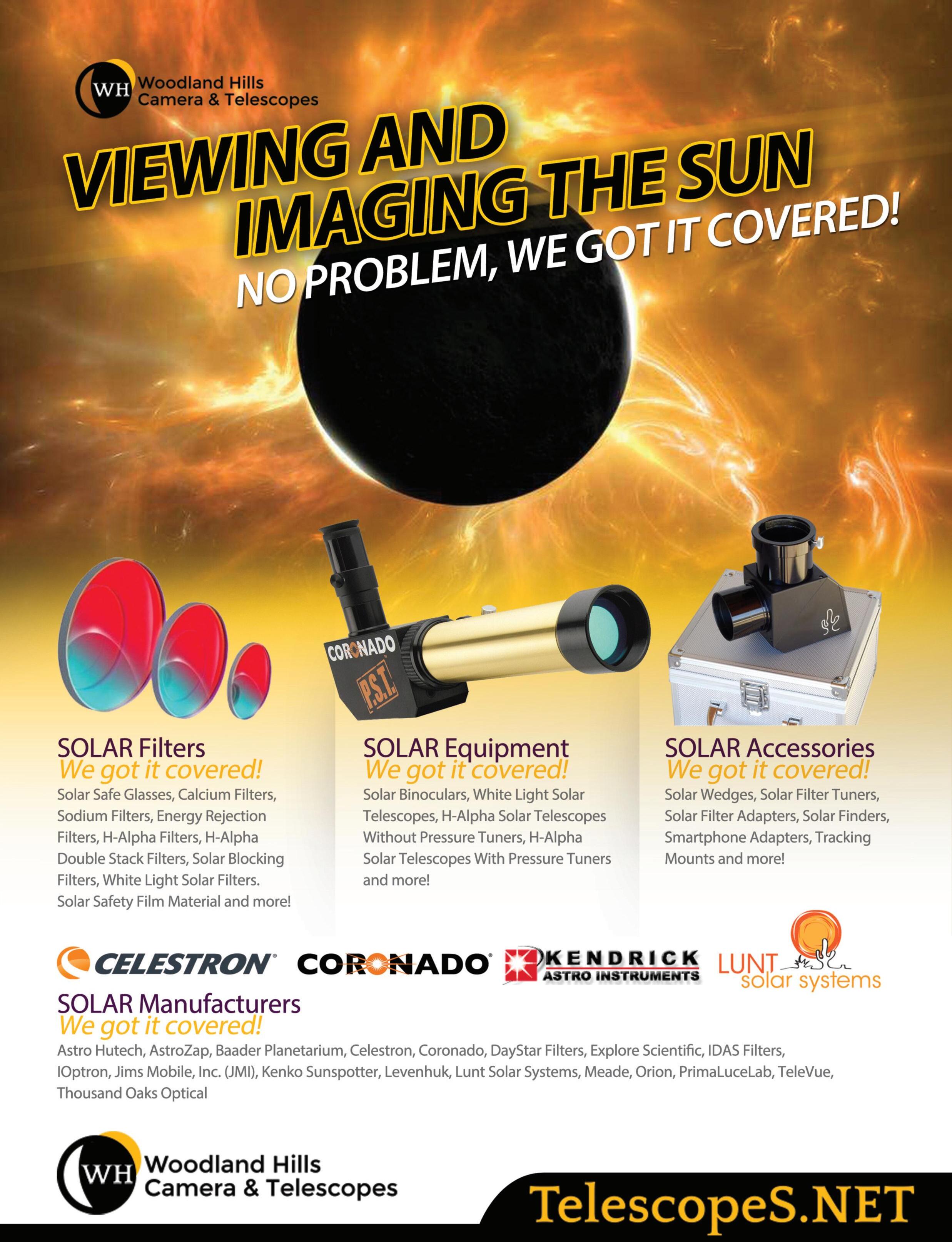
MAKING THE MOST OF THE UPCOMING 2023 AND 2024 SOLAR ECLIPSES
By Dr James Dire
I h a ve t r a ve l l e d a ro u n d t h e g l o b e t o s e e m y r i a d s o l a r e c l i p s e s ove r t h e c o u r s e of my life. These include five continents a n d c o u n t r i e s s u c h a s C h i n a , Ic e l a n d , Tu r k e y, a n d Z a m b i a , a n d t r o p i c a l i sl a n d s s u c h a s A r u b a a n d Ha w a i i ( t h e o ff i c i a l n a m e o f t h e B i g Is l a n d ) . It g o e s w i t h o u t s a y i n g t h a t I h a ve a l o t o f e x p erience planning these trips and knowing w h a t t y p i c a l l y g o e s r i g h t a n d w h a t c a n g o w ro n g .
I h a ve b e e n t h e l e a d e r o r c o - l e a d e r o f m a n y e c l i p s e e x p e d i t i o n s . T h e l a r g e s t h a d 6 1 0 p e o p l e o n t h re e c h a r t e re d a i rl i n e r s t o A r u b a i n 1 9 9 8 . T h e s m a l l e s t we re s e ve n m e m b e r t e a m s t o Za m b i a i n 2 0 0 1 a n d Tu rk e y i n 2 0 0 6
Fo r t h e Gr e a t A m e r i c a n S o l a r Ec l i p s e o n Au g u s t 1 7 , 2 0 1 7 , t h e re w a s n o c h o i c e f o r m e w h e re I w a n t e d t o b e : S a i n t Jo s e p h , M i s s o u r i . St . Jo e , a s w e c a l l i t , i s w h e r e I g r e w u p A l t h o u g h I h a v e n ' t l i v e d t h e r e s i n c e I g r a d u a t e d h i g h s c h o o l , m y p a re n t s s t i l l l i ve d t h e re
Image 1 - Matt Konon (red shirt), James Dire (green shirt) and Trey Gilliam (blue shirt) await second contact during the August 21, 2017 total solar eclipse The obser ving site was where the eclipse centerline intersected US Highway 50 (seen in the background below the tower) They photographed the eclipse with a Stellar vue 70mm f/6 Apo on an iOptron Cube Pro mount with a Canon 600D camera and a Canon 30D camera with a 70-200mm f/2.8 zoom lens on a tripod.

Solar Technology Today 55
i n 2 0 1 7 , a s we l l a s s i b l i n g s , f r i e n d s a n d m o re c o u s i n s t h a n I c a n c o u n t W h e n I f i r s t l e a r n e d s e v e r a l d e c a d e s b a c k t h a t t h e c e n t e r l i n e o f t h e 2 0 1 7 s o l a r e c l i p s e w o u l d p a s s t h r o u g h St . Jo s e p h , t h e r e
w a s n e v e r a n y q u e s t i o n i n m y m i n d I w o u l d g o t h e r e f o r t h e e c l i p s e , f o r t y y e a r s a f t e r I g r a d u a t e d f r o m St . Jo e ' s
C e n t r a l Hi g h S c h o o l Mo s t o f m y u s u a l c r i t e r i a f o r t h e
b e s t s p o t t o g o f o r a n e c l i p s e i n c l u d e i n n o p a r t i c u l a r o rd e r :
• E a s e t o g e t t h e re f ro m p o i n t s f a r a w a y.
• We a t h e r p ro s p e c t f o r t h e s i t e .
• E a s e t o re l o c a t e i f t h e l a s t - m i n u t e we a t h e r f o re c a s t i s p o o r.
• L e n g t h o f t o t a l i t y c o m p a re d t o o t h e r s i t e s . I f l e w i n t o M i s s o u r i f o r t h e 2 0 1 7 e c l i p s e My b r o t h e r a n d h i s w i f e d r ov e u p f r o m Te x a s a n d m y n i e c e ’ s s t e p s o n d r ov e i n f r o m Ok l a h o m a So m e f r i e n d s o f m i n e f l e w d o w n f r o m Ju n e a u ,

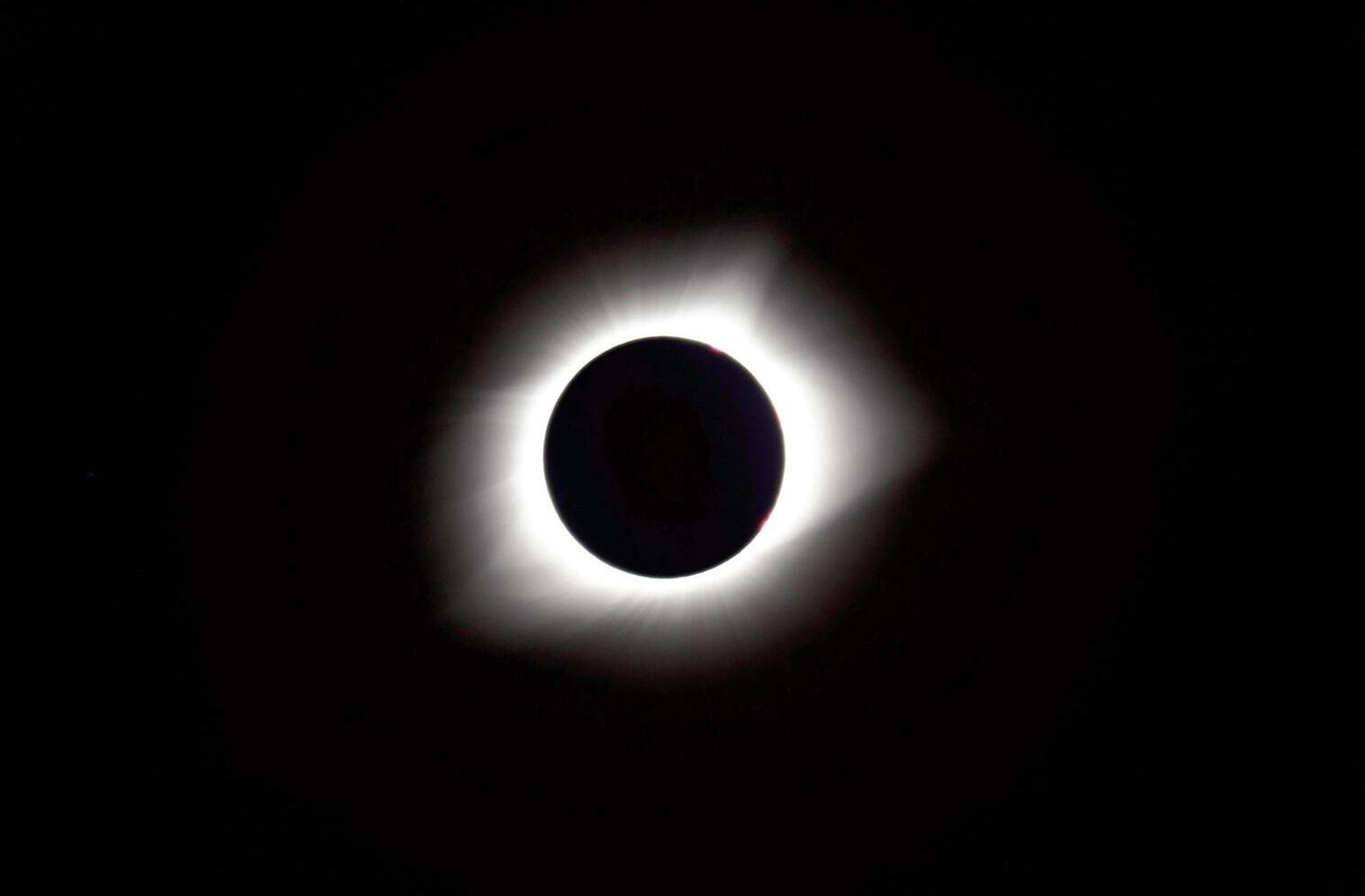
A l a s k a w i t h t h e i r t w o y o u n g d a u g h t e r s . We w e r e a l l e a g e r t o s e e t h e Gr e a t
A m e r i c a n E c l i p s e . Mo s t o f t h e t i m e s I h a v e t r a v e l l e d a r o u n d t h e g l o b e t o s e e a n e c l i p s e t h e w e a t h e r c o o p e r a t e d . Un f o r t u n a t e l y, t h e d a y b e f o r e t h e e c l i p s e , t h u n d e r s t o r m s w e r e p r e d i c t e d i n St . Jo s e p h d u r i n g t h e e a r l y a f t e r n o o n e c l i p s e . I h a d t w o b a c k u p s i t e s s e l e c t e d , o n e e a s t a n d o n e w e s t , b o t h u n d e r a s i x - h o u r d r i v e .
T h e d a y o f t h e e c l i p s e , I a w o k e a t 5 : 0 0 a m t o c h e c k t h e we a t h e r f o re c a s t f o r St
Jo s e p h . It s t i l l w a s n o t g o o d . It d i d n ’ t l o o k b e t t e r f o r t h e b a c k u p s i t e t o t h e
w e s t , b u t w a s f a v o r a b l e a t t h e b a c k u p s i t e t o t h e e a s t b e t w e e n Je f f e r s o n C i t y a n d St L o u i s I c a l l e d a n d a w a k e n e d e v e r y o n e i n m y g r o u p a n d t o l d t h e m t o b e r e a d y t o r o l l a t 6 : 0 0 a m Ev e r y b o d y, e x c e p t m y n i e c e ’ s s t e p s o n a n d m y f r i e n d s f r o m A l a s k a , d e c i d e d t o s t a y i n St Jo s e p h f o r t h e e c l i p s e a n d t a k e t h e i r c h a n c e s w i t h t h e w e a t h e r. T h e y s a w n o t h i n g b u t c l o u d s d u r i n g t h e e c l i p s e T h e r e s t o f u s t o o k o f f i n t w o v e h i c l e s t r a v e l l i n g e a s t t o w h e r e t h e c e n t e r l i n e c r o s s e d U S
Hi g h w a y 5 0 .
O n t h e d r i v e s o u t h d o w n I - 2 9 t o -
56 Solar Technology Today MAKING THE MOST OF THE UPCOMING 2023 AND 2024 SOLAR ECLIPSES
Image 2 - 2017 total solar eclipse, mid eclipse, shot with a Stellar vue 70mm f/6 Apo on an iOptron Cube Pro mount with a Canon 600D camera. The exposure was 1/25s at ISO 200.
Image 3 - 2017 total solar eclipse, just before third contac, shot with a Stellar vue 70mm f/6 Apo on an iOptron Cube Pro mount with a Canon 600D camera. The exposure was 1/125s at ISO 200.
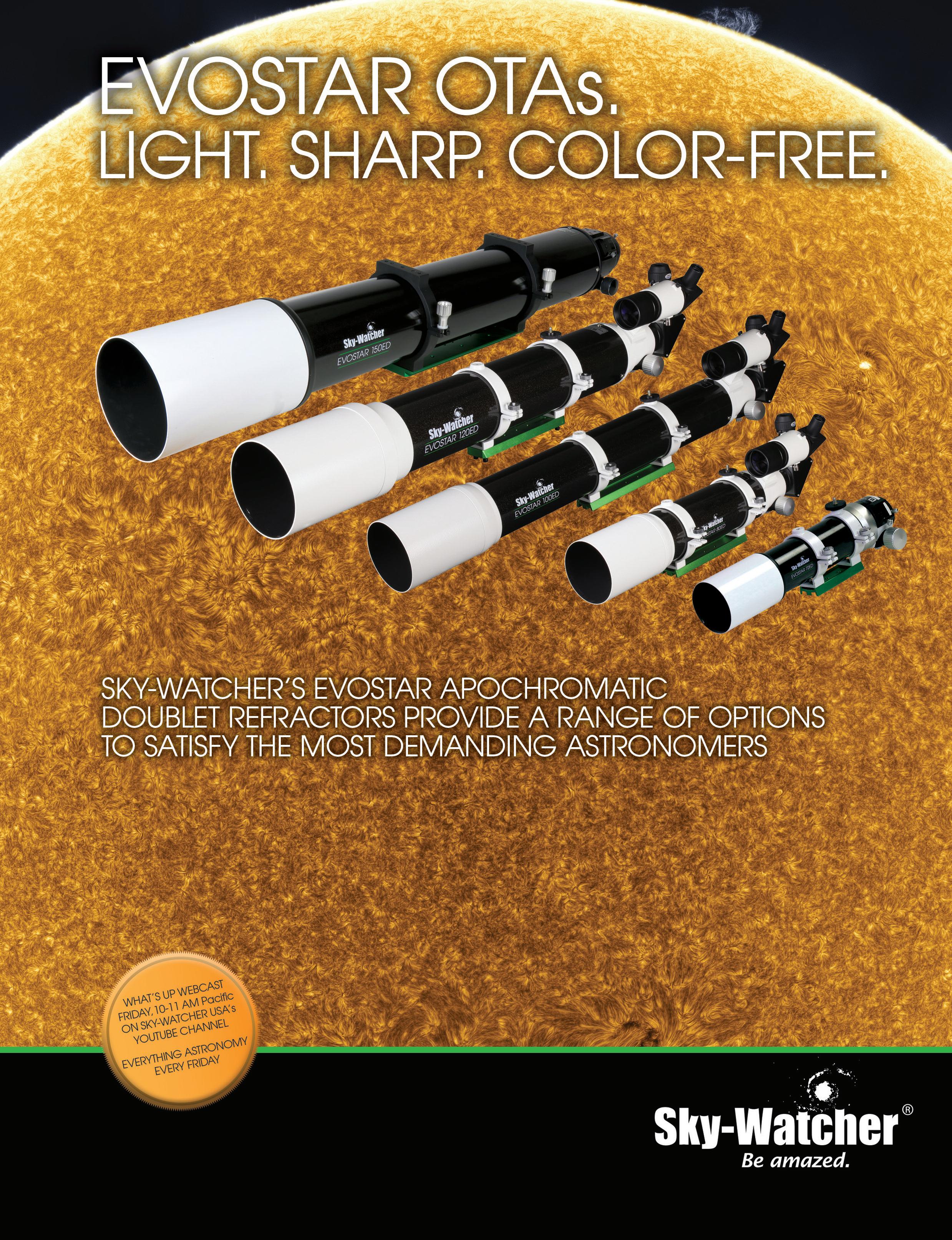



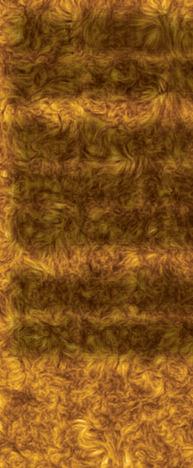












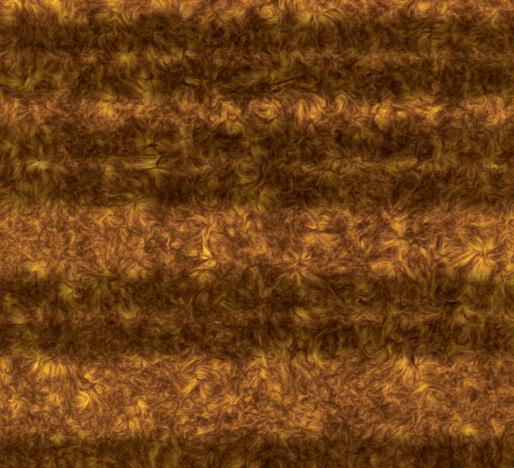








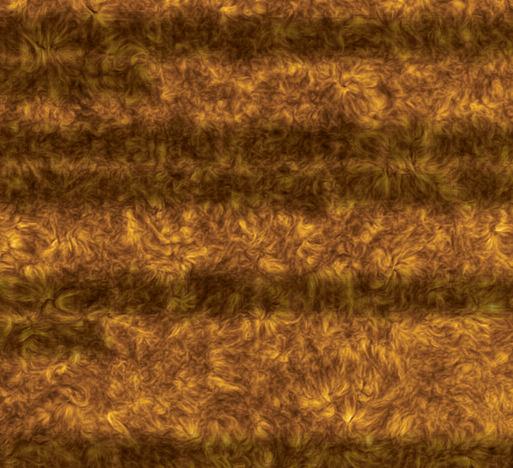
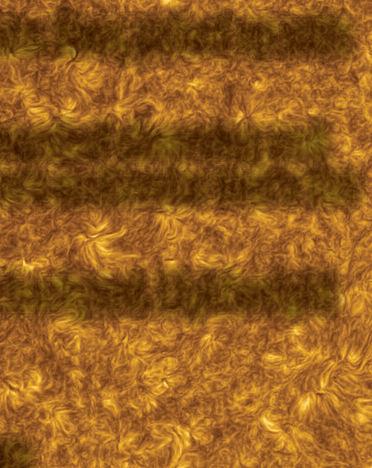











































g c s r t r e S E U T B US : M NINGR WA n m r y e o l e l o R A L O E S AT I PPROPR E A H H T T I D W E e r a s c o e f n o t IN AG IM / ING W IE E V F A R S O R F E LT IF m n a r u n a G b nformat r i Fo vic er d s n s a roduct r p u f o l o l n a n o io onD y-Wa k d S uthorize n a d a in o f r t , o es , F ouTube n Y s o ow u oll o f t t orge t f ’ w w isit t v us , j ou r y ea r n eale r d tche am! agr t ns d I n , a Facebook .watcherusa.com y w.sk
70-200mm
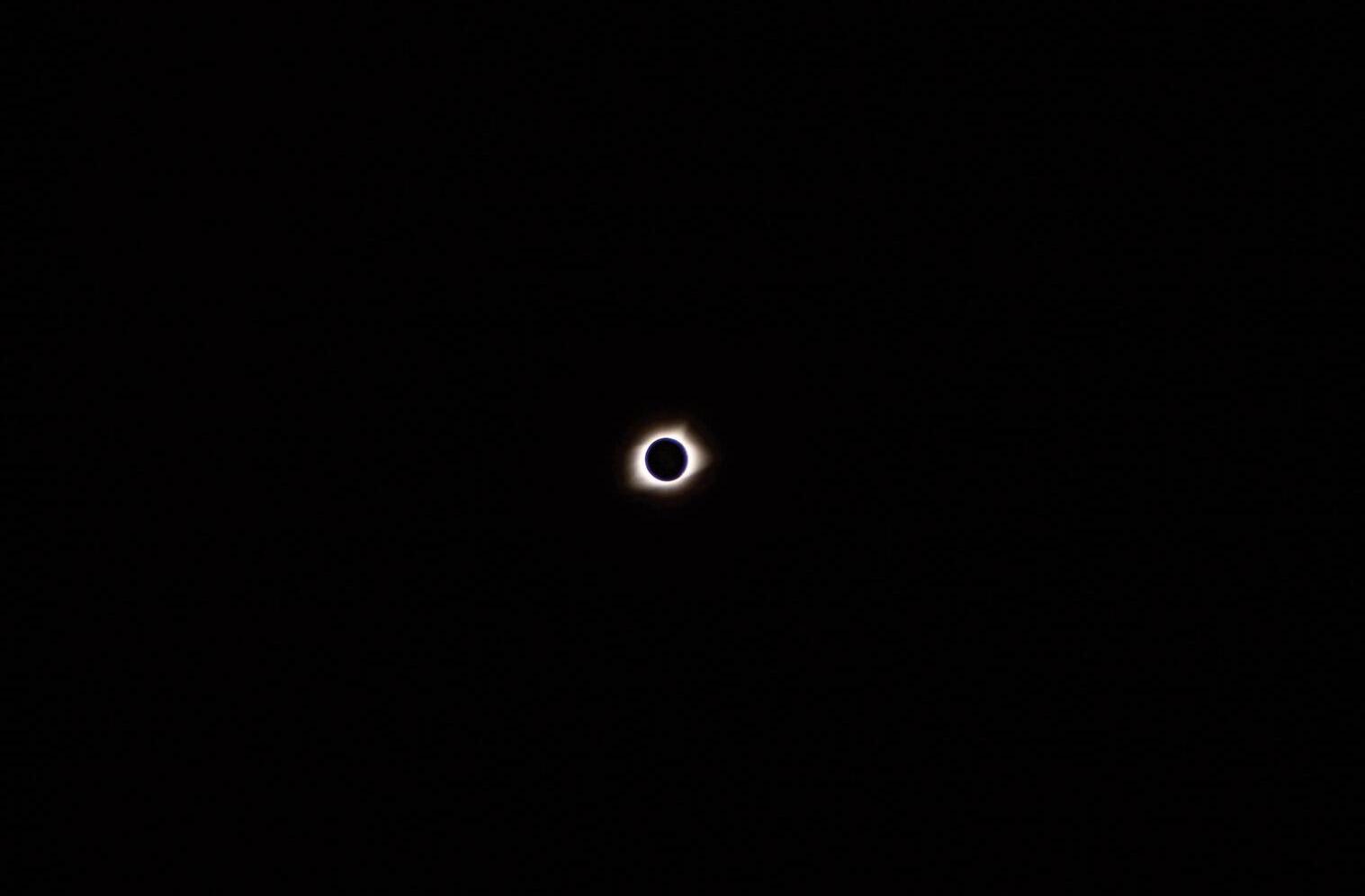
Image 5 - The author awaits second contact at 8000 feet elevation east of Bella Vista, Argentina during the July 2, 2019 total solar eclipse. He is photographing the eclipse with a Stellar vue 70mm f/6 Apo on an iOptron Cube Pro mount with a Canon 600D camera. Note in the distance the dust over Bella Vista in the valley below the ridge we were on.
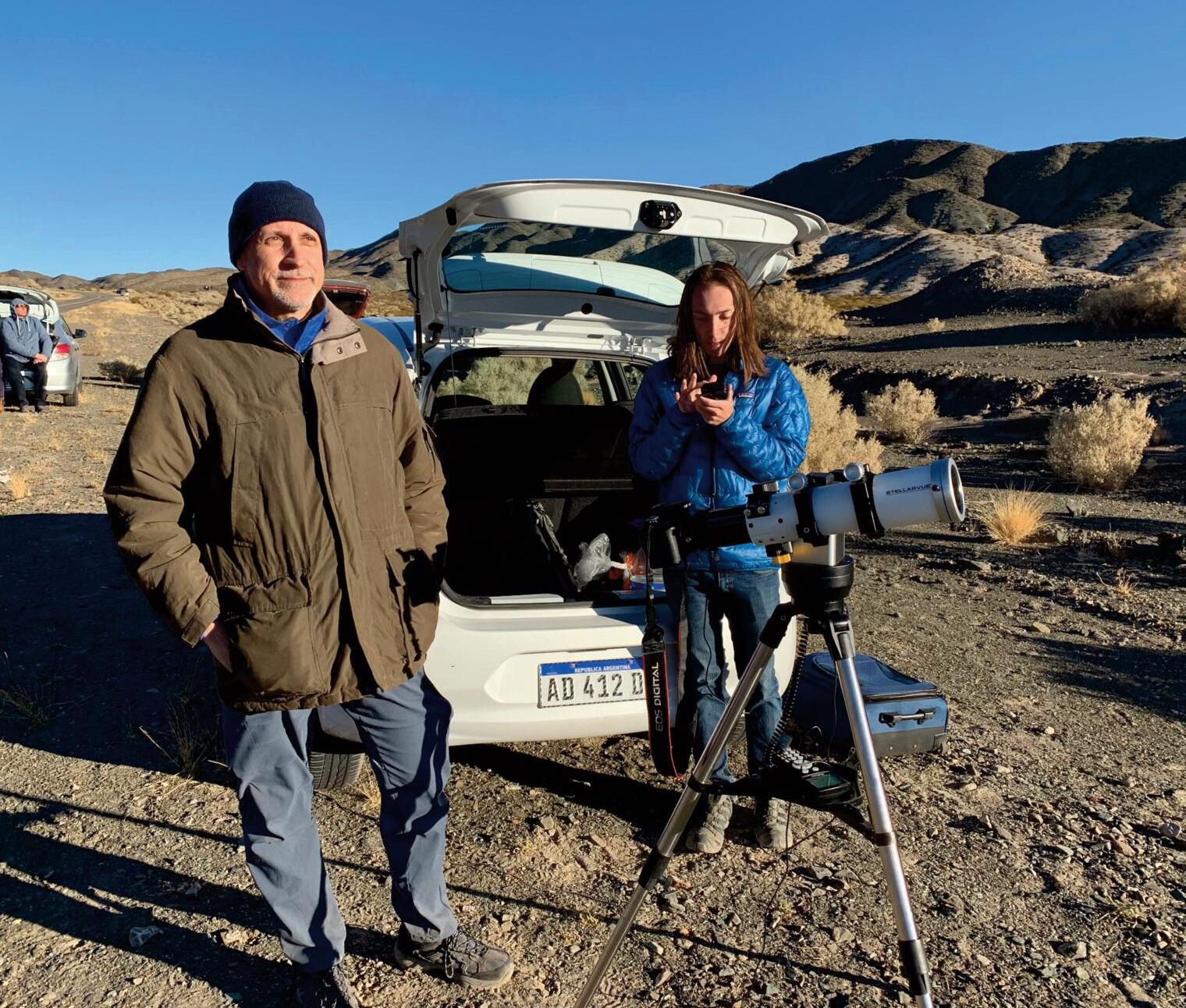
w a r d s K a n s a s C i t y, w e o b s e r v e d u nu s u a l l y h e a v y t r a f f i c h e a d i n g t h e o t h e r
w a y f r o m K a n s a s C i t y i n t o St Jo s e p h
I k n o w St . Jo s e p h w a s o n t h e c e n t e r -
l i n e . B u t I k e p t t h i n k i n g : “ w h y d i d n ’ t t h e s e p e o p l e c h e c k t h e w e a t h e r f o r ec a s t ? ” T h e y s h o u l d h a v e b e e n h e a d i n g e a s t o u t o f K a n s a s C i t y t o w a r d s St
L o u i s . Su r p r i s i n g l y, w h e n w e m a d e t h e e x c h a n g e t o I - 7 0 e a s t n e a r I n d ep e n d e n c e , M i s s o u r i , w e e n c o u n t e r e d v e r y l i t t l e t r a f f i c h e a d i n g i n t h a t d i r e ct i o n T h e c l o s e r w e g o t t o o u r d e s t i n at i o n , t h e f e w e r c l o u d s w e r e a b o v e u s .
A n o t h e r c a r j o i n e d u s i n Je f f e r s o n C i t y w i t h a h i g h s c h o o l f r i e n d , h e r b o y f r i e n d a n d d o g . S o o u r c a r a v a n w a s n o w t h r e e v e h i c l e s We h a d p l a n n e d t o c o n d u c t s o m e e x p e r i m e n t s d u r i n g t h e e c l i p s e t h a t r eq u i r e d h o u r s t o s e t u p . S i n c e w e d i d n o t a r r i v e w i t h e n o u g h t i m e t o s e t e v e r y t h i n g u p, w e d e c i d e d t o o n l y p h ot o g r a p h a n d w a t c h t h e e c l i p s e . We a rr i v e d a t t h e t i m e o f f i r s t c o n t a c t ( t h e s t a r o f t h e p a r t i a l e c l i p s e ) a n d s e t u p t w o c a m e r a s ( I m a g e 1 ) . I m a g e 2 i s a p h o t o i n t h e e c l i p s e d u r i n g t h e m i d d l e o f t h e t o t a l e c l i p s e p h a s e . T h e c o r o n a l r a y s a n d a r c s w e r e m a g n i f i c e n t ! I m a g e 3 i s a s h o r t e x p os u re o f t h e e c l i p s e t a k e n s e c o n d s b e f o re t h i r d c o n t a c t ( w h e n t h e Mo o n s t o p s c o v e r i n g t h e e n t i r e Su n ) c a p t u r i n g s o m e p i n k s o l a r p r o m i n e n c e s a n d a b i t o f t h e Su n ’ s p i n k c h r o m o s p h e r e T h e s e t w o i m a g e s w e r e c a p t u r e d w i t h a s m a l l t e l e s c o p e . T h e n e x t p i c t u r e ( I m a g e 4 ) w a s t a k e n w i t h a c a m e r a a n d z o o m l e n s o n a t r i p o d .
A f t e r t h e e c l i p s e e n d e d , I d r o v e b a c k t o St . Jo s e p h , d o d g i n g a r e a s o f s t r o n g t h u n d e r s t o r m s t h e e n t i r e w a y
58 Solar Technology Today MAKING THE MOST OF THE UPCOMING 2023 AND 2024 SOLAR ECLIPSES
Image 4 - 2017 total solar eclipse, mid eclipse, shot with a Canon 30D camera with a
f/2.8 zoom lens on a tripod. The lens was set at 70mm f/4. The exposure was not recorded.
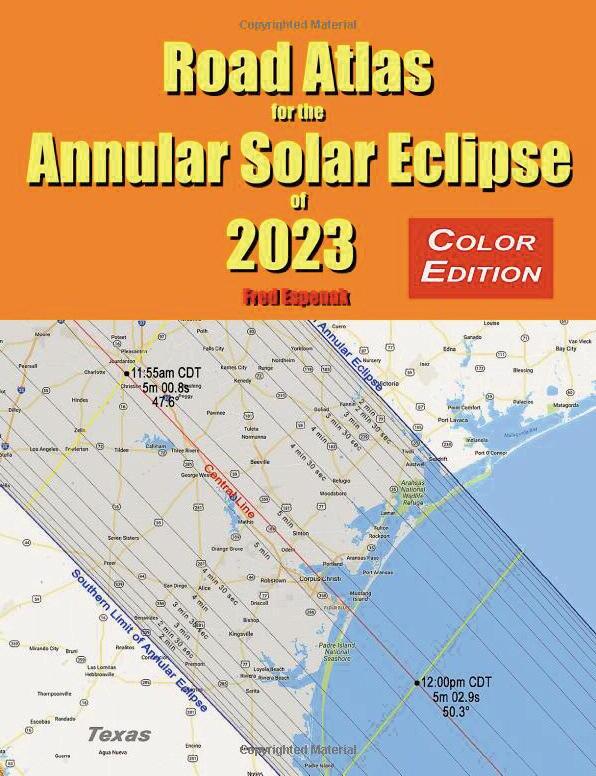
www.greatamericaneclipse.com
h o m e . S e v e r a l p e o p l e s c a t t e r e d b e t w e e n Je f f e r s o n C i t y a n d St Jo s e p h s a w t h e e c l i p s e i n b re a k s i n t h e c l o u d s Mo s t w e re c l o u d e d o u t , e x c e p t C o l u m b i a a n d Je f f e r s o n C i t y, w h i c h w e r e a l s o c l e a r. My n e x t s o l a r e c l i p s e w a s o n Ju l y 2 , 2 0 1 9 T h i s e c l i p s e p a t h o n l y c r o s s e d l a n d i n C h i l e a n d A r g e n t i n a . T h e c l i m a t e d a t a i n d i c a t e d t h a t B e l l a V i s t a , A r g e n t i n a h a d t h e b e s t c h a n c e s f o r c l e a r s k i e s d u r i n g t h e e c l i p s e , s o t h a t ’ s w h e r e w e h e a d e d . My w i f e a n d I f l e w f r o m C h i c a g o t o Me n d o z a , A rg e n t i n a w i t h o n e s t o p i n Pa n a m a C i t y, Pa n a m a
It w a s a n a f t e r n o o n e c l i p s e . S o , t o b e a t t r a f f i c , w e d ep a r t e d Me n d o z a t o B e l l a V i s t a e a r l y i n t h e m o r n i n g . We a ct u a l l y d i d n o t s e t u p i n t h e B e l l a V i s t a v a l l e y, b u t o n t h e r i d g e t o t h e e a s t a t 8 , 0 0 0 f e e t e l e v a t i o n . T h i s w o u l d a f f o rd u s a s p e c t a c u l a r v i e w o f t h e l a t e a f t e r n o o n t o t a l s o l a r e c l i p s e ov e r t h e s n o w c a p p e d p e a k s o f t h e A n d e s Mo u n t a i n s t o t h e w e s t . O u r s i t e w a s w h e r e t h e e c l i p s e c e n t e r l i n e c r o s s e d A rg e n t i n a Hi g h w a y 1 4 9 ( I m a g e 5 )
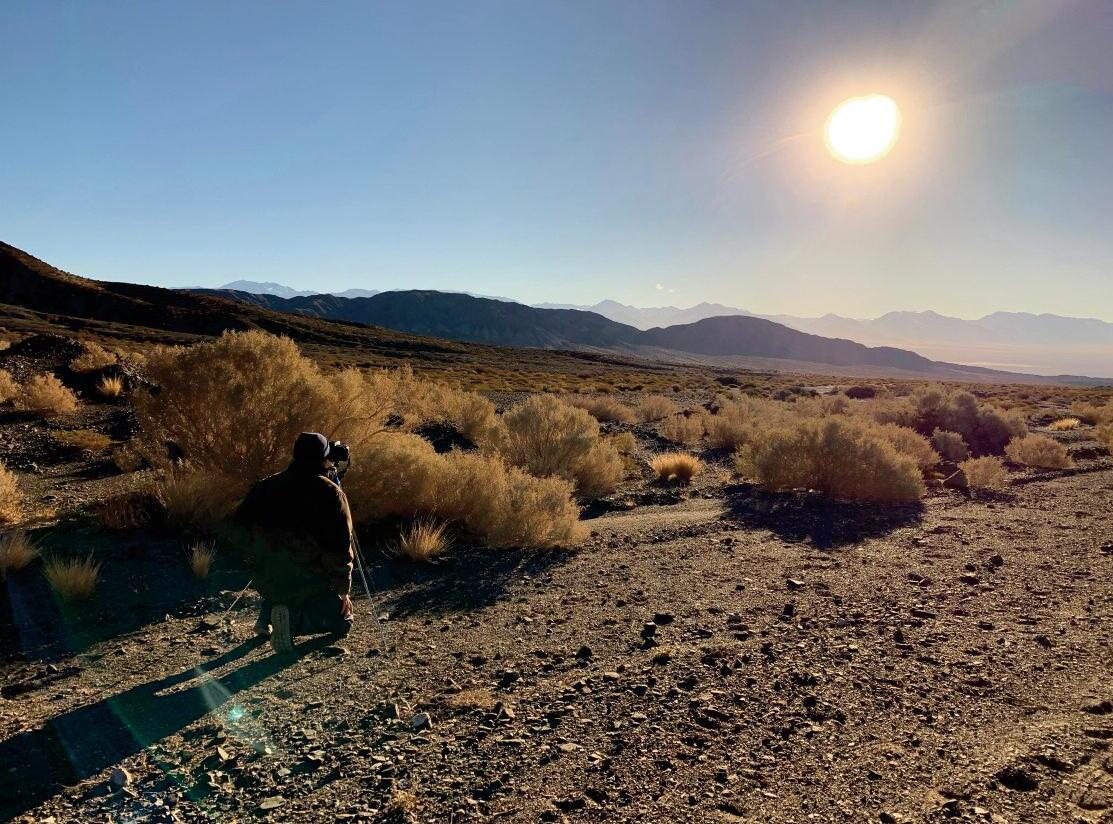
Te n s o f t h o u s a n d s o f e c l i p s e c h a s e r s g a t h e r e d i n B e l l a V i s t a , o n l y t o e x p e r i e n c e a d u s t s t o r m t h a t h i n d e r e d t h e i r v i e w o f t h e e c l i p s e ( I m a g e 6 ) We c o u l d s e e t h e d u s t c l o u d i n t h e v a l l e y b e l o w u s . Fo r t u n a t e l y, w e w e r e a b ov e i t w i t h n o t h i n g a b ov e u s b u t c l e a r b l u e s k i e s
I m a g e 7 i s a m o n t a g e o f t h e p a r t i a l a n d t o t a l p h a s e s o f t h i s s o l a r e c l i p s e . T h e Su n s e t b e f o r e t h e p a r t i a l e c l i p s e e n d e d ( c a l l e d f o u r t h c o n t a c t ) Bu t w e s a w a l l t h e s p l e n d o r o f t o t a l i t y. I h a d p l a n n e d t h i s t r i p f o r y e a r s i n a d v a n c e . My d e -

60 Solar Technology Today
MAKING THE MOST OF THE UPCOMING 2023 AND 2024 SOLAR ECLIPSES
Image 6 - Just before second contact during the July 2, 2019 total solar eclipse, the author frames a camera on a tripod for a wide-field picture of the total solar eclipse.


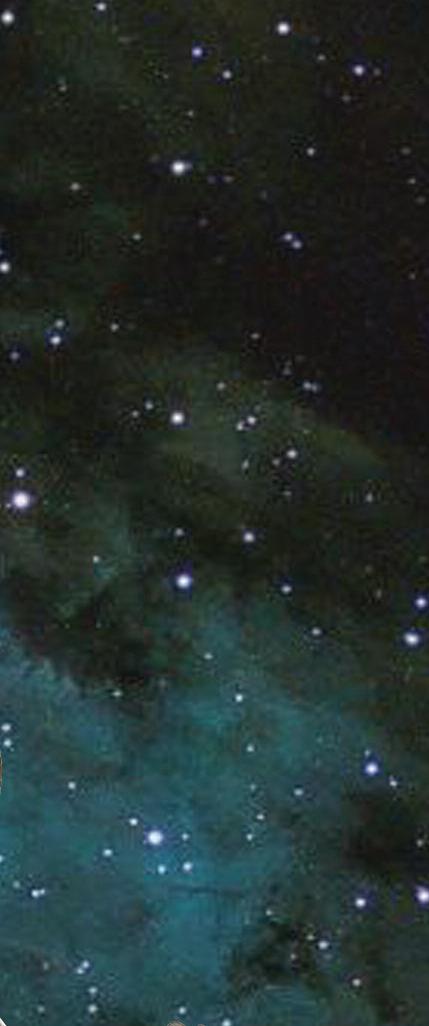


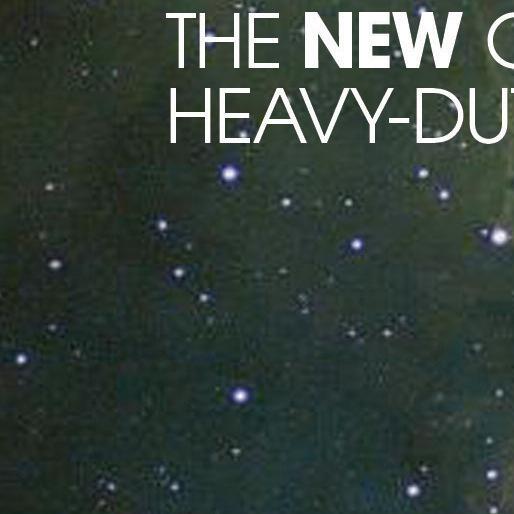



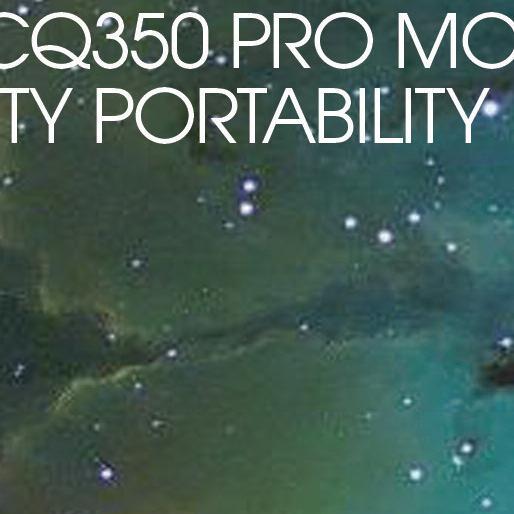

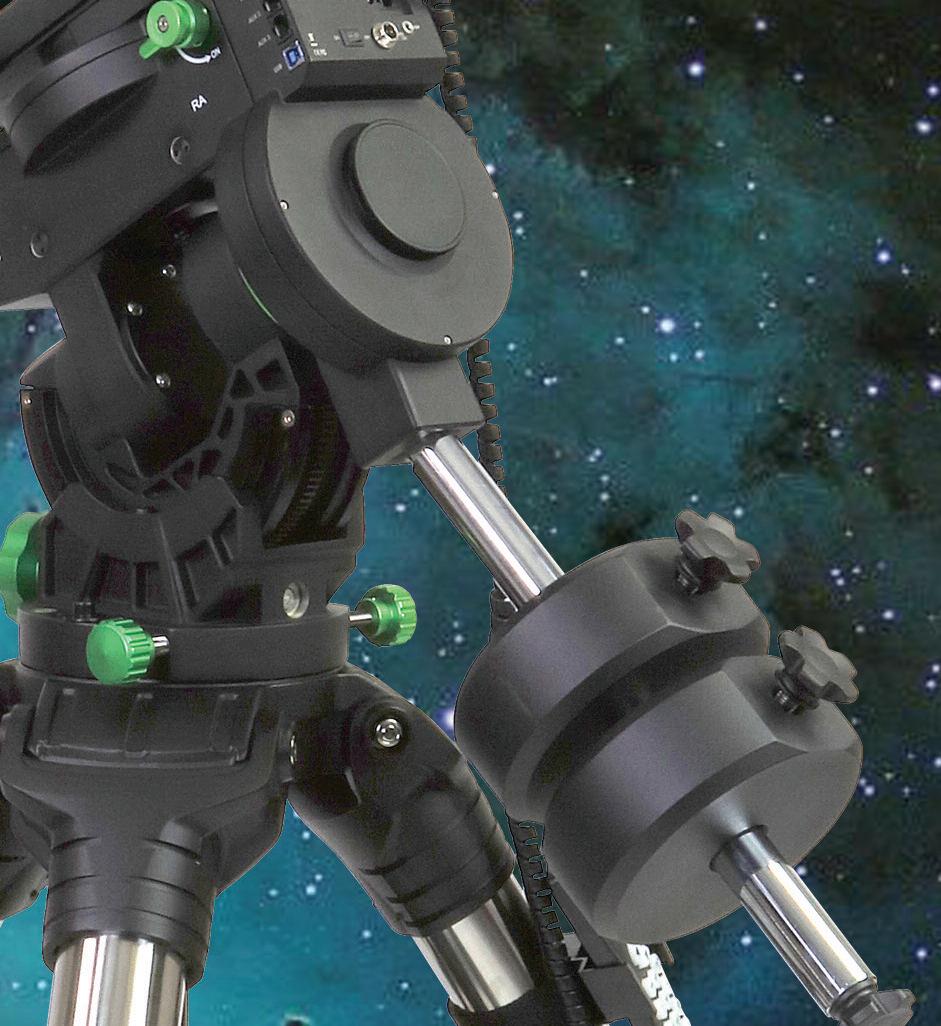
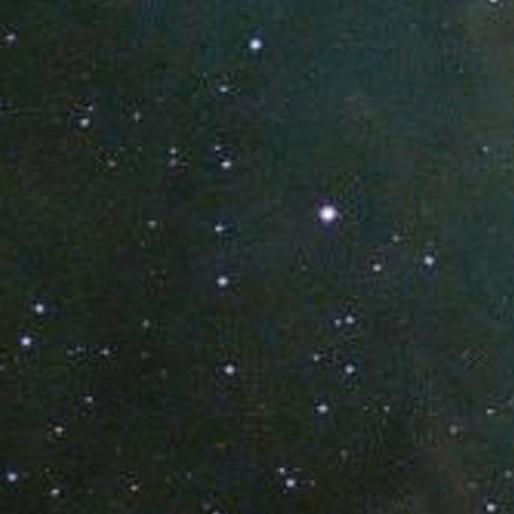
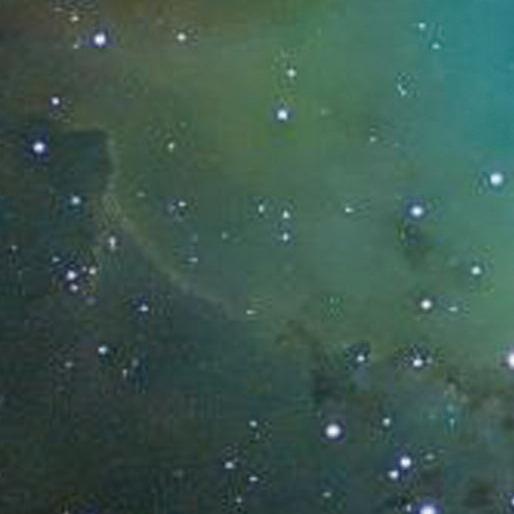
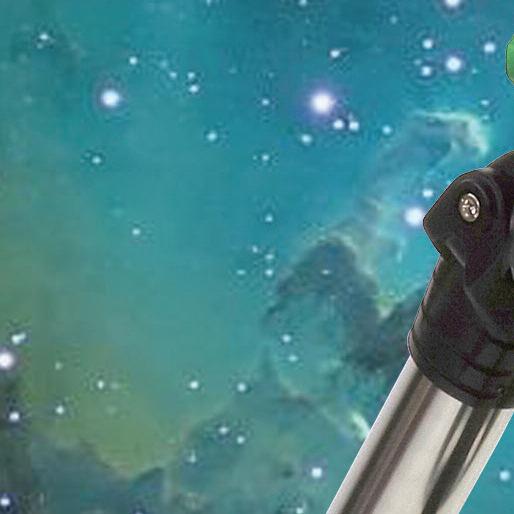



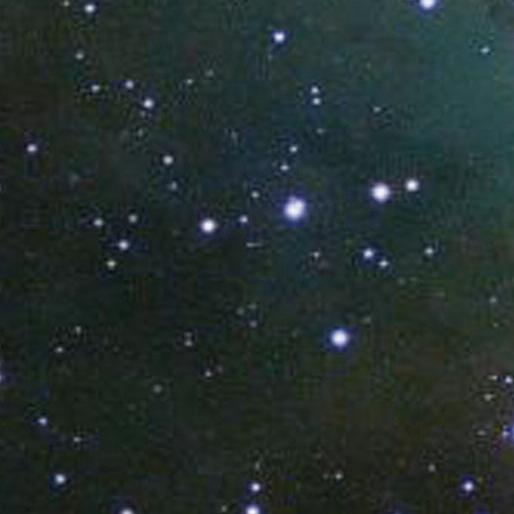





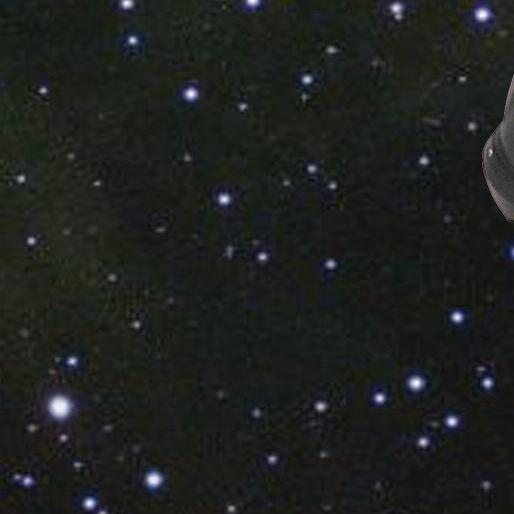
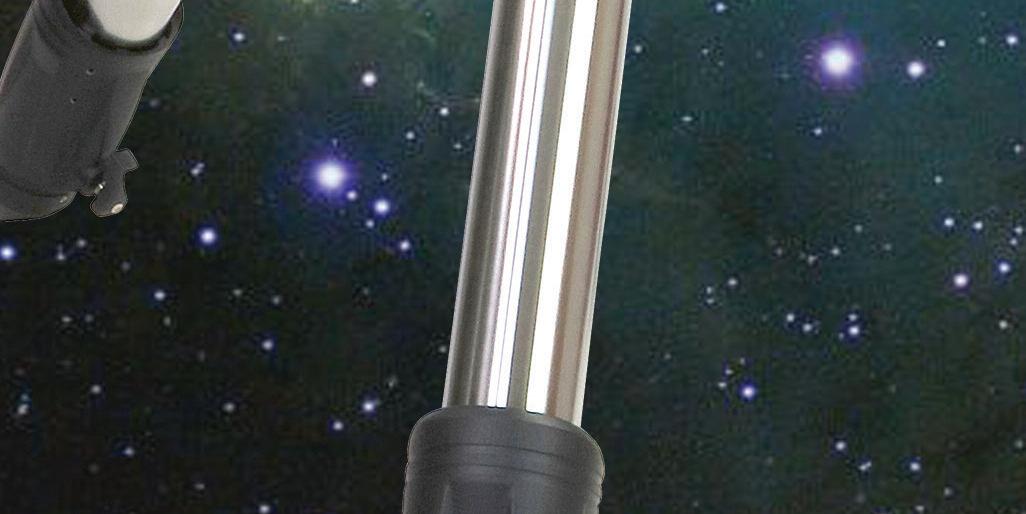
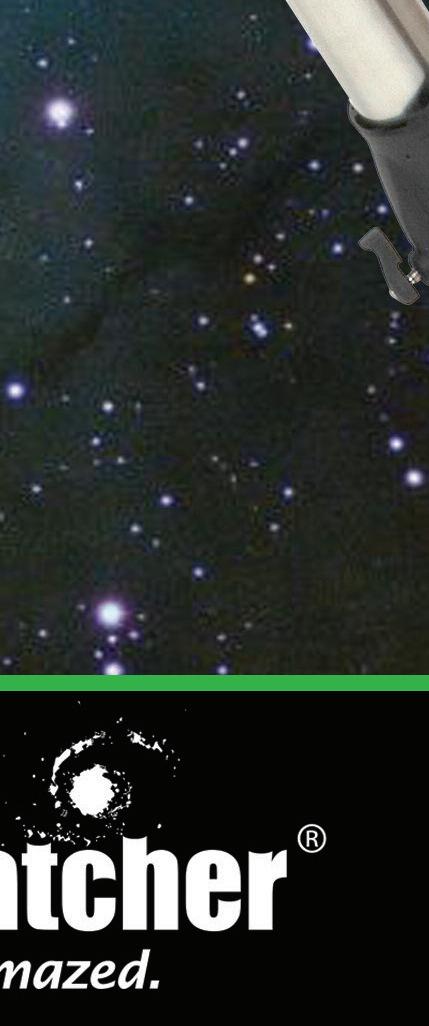
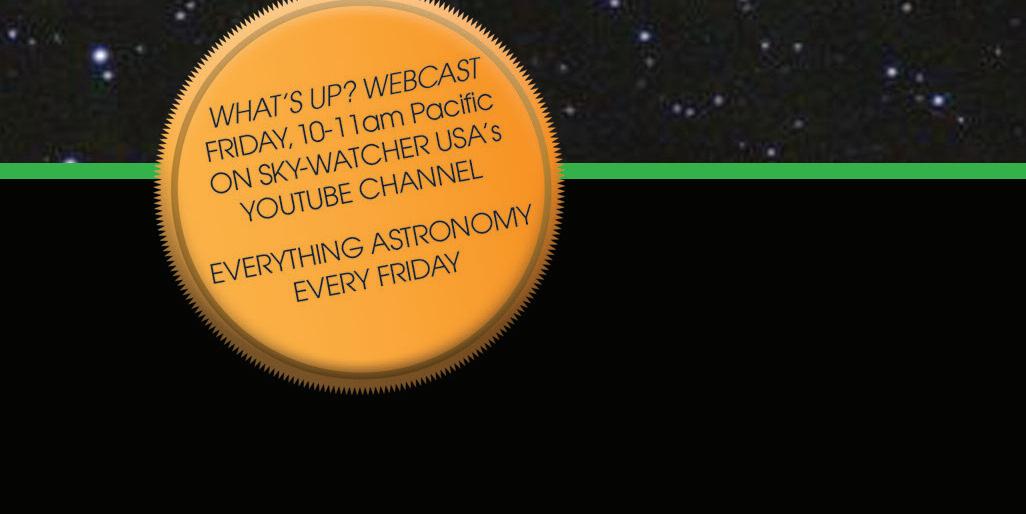





t d g s a c o a r t t u g o eadin e h r you a n h p . A u o o d t ee t n us r j e o it g s vin bser e o remot l etup r s ou e y ovm s a n a m e c mo e m s r n A a , D c k h n t e i ’ f yo o i S d g a d e e k a D s ble t it r a l t f a s h b , i d a r t r d g y u
Image 7 - All the phases of the July 2, 2019 total solar eclipse. First contact is the image on the upper right. In the image on the lower left, the partially eclipsed Sun sets behind a mountain peak.
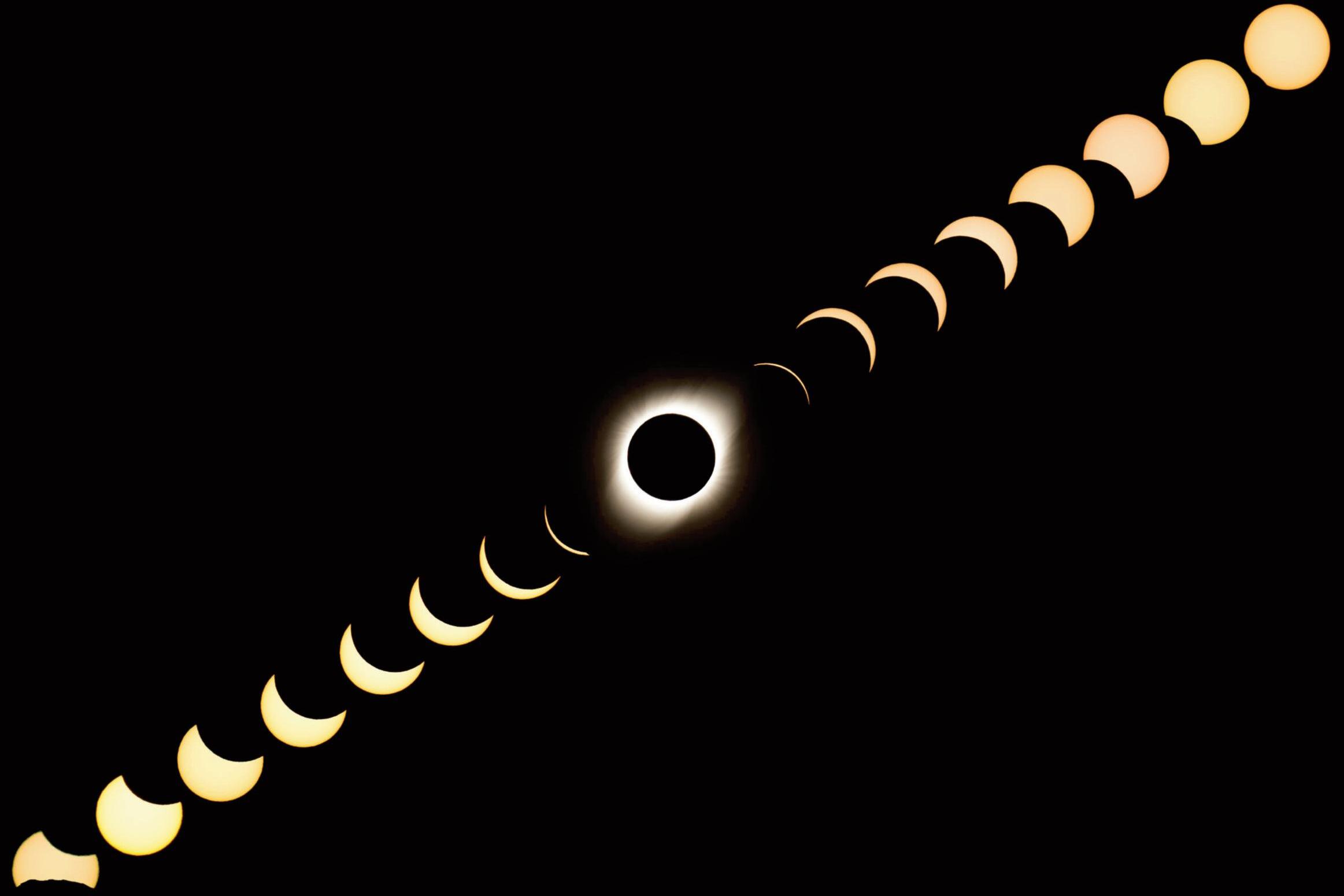
s i r e w a s t o c a p t u r e a w i d e - f i e l d p i c t u r e o f t h e s o l a r c o r o n a ov e r t h e A n d e s . My p i c t u r e a p p e a r s i n I m a g e 8 !
T h e C OV I D - 1 9 p a n d e m i c f o r c e d
u s t o c a n c e l o u r n e x t s o l a r e c l i p s e t r i p. S o w e a r e e a g e r l y a w a i t i n g t h e s e c o n d
Gr e a t A m e r i c a n S o l a r E c l i p s e i n A p r i l
o f 2 0 2 4 . A s a w a r m u p f o r t h a t e c l i p s e ,
t h e r e i s a s p l e n d i d a n n u l a r e c l i p s e i n t h e U . S . s i x m o n t h s b e f o r e t h e 2 0 2 4
t o t a l s o l a r e c l i p s e Im a g e 9 s h ow s t h e p a t h s o f b o t h o f

MAKING THE MOST OF THE UPCOMING 2023 AND 2024 SOLAR ECLIPSES 62 Solar Technology Today
The Clearest View.

SUPERCHARGED BY DESIGN



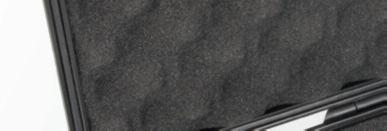

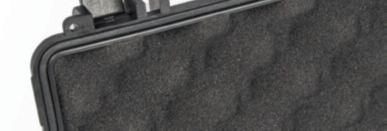



















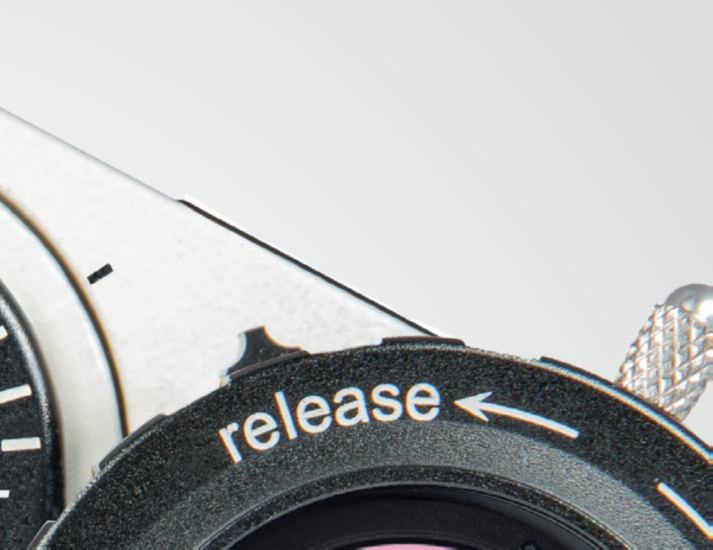
The MaxBright® II Binoviewer is innovative and unique in many ways: The body features a non-slip leatherette cover. ClickLock® clamps with integrated diopter adjustment make changing eyepieces a joy. Two telescope adapter solutions are supplied, first a T-2 collet and second the optional time-proven Zeiss stainless-steel ring-dovetail. This makes the MaxBright® II the most advanced “fit all” product in this industry.

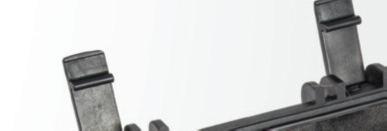
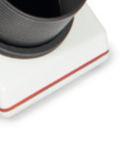
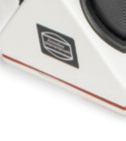



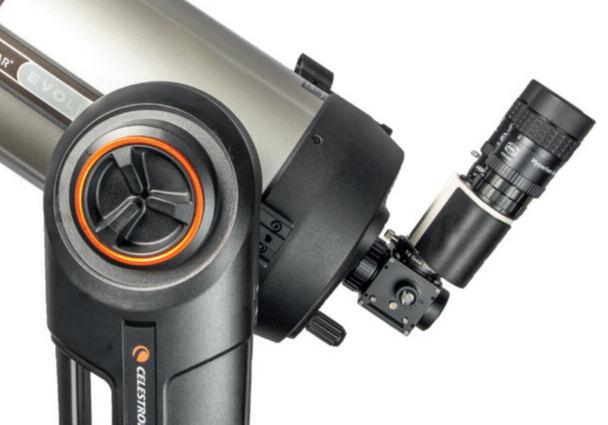
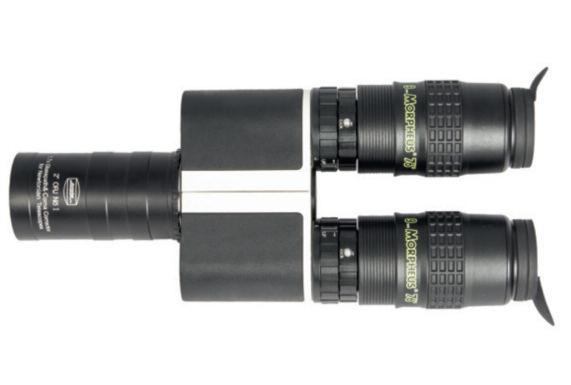

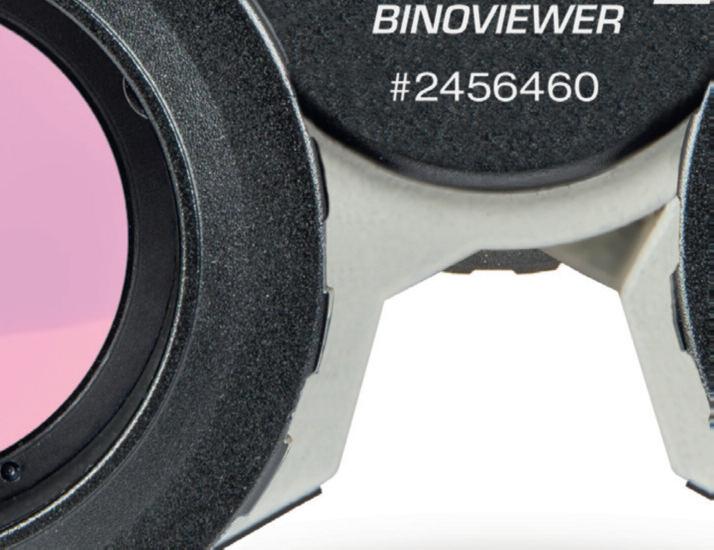

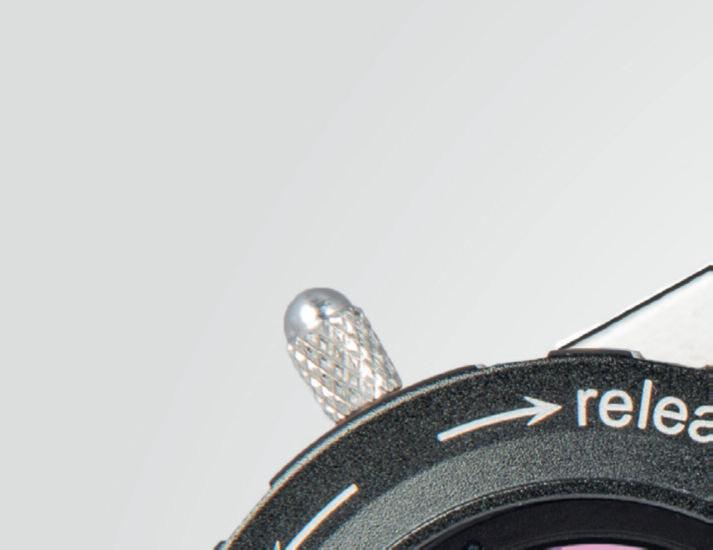
All the above is pointless though – without outstanding optics. All the experience of 30 years production of the Baader Giant Mark V binocular has moved into the MaxBright® II. Phantom-Group coated prisms of 27 mm in size provide 26 mm and 25,5 mm clear aperture. Even 35mm eyepieces do not show any vignetting. Enjoy highest magnification or wide field viewing in greatest comfort – and make the universe gain in depth.

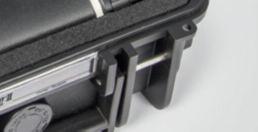
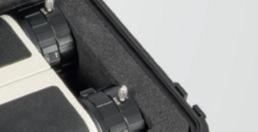

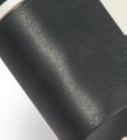






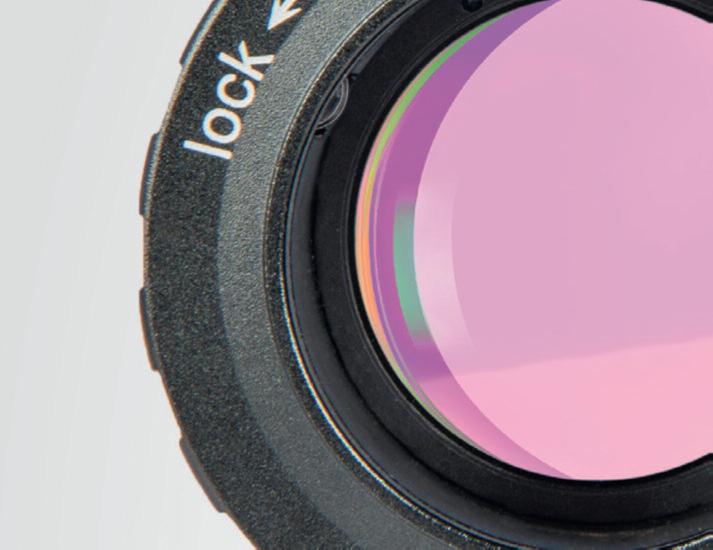

www.alpineastro.com Distributing Baader Planetarium products for more than 19years Discover all features: W e r ese r v e the r ig h ts f or e r r or s , p r c e and t echnical change s G
# 2456460
MAKING THE MOST OF THE UPCOMING 2023 AND 2024 SOLAR ECLIPSES

m a x i m u m d u r a t i o n o f t h e a n n u l a r
p h a s e i n t h e U . S . , 5 m 2 s , w i l l b e i n
C o r p u s C h r i s t i e . T h e A p r i l 8 , 2 0 2 4


t o t a l s o l a r e c l i p s e b e g i n s o n t h e c o n t in e n t i n M a z a t l á n , Me x i c o a n d l e a v e s t h e c o n t i n e n t n o r t h o f St . Jo h n s , Ne w -
f o u n d l a n d
T h e A p r i l 8 , 2 0 2 4 e c l i p s e f o l l o w s
Image 8 - Total solar eclipse over the Andes on July 2, 2019 The snow-capped peaks are 63 miles away and range in height from 18,000 to 21,000 feet. The picture was shot with a Canon 30D camera with an 18-55mm zoom lens. The exposure was 1/10s at ISO 200.
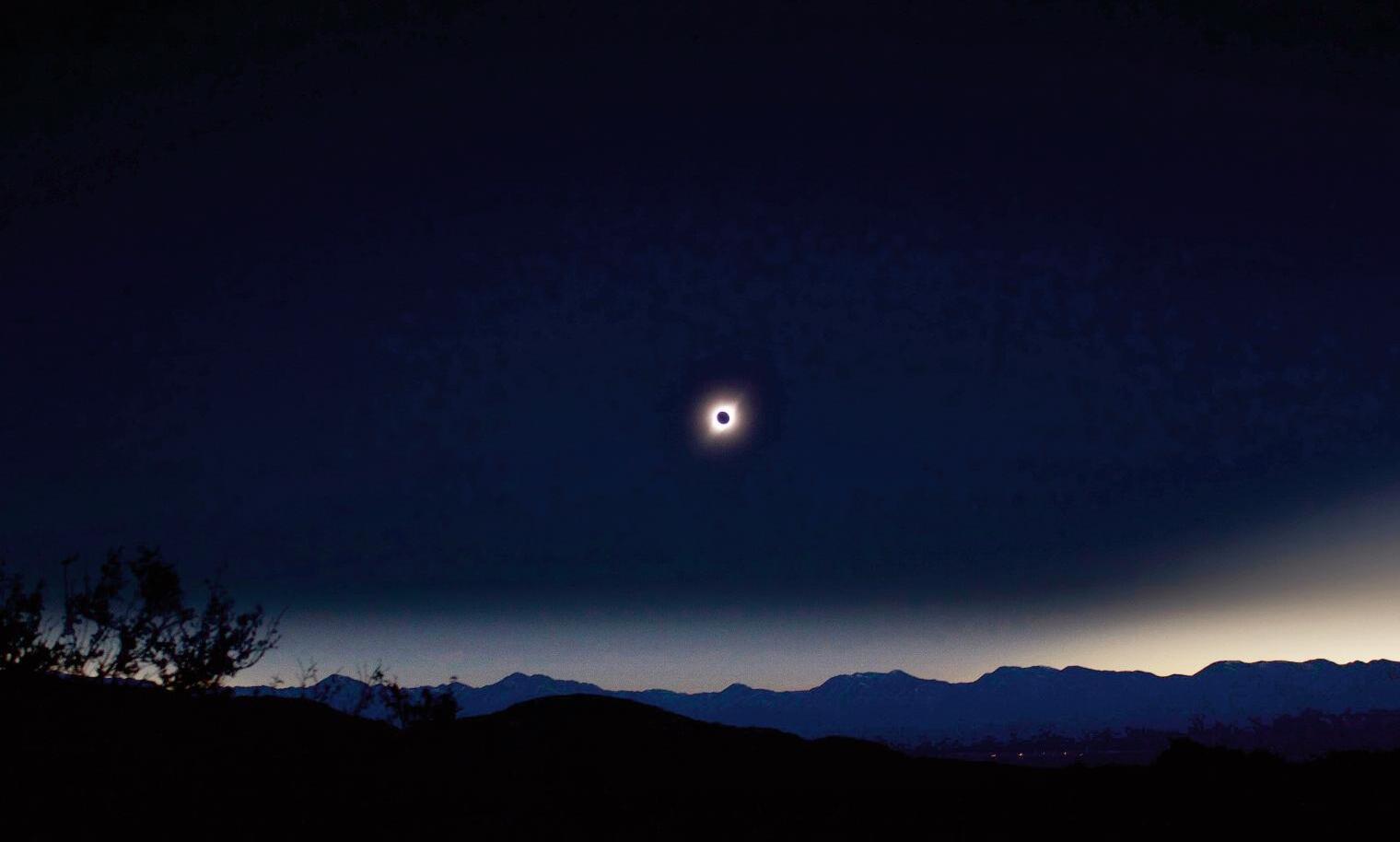
t h e s e e c l i p s e s ( E c l i p s e Pr e d i c t i o n s b y
Fr e d E s p e n a k , h t t p s : / / w w w. e c l i p s ew i s e . c o m / ) . T h e O c t o b e r 1 4 , 2 0 2 3 a n -


n u l a r s o l a r e c l i p s e b e g i n s i n No r t h
A m e r i c a o n t h e c o a s t o f O r e g o n a n d
e n d s i n C o r p u s C h r i s t i e , Te x a s . T h e
v e r y c l o s e l y t h e p a t h o f t h e M a y 1 0 , 1 9 9 4 s o l a r e c l i p s e . In 2 0 2 4 , t h e Mo o n ’ s u m b r a w i l l c o v e r r e g i o n s i n Te x a s , O k l a h o m a , A r k a n s a s , M i s s o u r i , I l l in o i s , K e n t u c k y, I n d i a n a , O h i o , Pe n ns y l v a n i a , Ne w Yo r k , Ve r m o n t , Ne w H a m p s h i r e a n d M a i n e T h e v e r y s o u t h e a s t e r n t i p o f M i c h i g a n , n o r t h o f To l e d o , O h i o , w i l l e x p e r i e n c e a f e w s e c o n d s o f t o t a l i t y, a s w e l l a s a f e w a c r e s i n Te n n e s s e e a t t h e n o r t h e r n e n d o f St a t e H i g h w a y 2 2 n o r t h o f Ti pt o n v i l l e . T h e m a x i m u m d u r a t i o n o f t ot a l i t y f o r t h i s e c l i p s e i s 4 m 2 8 s
64 Solar Technology Today
MAKING THE MOST OF THE UPCOMING 2023 AND 2024 SOLAR ECLIPSES
No t i c e i n I m a g e 9 b o t h e c l i p s e
p a t h s c r o s s i n Te x a s , n o r t h w e s t o f S a n
A n t o n i o . S o f o r t h e s e e c l i p s e s , a s
G e o r g e St r a i t s i n g s , “ Te x a s i s t h e p l a c e
I ' d d e a r l y l o v e t o b e ” . I n t h e U . S . ,
Te x a s w i l l h a v e t h e l o n g e s t d u r a t i o n f o r
b o t h o f t h e s e e c l i p s e s T h e w e a t h e r p r o s p e c t s f o r b o t h a r e p r e t t y g o o d , a n d
i t w i l l b e e a s y t o d r i v e t o a n o t h e r l o c a -
Image 9 - Within a six-month period in late 2023 and early 2024, an annular solar eclipse and total solar eclipse will occur in the United States. The two eclipse paths cross in Texas.
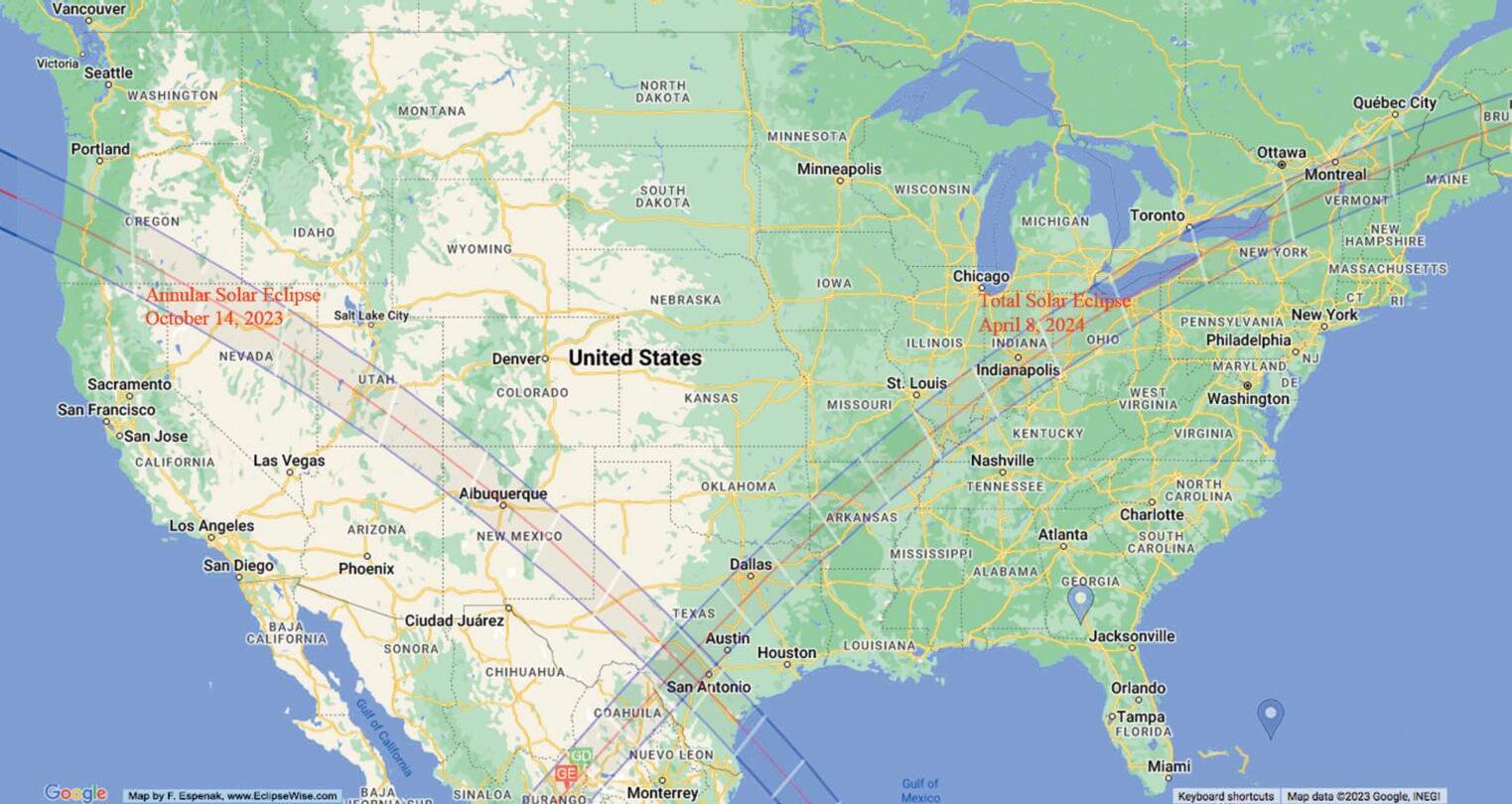
t i o n s h o u l d c l o u d s h i n d e r m y c h o i c e l o c a t i o n s f o r e a c h . W h e r e t h e c e n t e rl i n e s i n t e r s e c t , t h e a n n u l a r e c l i p s e w i l l l a s t 4 m 5 8 s a n d t h e t o t a l s o l a r e c l i p s e 4 m 2 6 s . A g r e a t w a y t o v i e w a n a n n u a l e c l i p s e i s t o p r o j e c t a n i m a g e o f t h e Su n o n t o a s c r e e n u s i n g a Ne w t o n i a n t e l e s c o p e ( I m a g e 1 0 a n d I m a g e 1 1 ) .
Image 10 - The April 8, 2024 eclipse will follow a path ver y close to that of the May 10, 1994 annular solar eclipse The author projected the 1994 annular eclipse using a stopped down ten-inch home-made Dobsonian reflector. The eclipse was obser ved near Lake Erie, 40 miles southwest of Buffalo, New York.
M a n y p e o p l e c a n v i e w a p r o j e c t i o n a t t h e s a m e t i m e No s o l a r f i l t e r s a r e r eq u i r e d . T h r e e - t o f o u r - i n c h a p e r t u r e s a r e g r e a t f o r t h i s . L a r g e r Ne w t o n i a n s c a n b e s t o p p e d d o w n a s i n I m a g e 1 0 a s t h e y g e n e r a t e t o o m u c h h e a t a t t h e e y ep i e c e a n d t h e i m a g e o n a c l o s e - b y s c r e e n i s t o o b r i g h t . Yo u d o n ' t w a n t t o p r o j e c t w i t h e xp e n s i v e e y e p i e c e s l i k e Na g l e r, Et h o s , o r P l o s s l s . T h e y w i l l n o t s u r v i v e . I u s e a t w o - e l e m e n t 1 8 m m R a m s d e n e y e p i e c e . T h e e l e m e n t s a r e w i d e l y s e p a r a t e d i ns i d e t h e b a r r e l a n d t h e y c o n t a i n n o o pt i c a l a d h e s i v e s My 1 8 m m R a m s d e n e y e p i e c e h a s s u r v i v e d d e c a d e s o f s o l a r p r o j e c t i o n . Yo u c a n u s e t h e s a m e t e c h n i q u e f o r a t o t a l s o l a r e c l i p s e . Yo u c a n s e e a l l o f t h e p a r t i a l p h a s e s , t h e d i a m o n d r i n g , B a i l e y ’ s b e a d s , p r o m i n e n c e s a n d t h e s o l a r c o r o n a o n s u c h a p r o j e c t i o n . Fo r d e t e r m i n i n g t h e e x a c t b e g i nn i n g a n d e n d t i m e s o f t o t a l i t y, w h i c h h a s s c i e n t i f i c u s e , I r e c o r d v i d e o o f a p r o j e c t i o n o f t h e e c l i p s e w i t h a t i m e r
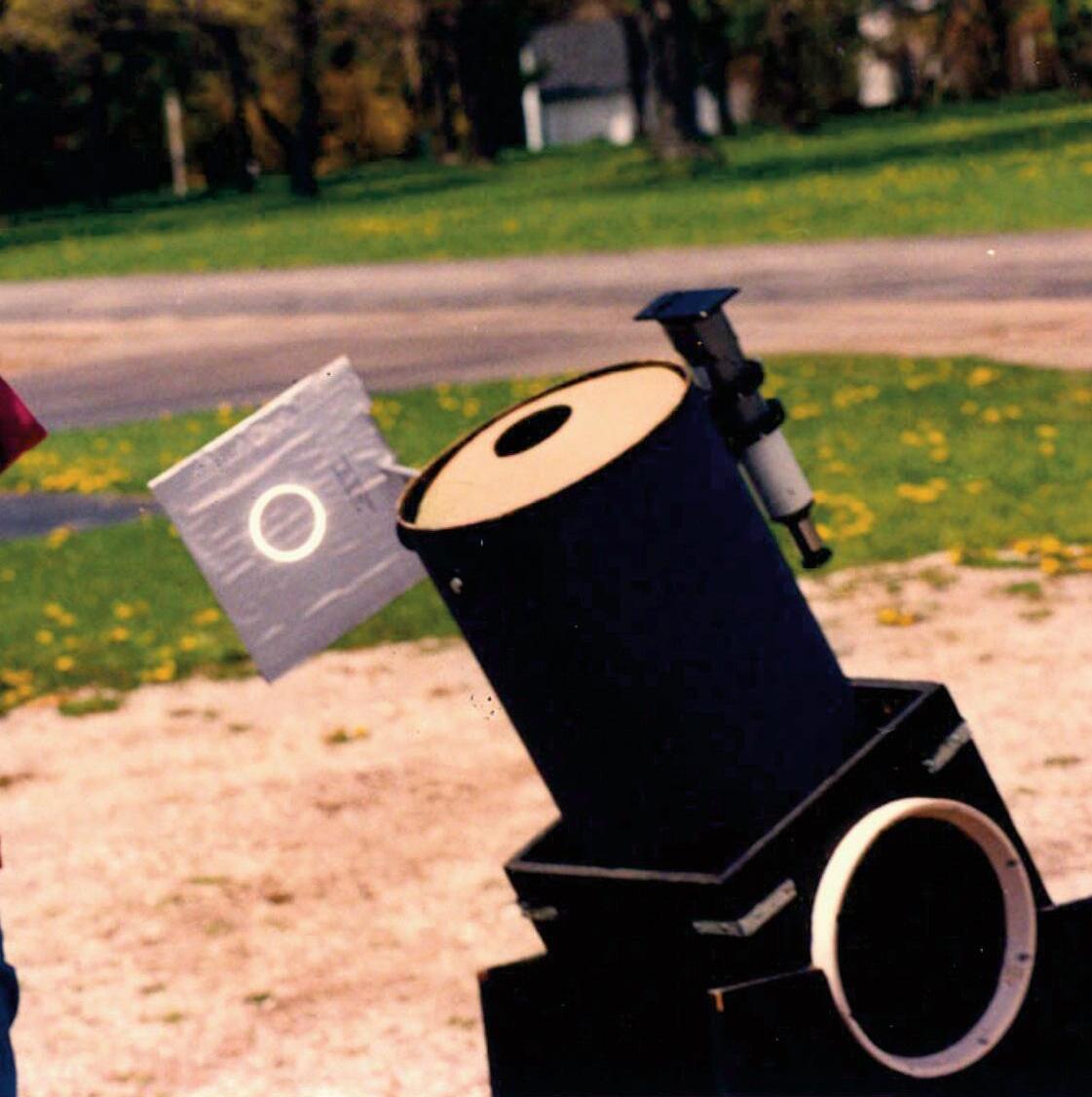
66 Solar Technology Today
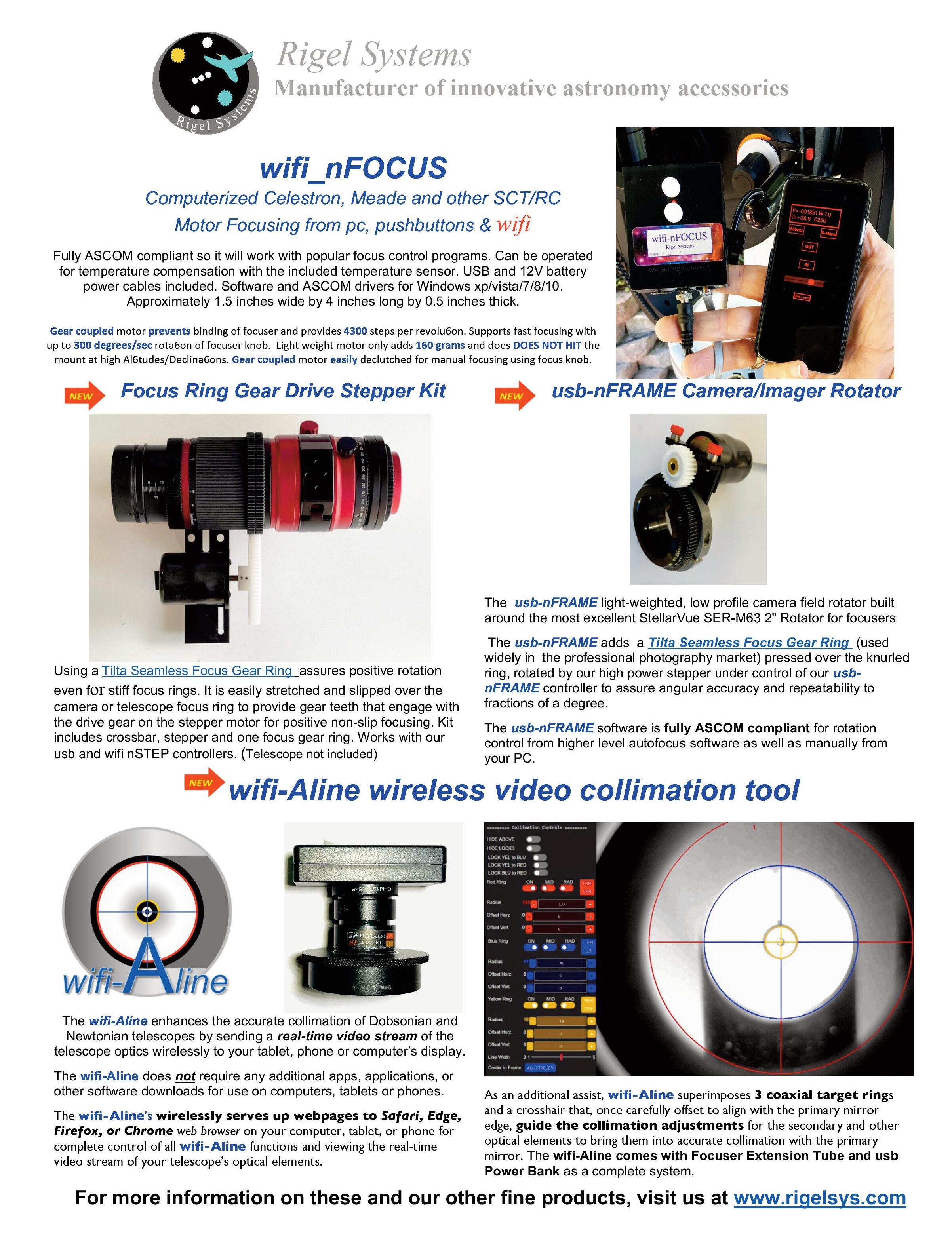
i n t h e f i e l d o f v i e w ( Im a g e 1 2 ) O n t h e r e c o rd i n g , I a l s o c a p t u r e a u d i o f r o m a s h o r t w a v e r a d i o t i m e b r o a d c a s t Us i n g
a G P S r e c e i v e r, I c o l l e c t t h e l a t i t u d e , l o n g i t u d e a n d a l t i t u d e o f t h e t e l es c o p e ’ s l o c a t i o n f o r u s e i n t h e s e s c i e nt i f i c c a l c u l a t i o n s . T h e d a t a a r e u s e d t o d e t e r m i n e t h e e x a c t s i z e a n d s h a p e o f t h e Su n t h e d a y o f t h e e c l i p s e . Mo s t s t a r, l i k e t h e Su n , va r y i n s i ze a n d s h a p e d u r i n g t h e i r m i d - l i f e a g e s
To p h o t o g r a p h t h e e c l i p s e , I u s e s m a l l r e f r a c t o r s w i t h s a f e s o l a r f i l t e r s ov e r t h e o b j e c t i v e e n d s o f t h e t u b e s f o r t h e p a r t i a l e c l i p s e p h a s e s Fo r t h e t w o

Te x a s ( n o t t o b e c o n f u s e d w i t h t h e
Te x a s t w o - s t e p ) e c l i p s e s , I p l a n t o u s e a
1 1 0 m m W i l l i a m O p t i c s r e f r a c t o r, a
7 0 m m St e l l a r v u e r e f r a c t o r a n d a L u n t
5 0 m m h y d r o g e n a l p h a t e l e s c o p e Si n c e
I w i l l b e t r a v e l l i n g b y c a r t o Te x a s , I ’ l l e a s i l y b e a b l e t o t r a n s p o r t a l l o f t h e t e le s c o p e s , m o u n t s , c a m e r a s , a n d o t h e r e q u i p m e n t .
I w i l l h a v e a t e a m o f f a m i l y m e mb e r s , f e l l o w a s t r o n o m e r s a n d f r i e n d s
w i t h m e t o h e l p c o n d u c t a l l o f t h e w o r k . T h e g r o u p s i z e s h o u l d a l l o w a l l o f u s t i m e t o l o o k u p a n d e n j o y t h e t o t a l s o l a r e c l i p s e p h a s e n a k e d - e y e , i n b e t w e e n o p e r a t i n g e q u i p m e n t . S o b r i n g y o u r b o o t s a n d St e t o n s t o Te x a s a n d e n j o y t w o m a r v e l o u s s o l a r e c l i p s e s . T h i s i s t h e f i r s t o c c a s i o n i n o u r g e n e r a t i o n f o r t w o c e n t r a l s o l a r e c l i p s e s o c c u r r i n g i n t h e Un i t e d St a t e s w i t h i n s i x - m o n t h p e r i o d A n d i t m i g h t b e t h e o n l y t i m e s u c h h a s o c c u r r e d i n t h a t t i m e p e r i o d a t t h e s a m e l o c a t i o n !
68 Solar Technology Today
MAKING THE MOST OF THE UPCOMING 2023 AND 2024 SOLAR ECLIPSES
Image 11 Above - Here the author uses a six-inch Newtonian on a powered polar-aligned equatorial mount to project the Sun on a screen attached to the telescope

Image 12 Left - Contact timings are recorded on video by projecting the eclipse onto a screen with a timepiece. A broadcast of WWV short wave radio time signals is simultaneously recorded by the video camera. The exact times of second and third contacts is preser ved on the video.

MAKING THE MOST OF THE UPCOMING 2023 AND 2024 SOLAR ECLIPSES
Solar Technology Today 69
Player One products are now availa Astro Hutech and are fully s able through supported






to US customers.
Th i b th h d l d t h tl he cooled deepsky cameras are fu sc





APS-C sensor sizes. ull frame and , in both cheduled to come up shortly



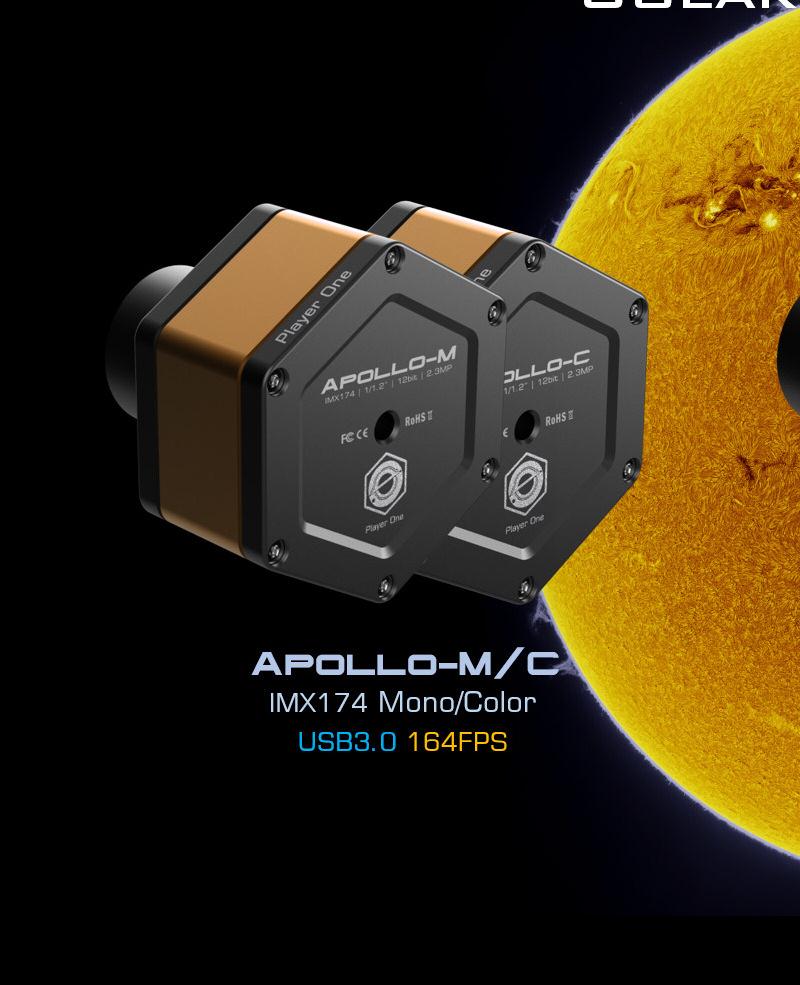

rdpress.com
store
digiborg.wor astrohutech.s
The Astro Hutech Hinode Solar Guider
By Austin Grant
In the realm of astronomy, there are several “first” that are sure to leave people speechless. Being involved in astronomy outreach, I can tell you that one of the most notable ones is the first time a viewer sees the rings of Saturn Words usually can ’ t describe that sense of awe and wonder Another is the Great Red Spot on Jupiter.
We’ve all seen it in pictures, but to observe it directly is an amazing experience. Galilean moons, Iridium flares, and the International Space Station would also make the top of this list. For me, one event trumped all others, and has remained at the top of my “firsts” list: I’ll never forget my first view of the Sun through a hydrogenalpha telescope. Being an imager at heart, I knew instantly that I needed to be able to take images of the Sun. This, unfortunately, led to more of my “firsts,” and not ones I’d
be happy to repeat
The first time I tried to image the Sun nearly became my last time to image the Sun. I didn’t yet have a hydrogen-alpha scope, so I started with a white-light filter. It was a full-aperture filter for an 8-inch SCT; quite a bit of focal length for a beginner To make matters worse, I only had an old dualaxis driven Celestron CG-5. The nail in the coffin was the gusty winds, exaggerated by a bad polar alignment and a tiny CCD sensor. I spent all of my time trying to keep sunspots centered on that CCD sensor, battling drift with the hand controller the entire time When the processing was done, what had initially been a small field of view resulted in almost nothing to show. The stacking process works best if you crop to sections that are in all frames, and in my case, that was basically nothing Much more
luck like this, and I’d have given up for good
Fast-forward a visit to NEAF, when I walked past the Astro Hutech booth where something interesting caught my eye. On display was the Hinode Solar Guider, a stand-alone autoguider designed for visual observing as well as photography. I was immediately back in that first solar-imaging endeavor, and a chill ran down my spine. Sure, I’ve upgraded equipment since then, but some of those main problems will occur regardless of the gear used. Still, this Hinode was a promising tool, so I picked one up
The Hinode Solar Guider from Astro Hutech arrived in a cool plastic case, with all the components you need to immediately get up and running. To be specific, that includes the optics/electronics assembly box,
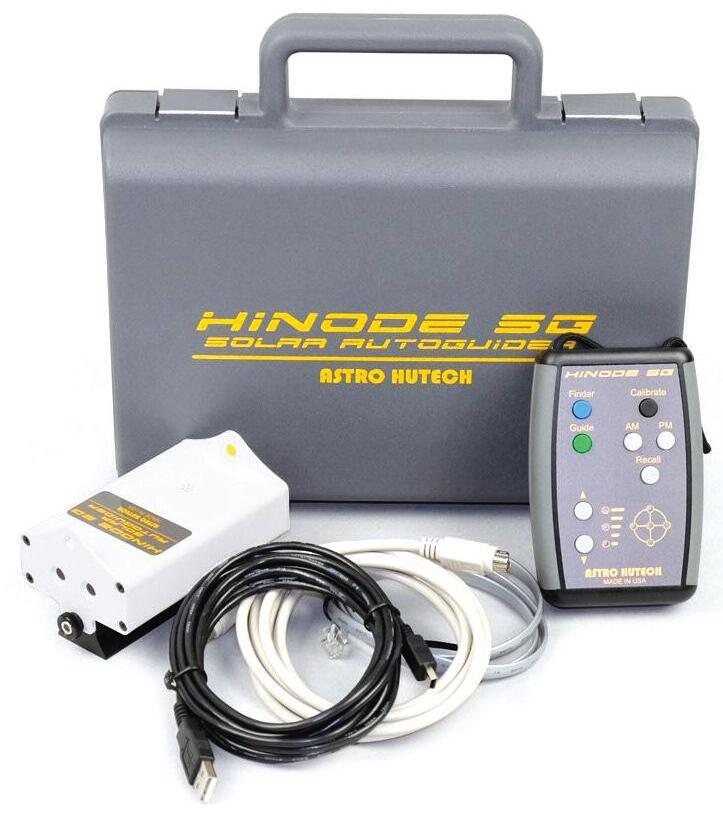
Solar Technology Today 71
Image 1 - The Hinode kit as shipped from Astro Hutech, minus the mounting base, of which there are three options.
hand-controller, USB cable, hand-controller cable, autoguider cable, and choice of mounting base There are three mounting bases to choose from: Universal, Lunt and Coronado. I went with the Universal base, but also added a Coronado base to use with my SolarMax II 60-mm H-alpha scope
The fit and finish of all the parts and accessories was fantastic. The optics/electronics box was metal, as were the mounting bases. The hand-controller was made of durable plastic, so it was both strong and lightweight Everything looked great, but I
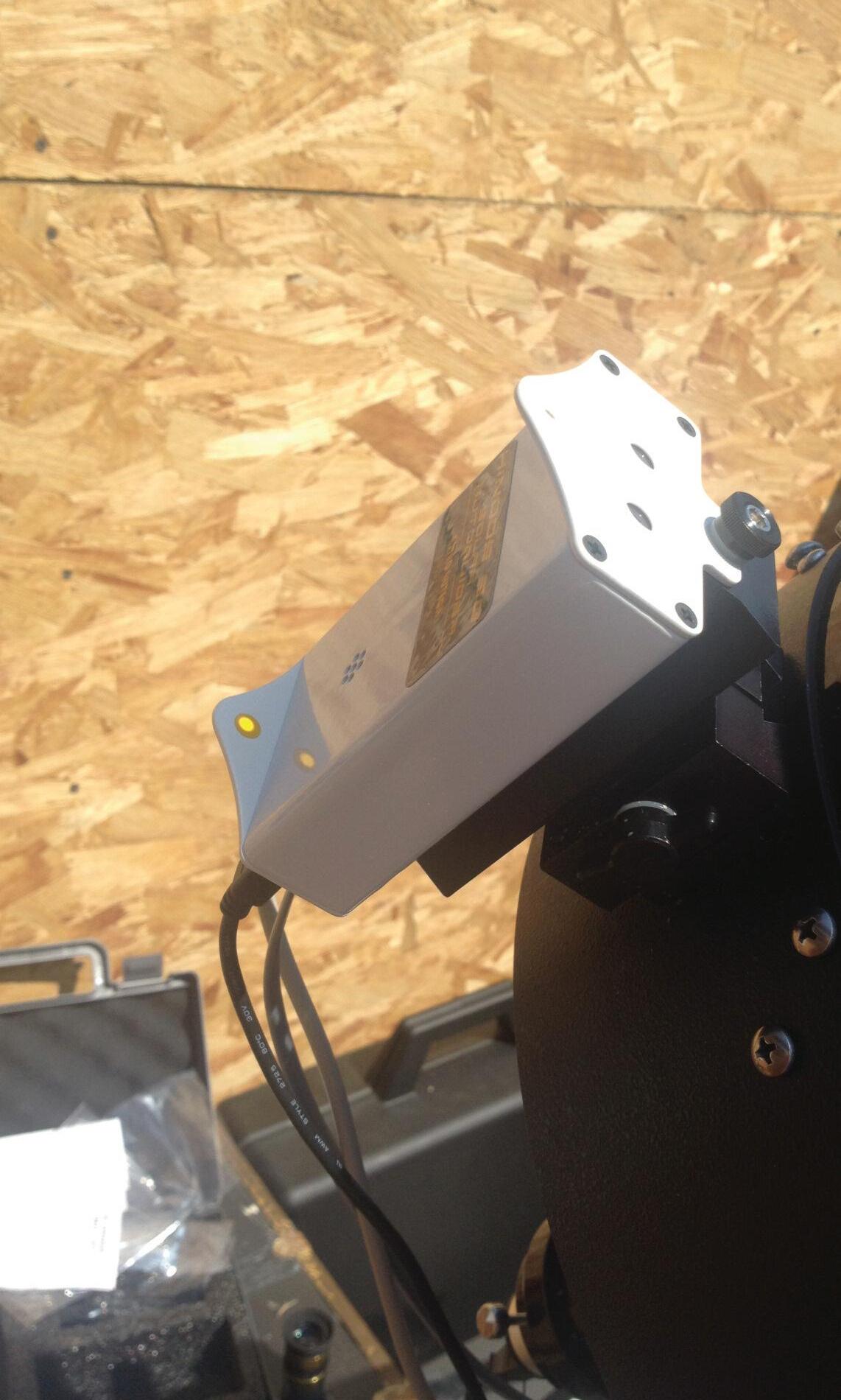
wanted to know how it set up and worked. The Coronado mounting base was a snap to install I simply removed the Coronado Sol Ranger from the clamshell and installed the Hinode base in its place. As for the Universal mounting base, I had several options for using it It is designed to fit into a standard Orion/Synta-type finder shoe, but none of my gear had one. Instead, for whatever reason, my 8-inch Meade SCT, 11-inch Celestron SCT and ED80 all had different aftermarket finder attachments Luckily the Universal base has bolt holes
and a slotted bottom, so making it work with each of these scopes was a snap
Once I was able to mount the optics/electronics assembly box on any scope, I attached the hand controller. It has a nice loop at the top, and my ADM Accessories knobs on the Celestron CGE came in very handy as a hanging point Finally, I had to connect the Hinode to my autoguider port and add power. The kit includes a USB power cable, which will probably work well for any imager, because you will already have a computer nearby If you are using this

72 Solar Technology Today
Image 2 - The Hinode optics/electronics assembly box with course finder mounted on a Celestron 11-inch SCT.
THE ASTRO HUTECH HINODE
Image 3 - The Hinode hand-controller hanging on a Celestron CGE equipped with ADM Accessories anodized knobs.
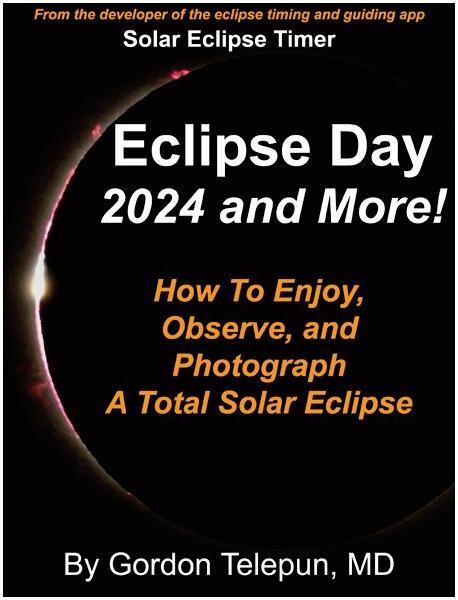
www.solareclipsetimer.com
visually or imaging without a computer, it needs a 5-volt DC power supply.
With everything connected, I was ready to go At this point, I should tell you that my Celestron CGE was mounted on a concrete pier inside my observatory. I decided to test it there before going mobile. Because I was already polar aligned and on a sturdy setup, I wasted no time in going straight to my most challenging scope I mounted the 11-inch SCT and started up the computer. To actually capture images, I used the
QHY5L-II from QHYCCD, and it still amazes me with its high frame rate and high-quantum efficiency sensor. With everything ready to go, I powered on the Hinode
To begin, I pressed the Finder button on the hand-controller, putting the Hinode into Finder mode. There is a coarse finder on top of the optics/electronics assembly, where the Sun will appear centered in a yellow circle when you are close. Once you get close, there are five directional LEDs on the
hand-controller, with four outside of a centered LED As you approach perfect center with the Sun, the outer LEDs indicate the direction you must move the scope. It was a very intuitive process and took less than a minute to accomplish. If you are unable to see the hand-controller while centering the scope, you can press the Finder button again to activate audible feedback. Here, the pitch increased as the Sun was centered.
The next step was to calibrate the autoguider The instructions mention that the guide rate should be set to a low speed, but mine was already at 0.5X sidereal, so I left it alone. I simply pressed the Calibrate button and let it do its thing. The LEDs indicated which axis and direction was being calibrated, and after about 90 seconds it returned to Finder mode. From there, all I needed to do was press the Guide button, and I was off to the races.
A cool feature I discovered after the fact was that you can save the calibration for a quick startup. There are two memory positions, one for AM and one for PM. To save a calibration, simply hold down the appropriate button until a tone is heard Then, for a quick start, from Finder mode simply press Recall and the appropriate AM or PM button. Then you are ready to guide.
The installation was easy, the setup and calibration was a breeze, and the Hinode certainly looked cool as it attempted to keep the Sun centered on my camera sensor. But how did it work? I’ll offer supporting details in a second, but I can sum it up with a single word: Brilliantly!
With the 11-inch SCT on the already polar-aligned mount, I was mainly doing battle with periodic error, sidereal-vs-solar tracking rate, and any residual polar misalignment Using the full focal length of the scope and with the sensor cropped to 640x480 pixels for maximum frame rate, an unguided image of the Sun would drift completely out of the frame in less than two minutes Turns out my polar alignment wasn ’ t as great as I thought! Once I activated the Hinode for autoguiding, sunspots stayed centered indefinitely. There was some minor jostling around, but it can be attrib-
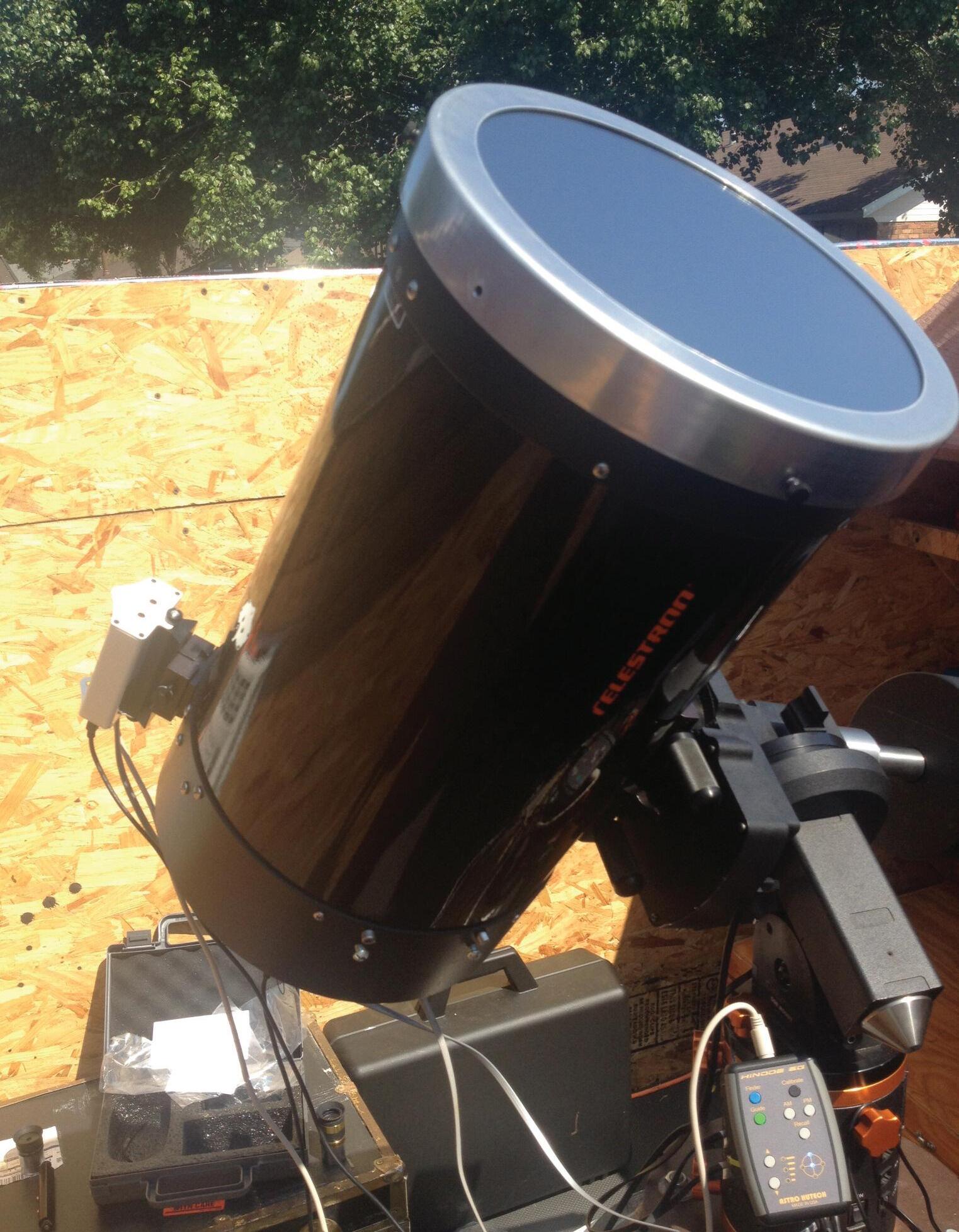
74 Solar Technology Today
THE ASTRO HUTECH HINODE
Image 4 - The Hinode kit is shown mounted and in operation on a Celestron 11-inch SCT and CGE mount
uted to scintillation. I couldn’t believe how well the Hinode worked! Still, seeing was poor, and I didn’t get any publishable images from that outing
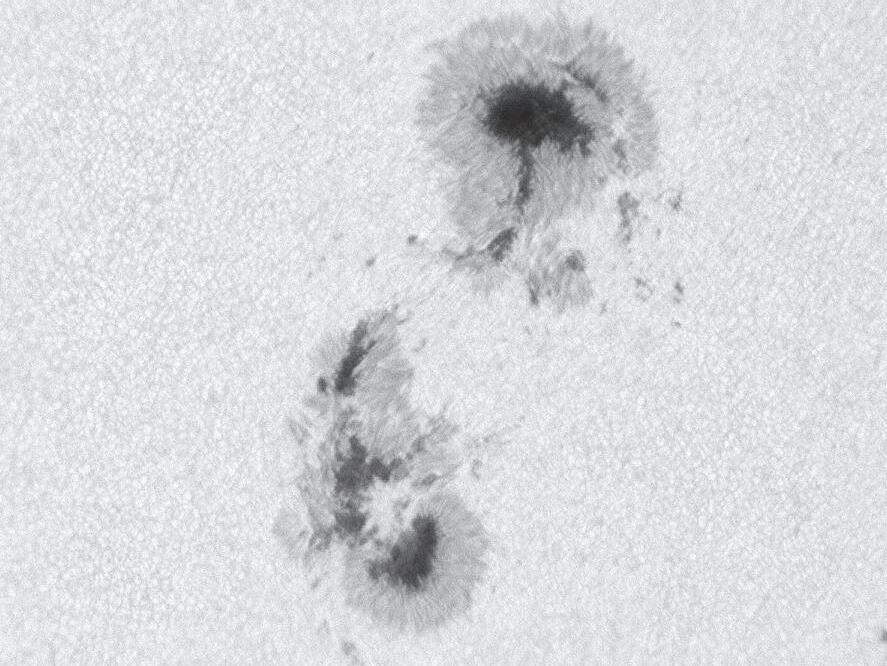
On my next outing, I removed the CGE from the pier and mounted it on a tripod in the backyard. This more closely resembled most of my solar outings, where
I just plop the mount down and point it approximately north. This time, I mounted the 8-inch SCT, but added a Tele Vue 2 5X PowerMate to the mix That’s 5000-mm focal length on a non-polar aligned mount! I measured drift without guiding, and it was absurd. Again, after activating the Hinode things were just…

there - right in the center, and they stayed there.
If I’d had this kind of gear from the beginning, perhaps I’d be giving Stephen Ramsden advice on solar imaging! (By the way, my friend Stephen Ramsden is the driving force behind the Charlie Bates Solar Astronomy Project, likely the largest solar-
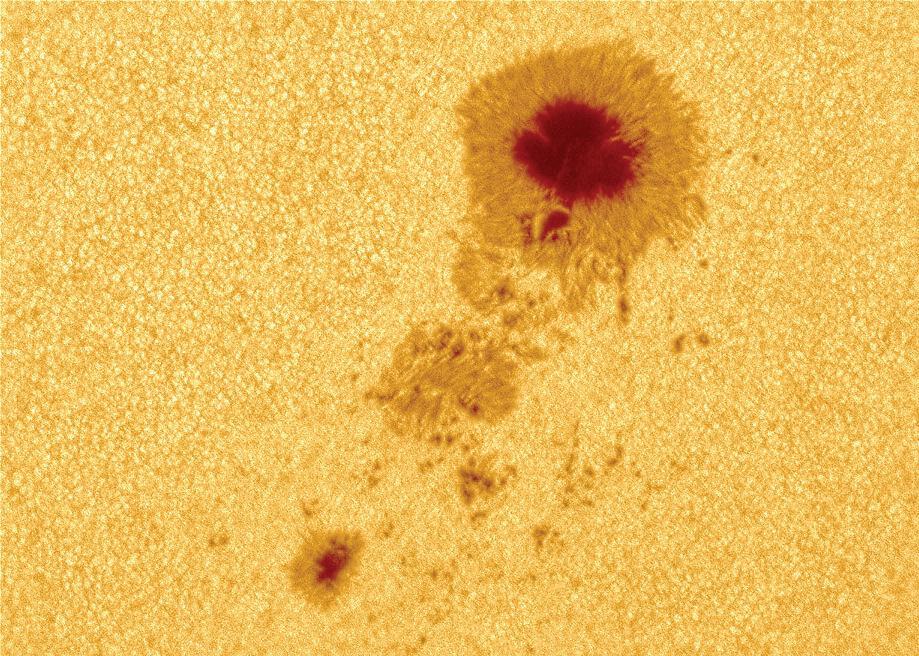
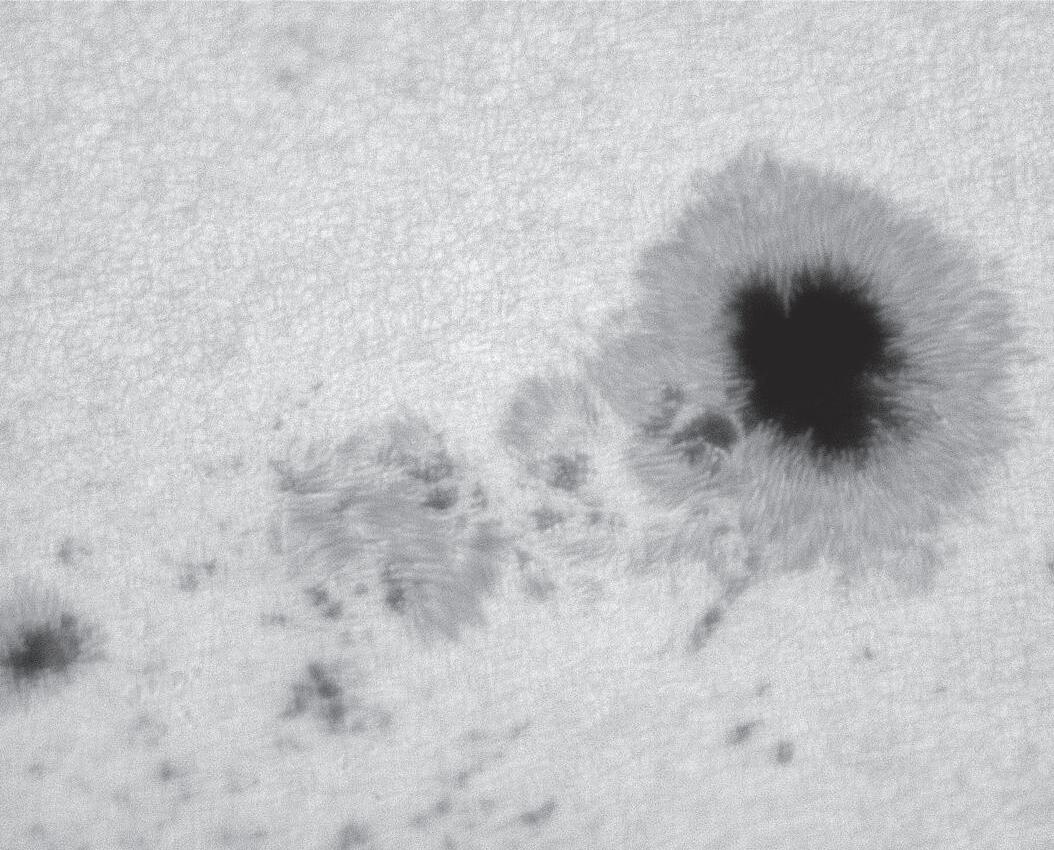
Solar Technology Today 75
Image 5 -Sunspot captured at a focal length of 5000 mm with a QHY5L-II CCD camera through a Tele Vue 2.5X PowerMate and 8-inch Meade SCT, guided by the Hinode.
Image 6 - Another sunspot captured at a focal length of 5000 mm, guided by the Hinode.
Image 7 - Yet another sunspot captured at a focal length of 5000 mm, this one in false color, guided by the Hinode.
THE ASTRO HUTECH HINODE
Image 8 - Coronado SolarMax II 60 Halpha telescope mounted on a Celestron CGE, equipped a QHY5L-II CCD camera and Tele Vue 2 5X PowerMate, ready for guiding with the Hinode
outreach program on Earth). Seriously, though, the Hinode just plain works, and it’s simple to use I got some nice sunspot images with excellent detail for my modest equipment.
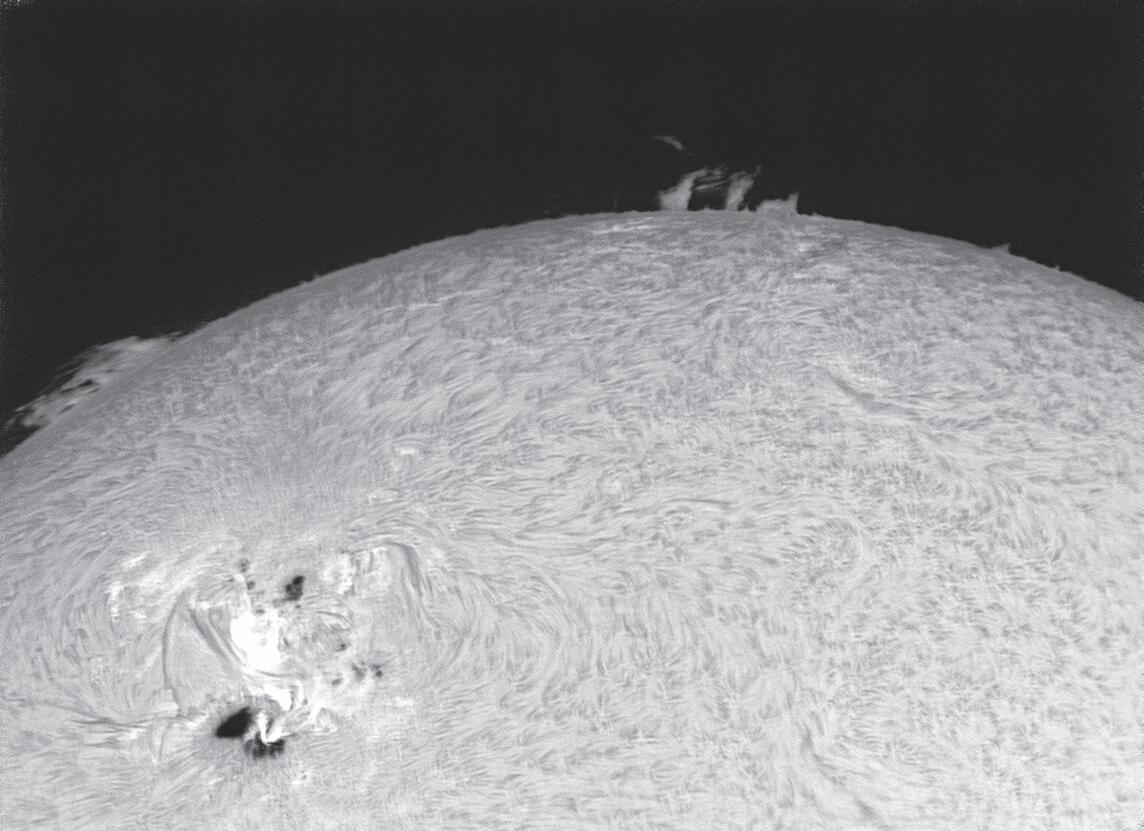

For the next few outings, I used the Coronado SolarMax II 60-mm H-alpha telescope I used it with and without the TeleVue 2.5X PowerMate, and with the QHY5L-II in both full-frame and
cropped mode. Because of the Hinode, the images were magnitudes more stable than ever before More of the data could be stacked, and I ended up with more of my original resolution than I’m used to. The






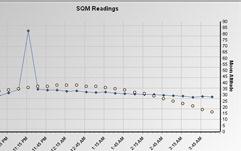




76 Solar Technology Today
Image 9 - H-alpha image taken with the QHY5L-II, Tele Vue 2.5X PowerMate and Coronado SolarMax II 60, guided by the Hinode
THE ASTRO HUTECH HINODE S S DeepDeep- ky Plan y y y Plan n n er 8 is Her er 8 is Her e! e! Sk Sk k ky Frro o ghtw h om Knig om Knig war a e are arhtwwa htwgh r r Fr F F Monito e i H l y n D pservers. al ob and visu imagers e for ar logging softw and planning Exceptional ro ware ware h K igh g Fr 2014 ts oduc r Pr Sta 2013 ro o 3 o 3 eader Pr eader Pr SQM R SQM R e: e: Re o 3 eader Pr SQM R y with omaticall y aut skky aut our kness of y or the dar e d P Q R www.knightware.biz w.knig htware.biz wnload trial edition at knig Do z
Image 10 - Another H-alpha image taken with a QHY5L-II, Tele Vue 2.5X PowerMate and Colornado SolarMax II 60, guided by the Hinode

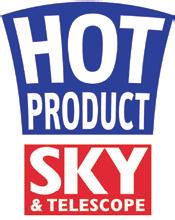




and
. captured yourselff. s no better way t There’ cycles rs, their di erences, to learn than from data you’ve e . current imaging setup Capture your own spectra using our S No complicated equipment configuration s well under light-polluted skies Work of what we know about stars comes from understanding their spectra. Star Analyser 100: $195 | RSpec softwar tar Analyser 1.25” grating and your 80% captured. Use our RSpec software to understand the spectra you’ve No steep learning curve No complicated image processing rating com . .rspec-astro Short how-to videos here: www
their life c about the star Learn more
Hinode truly has made solar imaging more effective, and more fun.
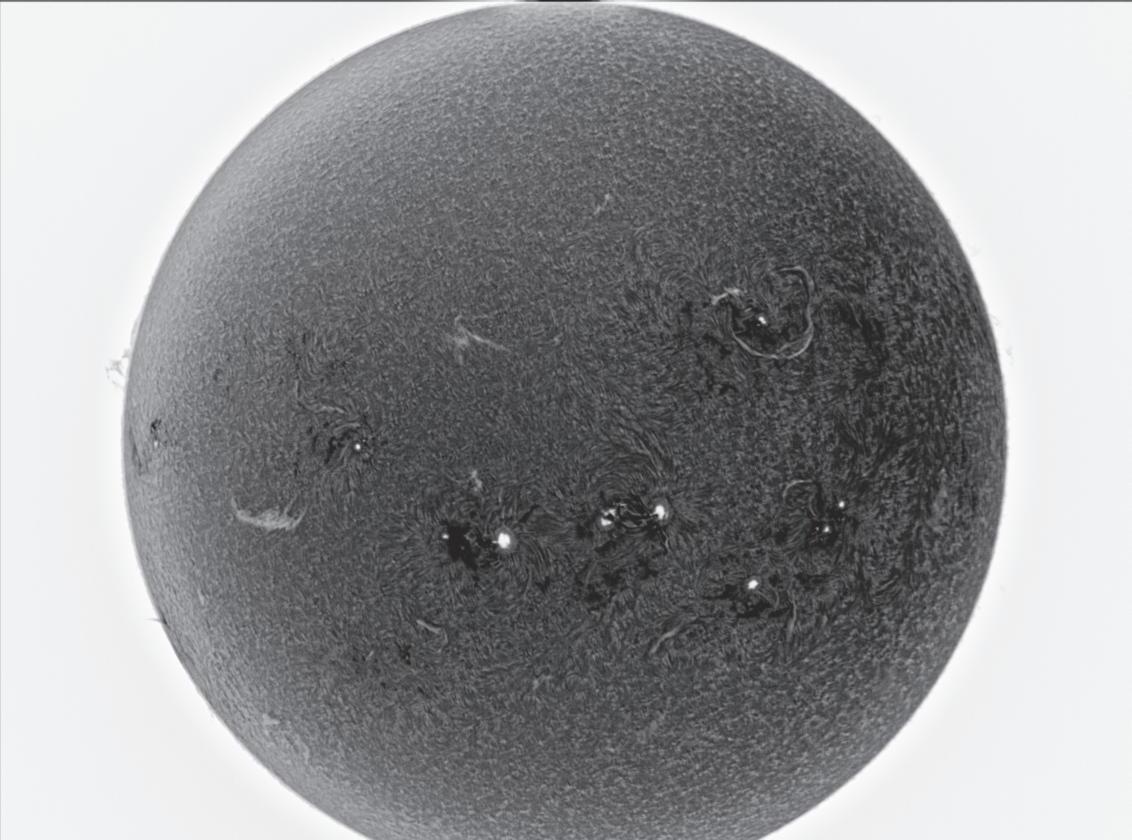
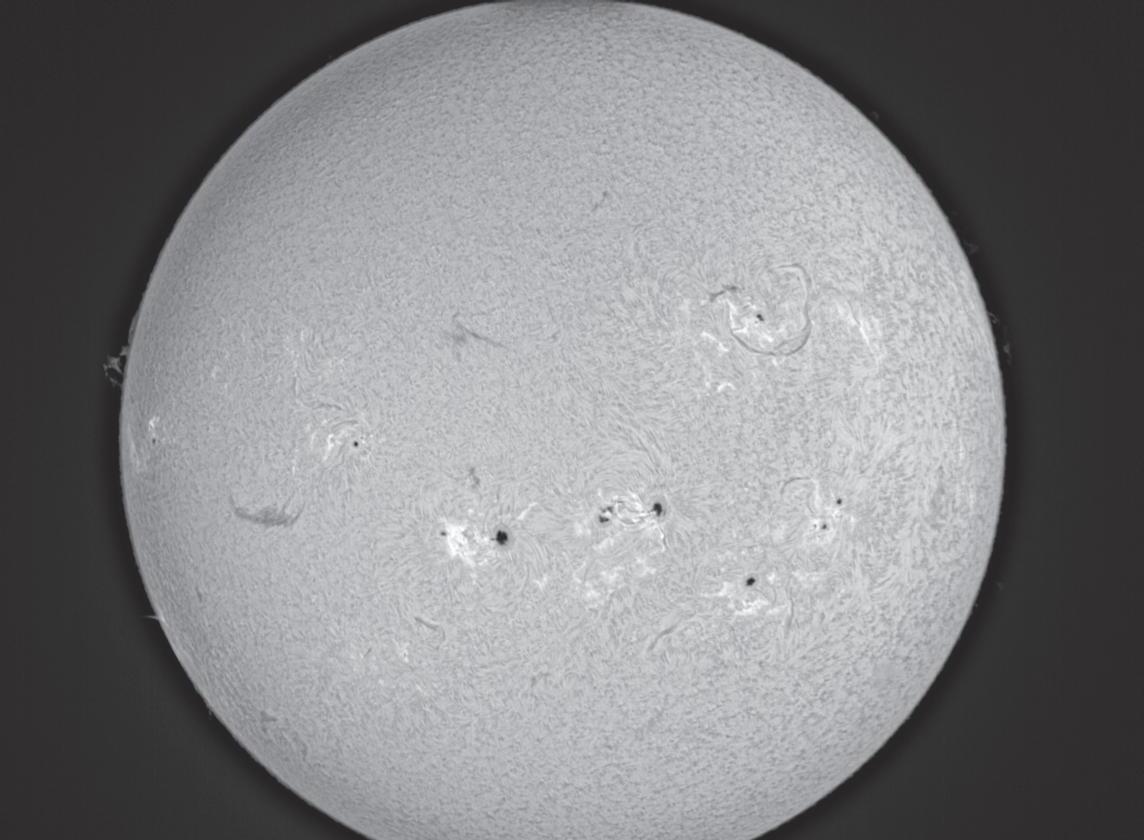

The Hinode Solar Guider from Astro Hutech has turned out to be one of my favorite astronomy tools It has eliminated all of the controllable sources of fr ustration from my solar imaging
workflow. I no longer need to str uggle with a compass and polar-offset charts in an effort to get perfectly polar aligned in the daytime I no longer need to struggle with the mount hand controller, tr ying to compensate for drift, periodic error and backlash. All I do now is set up the
mount and scope, attach the Hinode, and start imaging.
If you find yourself dealing with any of these issues during your solar outings, and I’ll bet you do, then the Hinode Solar Guider is surely a tool you need to check out.
78 Solar Technology Today
THE ASTRO HUTECH HINODE
Image 11 - Full-disk (almost!) H-alpha image captured with the QHY5L-II and Coronado SolarMaxII 60, guided by the Hinode.
Image 12 -An inverted version of Image 11.










D For Deep-S visual a l S nd imaging observers! lanne ing observ e vers! 8 oid, iO Windows, Andr Logging Softwa Exceptional Planni DEEP-SKY PLAN INTRODUC OS/IPadsOS e for ar ing and id F A d NNER 8! ING DSP knightw For Windows Deep-Sky Planner 8 www w e.biz iPad0S & iOS oid, For Andr .knightwwar w.knightwar
t Just on' D
ne. , Use O ieldd, e a StarFField aptur t C
e 2" H
olar erschel S
oth s fe for b aS
Wedge
ation and phot v solar obser
ography
eld Optics 2" Herschel solar w tar he S T
e detail fac and sur
he solar w T
edge
e inc fac 's sur e the sun v ou can obser w y ms ho ansfor for tr
luding sunspots
.
efra our r o y ttaches t edge easily a

eplacing the standar , r elescope or t t ac
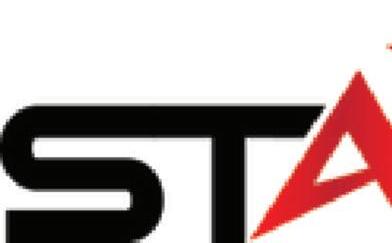
ou can e y eady sinc ing-r edge is imag solar w
olar w S
aditional lm so o tr ed t ompar , c edges
ast ima contr - ou a higher e y iv o g wn t no e k ar
er a een the lt w tions bet e ec es all r emov it r
ope lens telesc
T
he sun can be saffely obser
ed with the S v ely obser
is or or pr r d 2" mir
The . sm diagonal
em o r tness without needing t igh ne tune the image br
a. our camer e y mov
ers, olar lt
and ge because
tar
ed tness can be adjust igh . Br edge Herschel w
ting the 2" ey ota y r er b izing lt of the 2" polar
ange t r adjustmen
eld Optics r

wisting y t b
eatures: y F Ke yepiece
tors efrac most r
ore! er beffor like nev
granulation
ther O ur O ut O heck O C
holder. eldoptics.com

stronomer maging A
AD
MSRP - $449.99 C CAD w.st w w
e g fac o see sunspots and solar sur eady t et r G tar
isual and I V or the erings f
TAKING SOLAR ECLIPSE PHOTOS IS A SNAP WITH GIZMO ASTRONOMER DEVELOPED
By Bradley Worrell
More than 50 years later, Doug Duncan still vividly recalls seeing his very first solar eclipse.
“I saw my first eclipse on March 7, 1970. I can still tell you that it lasted for three minutes and 20 seconds, and it was the most awe-inspiring thing I had ever seen, ” he says “And I told myself then that I’ve got to see more of these - and so I’ve chased them all over the world since then and I’ve seen 12 of them so far.”
A solar eclipse - which occurs when the Moon passes between the earth and the Sun, thereby obscuring the view of the Sun from a portion of the earth - is a sight to behold: The sky darkens and the unearthly silver streamers of the Sun’s corona stretch across the sky, while pink “flames” decorate the Sun’s edge

“When there is a total eclipse of the Sun, it’s just so intense - it’s unbelievably beautiful and strange. Some people viewing them will cheer while others will let out a scream or cry, ” says Duncan, emeritus faculty member in the Department of Astrophysical and Planetary Sciences at the University of Colorado Boulder and the director of Fiske Planetarium from 2002 to 2018.
In recent years, Duncan has enjoyed taking large groups of people on trips across the country to witness solar eclipses and to experience the northern lights, when waves of color illuminate the night’s sky
SOLAR TECHNOLOGY TODAY 81
Image 1 - Lunar eclipse photo composite captured by iPhone with Doug Duncan's invention, the Solar Snap.
“Two things are stunningly more beautiful and even soul-inspiring in nature than anything else - and those two things are a total eclipse of the Sun and the northern lights - and I have been privileged to experience both of them quite a bit,” he says. “And I’ve been fortunate to share those experiences with many others.”
Still, one thing Duncan noticed in recent years when taking groups of people to view solar eclipses is that many of them reached for their smartphones attempting to capture the event
“At the last couple of eclipses, I noticed how much people love their phones and how they like taking pictures and posting them online for friends to see. So, I saw lots of people trying to take pictures of the Sun and failing,” he says.
“That’s because your phone has a pretty nice camera, but the software in it is optimized for taking pictures of people and maybe landscapes - but certainly not for taking photos of a round orange dot against a black background ”
In fact, attempting to take photos of an
eclipse with a standard smartphone camera can cause irreparable damage to the camera - just as looking directly at the Sun for extended periods can cause permanent eye damage in people, according to Duncan
“I’m not sure if everyone realizes it, but if you take your camera and pointed it at the Sun and took photos for even a matter of several seconds, you ’ re going to ruin your camera, ” he says. “Of course, the reason is the same for cameras as it is for your eyesthe Sun is just so powerful. Staring at the Sun would ruin your eyes - it would burn your retinas.”
To assist his fellow eclipse watchers, Duncan says he searched online extensively for something that would allow them to safely use their cameras but came up emptyhanded So, he decided he would have to invent something himself
Necessity is the Mother of Invention
The first part of Duncan’s solution was straightforward: He took a pair of paper eclipse-viewing glasses, cut the glasses in half and trimmed off the temple, and attached a piece of Velcro to the viewing lens and a corresponding piece to his smartphone’s camera lens
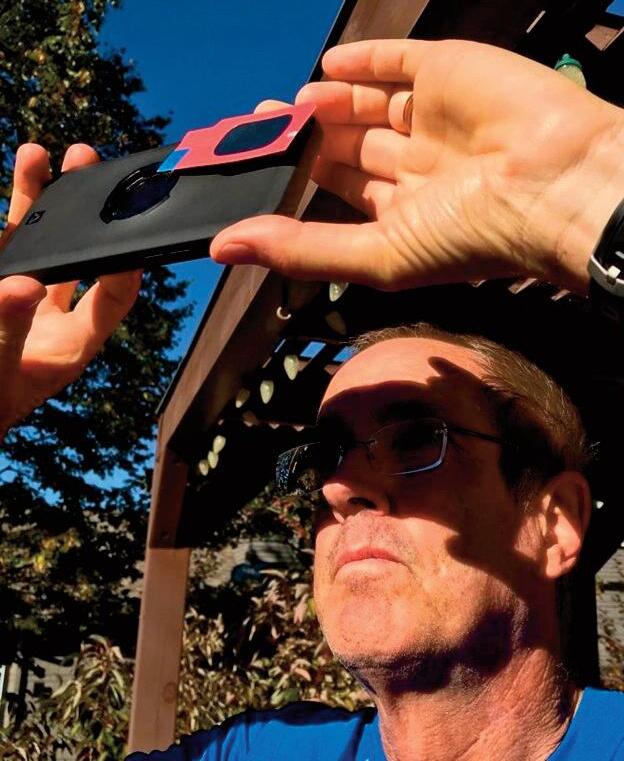
“I started taking photos of the Sun, and I found I could take quite nice photos - but I had to completely override the adjustments on the camera, ” Duncan says. “For instance, there are some apps that can make your smartphone camera behave more like a single-lens-reflex camera, where you adjust the shutter speed and the like.
And I thought: you know, what’s really needed is an app where you can control the basic camera functions, and the three important ones in this case are: zoom, exposure and focus Your camera automatically focuses on faces, so I wondered if I could get the camera to instead focus on the Sun.”
He says he realized pretty quickly that
86 Solar Technology Today 2 Technology Today
SOLAR SNAP
Image 2 - Doug Duncan using his invention, the Solar Snap with iPhone.
While we offer the best prices on astronomy equipment and accessories, it’s our people that make sure that your buying experience is unmatched in the industry!
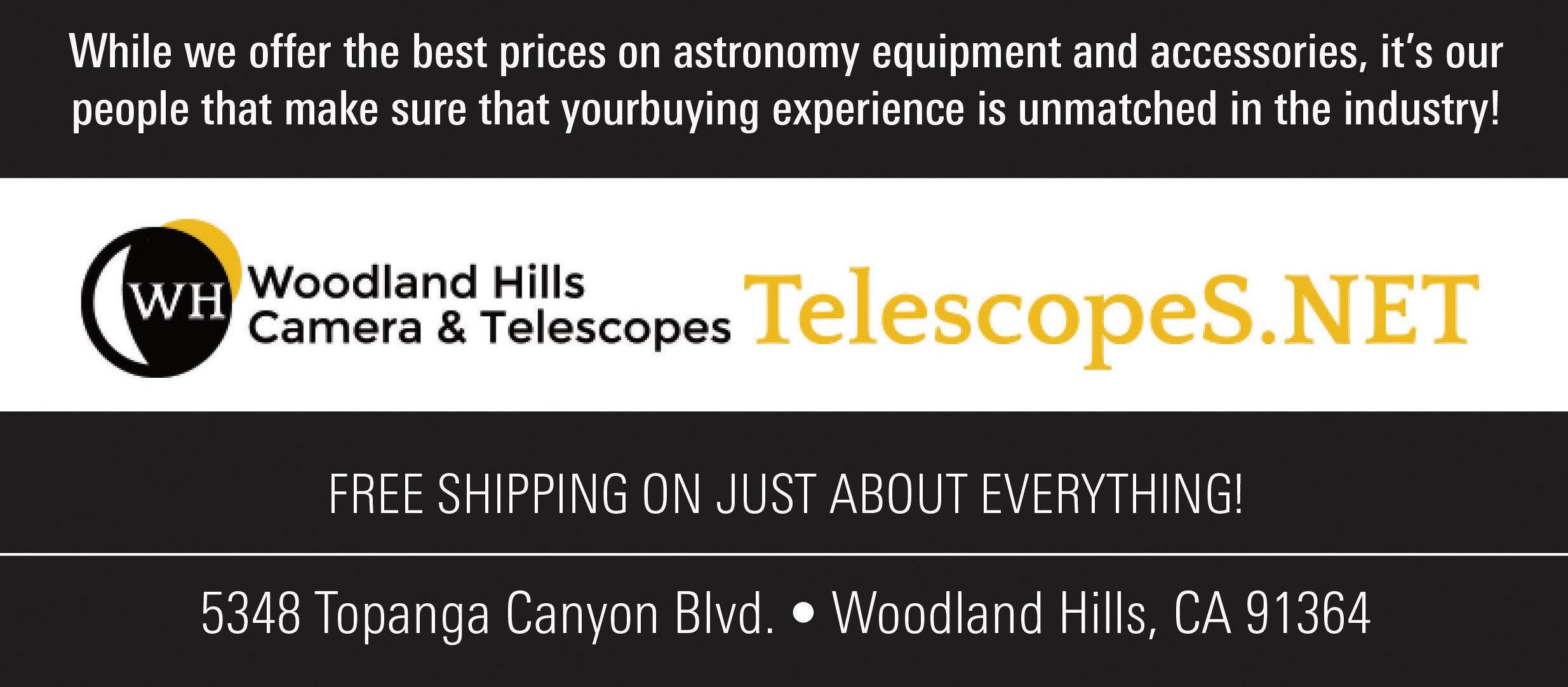

This is happiness when you get the best prices and customer service!
for that kind of expertise he needed to find a professional programmer with experience writing software for smartphones. After securing one, Duncan says the two spent about six months developing an app.
With a workable model in hand, Duncan field tested it in December 2020 during a partial eclipse viewable in Maine.
“I hopped on a plane and went to Maine I sat in the driveway of some farmer’s house and took pictures of the partial eclipse, and it worked great, ” he says.
Duncan next recruited 100 people to beta test the special smartphone lenses and software over a period of weeks and incorporated some useful suggestions into a final
product, which he dubbed the Solar Snap. His beta testers were universally impressed with how easy the lens and software app were to use, he adds.
To mass produce the special eclipseviewing lenses for smartphones, Duncan teamed up with Bartlett, Tennessee-based American Paper Optics, which he says is one of only two U S -based companies that make paper glasses for viewing solar eclipses and which has produced hundreds of thousands of such glasses through the years, according to the company ’ s website.
“American Paper Products was wonderful to work with in the development process. They have a guy who does their graphics, and he made the Solar Snap look great and the packaging look really snappy Solar Snap is now finished and on the market, and I’m really pleased ”
Duncan says the Solar Snap is sold as a kit that includes two sets of special eclipseviewing lenses for smartphones, two sets of paper eclipse-viewing glasses and instructions for downloading the software to make two cameras capable of taking eclipse photos.
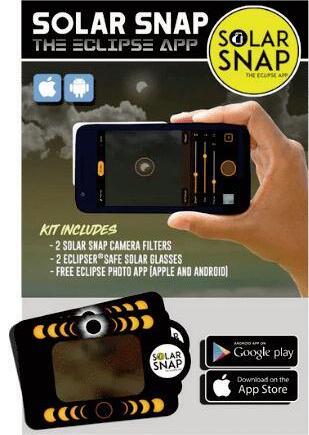
American Paper Optics is selling the Solar Snap kits on its website and has agreements with major retailers to sell the company ’ s many products, according to Duncan
The timing for the development of the Solar Snap seems fortuitus, given that the next partial eclipse in North America will happen on Oct. 13, and the next full solar eclipse in North America will occur April 8, 2024.
Perhaps not surprisingly, Duncan already has a group trip planned to Texas for the full eclipse, which he is calling “Totality Over Texas ” The website for the trip can be found at https://na eventscloud com/website/20793/
Says Duncan, “I think people will want to check out the partial eclipse this year and the really big one next year, because the next total eclipse after that in North America is not until 2045.”
84 Solar Technology Today SOLAR SNAP
Image 3 - The Solar Snap Kit
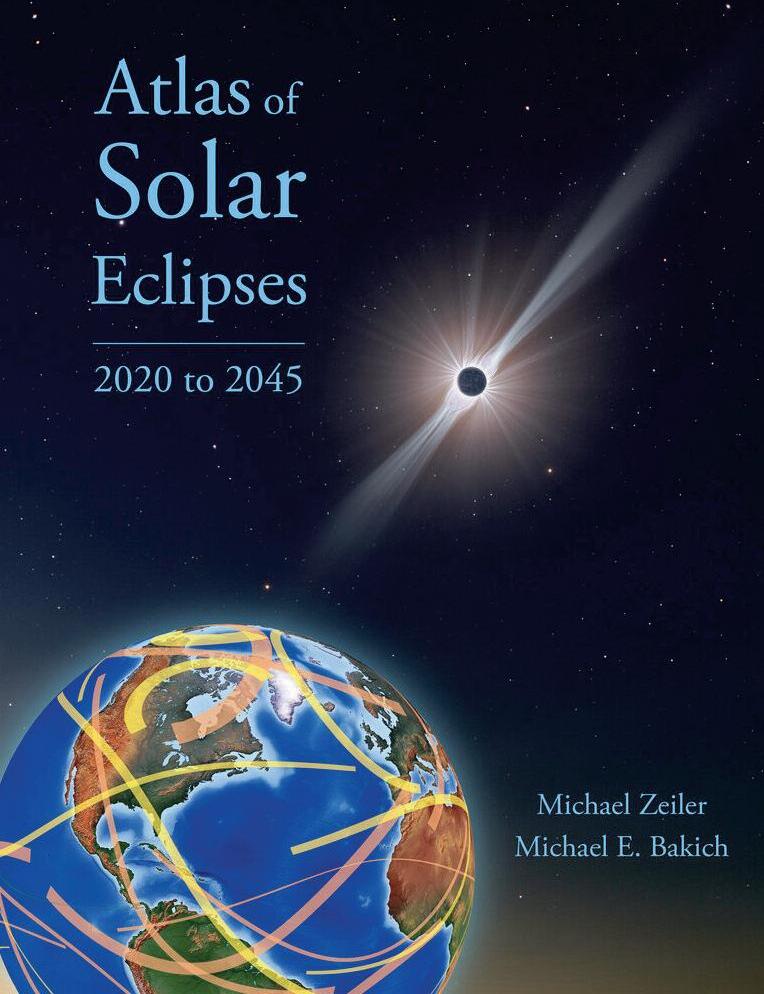
www.greatamericaneclipse.com


































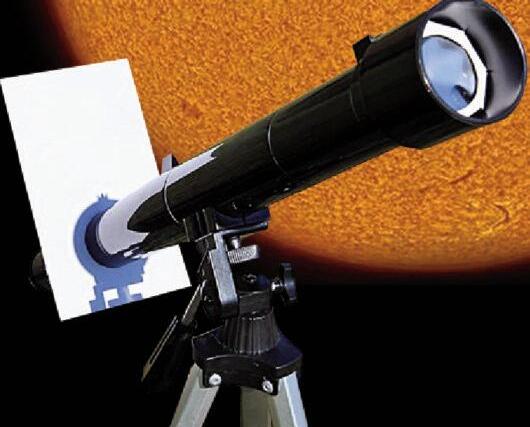

















Your Complete Guide to Solar Astronomy Equipment Suite 45322, 4727 E. Bell Rd. Phoenix, AZ 85032 PRST STD U S Postage PAID Dallas, TX Permit No 1767 Volume 1 Issue 1 $6.00 US GALILEOSCOPE KITS WITH SOLAR FILTERS INDUSTRY NEWS • PRODUCT NEWS • ASTRO HUTECH HINODE SOLAR GUIDER SOLAR SNAP SMART PHONE IMAGER • AIRYLAB SOLAR SCINTILLATION MONITOR Your Complete Guide to Solar Astronomy Equipment DO YOU HAVE AN ARTICLE IDEA FOR US? IF SO, EMAIL US AT info@solarastronomytoday.com www.solarastronomytoday.com




















 by Douglas Arion, PhD
by Douglas Arion, PhD
























 Stuart Parkerson
Art Director
Lance Palmer Web Master
Stuart Parkerson
Art Director
Lance Palmer Web Master
















































































































































































 and Heaters
Dew Controlle Filters Solar s Dust C ers Covers Foccusing Aids
Shields
and Heaters
Dew Controlle Filters Solar s Dust C ers Covers Foccusing Aids
Shields




















































































 By Douglas Arion, PhD
By Douglas Arion, PhD























































































































































































































































